#i know it's influenced the course of her design and like character arc somewhat
Explore tagged Tumblr posts
Text
Well, it's about that time again...and I've felt terribly unmotivated in my creative endeavors lately. I mean, I've been struggling physically and mentally, and a lot of things have sort of fallen by the wayside as I pour everything I've got into my work shifts, because I have to...so of course something as complex as writing would suffer. But I've been starting to feel like I'm getting out of it, too, so it feels easier to look at and look across and whatever. As much as I love writing, it can be difficult to find the motivation to continue when people aren't reading it--not even in a "oh gimme views" kinda way, but, like, despite how folks frequently talk shit broadly about "audiences" or subdivisions thereof like "focus groups"...I dunno, I have faith that exposing my stories to the opinions of others will help me make a better story. Even when it's something as simple as hearing your friends resonate live in chorus over a specific trait of your character, it's like...bullseye...! I've made these characters, these stories, and I like them...and overall, I hope other people like them too. Sometimes it's more about the escapism, sometimes it's more about delivering a theme, sometimes it's just about creating the wildest personalities I can imagine and then smashing them into each other, but I guess I hope overall that if you check out my stuff, you like what you see somehow. And even if you don't, any insight into how this crazy multiverse of mine looks from the outside is still helpful. I mean, even just forming something like a drawing or a novel is helpful, a formation of my primordial ideas into something a little less abstract, which itself forces me to refine those ideas as I work with them. That's cool too, but it's hard to run on that by itself. Outside perspectives can give me a lot more to work with. Sometimes they perceive things in ways I truly don't anticipate, which is wonderful. That gives me a whole new dimension by which to build my characters, my stories, my craft.
Anyway, that's quite a bit of rambling, and I'm not gonna be able to write tonight anyway because my ex-roommate is coming over. Have a great day, everyone! Love you! 👋💕
#workday sendoff#honestly i had one reviewer who related to alyce's life in the fox and the thief--from his own experiences as a closeted gay guy#and i think my knowing someone out there sees alyce in that way has made her character better#i know it's influenced the course of her design and like character arc somewhat#there are eyes on her--both in-universe and out--so she strives to be a good role model even when it's difficult#and she serves her local school district at a policy-making level in the days after the fox and the thief#she's sort of had celebrity and stewardship and responsibility thrust on her by the plot and by the meta-narrative and now by reader review#but alyce is willing and able to accept these burdens
0 notes
Text
While waiting for me to finally finish the next chapter..
DESIGN ANALYSIS FOR MY VIGILANTE AU >:D

As always, let's start in rainbow order! But first things first; all CG members have matching eyes, in one way or another! Red has yellow eyes, Orange has green eyes, Yellow has orange eyes, Green has blue eyes, and Blue has red eyes!! I might change things depending on how it looks, though.
Anyway, Red!!
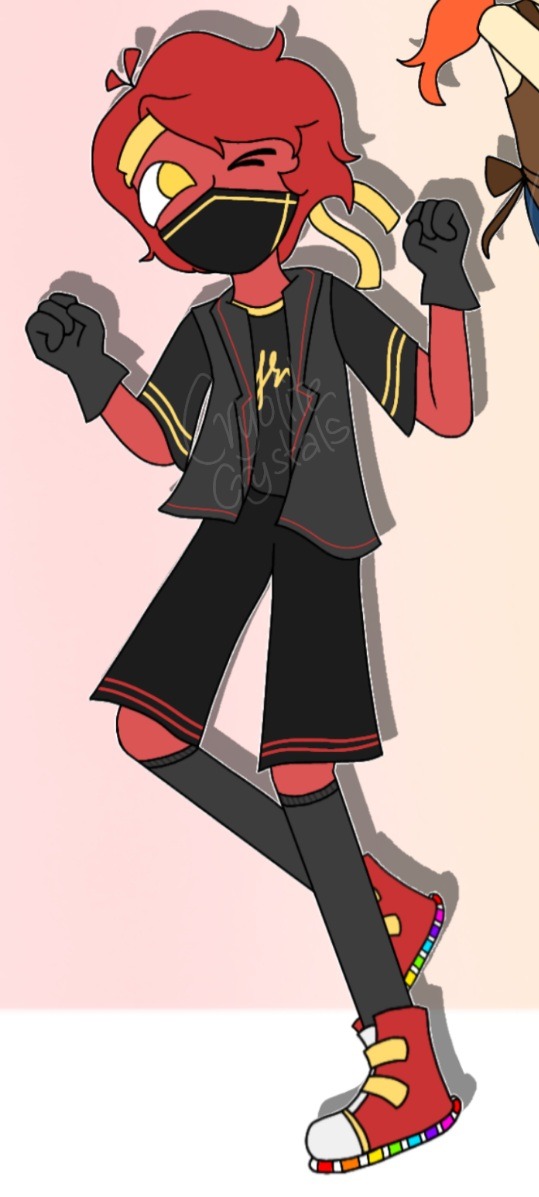
I'll admit, I'm definitely giving him a design upgrade, but let's talk about this one.
Ah, the classic yellow bandanna. How could I leave it out? It's iconic!
His hair is definitely the wildest out of everyone's. A lot of black and grey in his design, too, which makes the yellow bits and the light-up shoes REALLY stand out.
The yellow matches his eyes and bandanna, and is reminiscent of that media trope with seeing yellow eyes peek from the darkness. The mask is, of course, to hide his face. Red didn't really seem like the guy to wear a visor like Green, or cover his entire face like Blue, so he gets that mask! Might change that, who knows.
His outfit looks thrown together with not that amount of effort. Very casual, as Green pointed out. Before Orange, he was the latest addition to the team, which can mean he can be a bit inexperienced. Wanted to convey that somehow!
Light-up shoes, oh, light-up shoes... who doesn't love them? Green certainly doesn't, but Red disagrees!
Next one!


Orange/Sketch
Now, I didn't draw their vigilante outfit yet, but I added the description of it to give an idea!
I wanted her hair to give a very anime-protagonist feel, if that made sense? Not sure if I got that right but it works for me! And hey! Freckles!
Working clothes: His pants are covered in paint to give an artist-like feel. (I should know. I paint a lot and some of my clothes did NOT survive the process.) As for the top and apron, I wanted it to feel like an actual café worker's uniform without it being a basic starbucks rip-off.
Vigilante outfit: VERY reminiscent of outfits animated characters would wear in scenes where they're doing some graffiti on the streets. That was my main inspiration behind the design.
Also in dark colors. They have to blend into the darkness and stuff!
The pouch mentioned was for practical sake; as is something I like to do when thinking of designs. And it helps with the artistic urge to draw at any time, regardless of what the situation is.
Not much to say about Orange's design, besides the fact that I wanted to give it a very protagonist-y vibe.


Yellow/Y
The second design is more or less his actual vigilante outfit, buuuut yeah!
Curly hair -despite my inability to draw it- and Yellow has been a favorite hc of mine!
His outfit is somewhat inspired by steampunk? Not exactly, but I DID have steampunk in mind while making it! The pilot's jacket was the best change yet.
Someone on a03 has told me that he looks like Alan, somehow! I'm not sure if I see it, so does anyone else see it? It would be a funny coincidence if so!
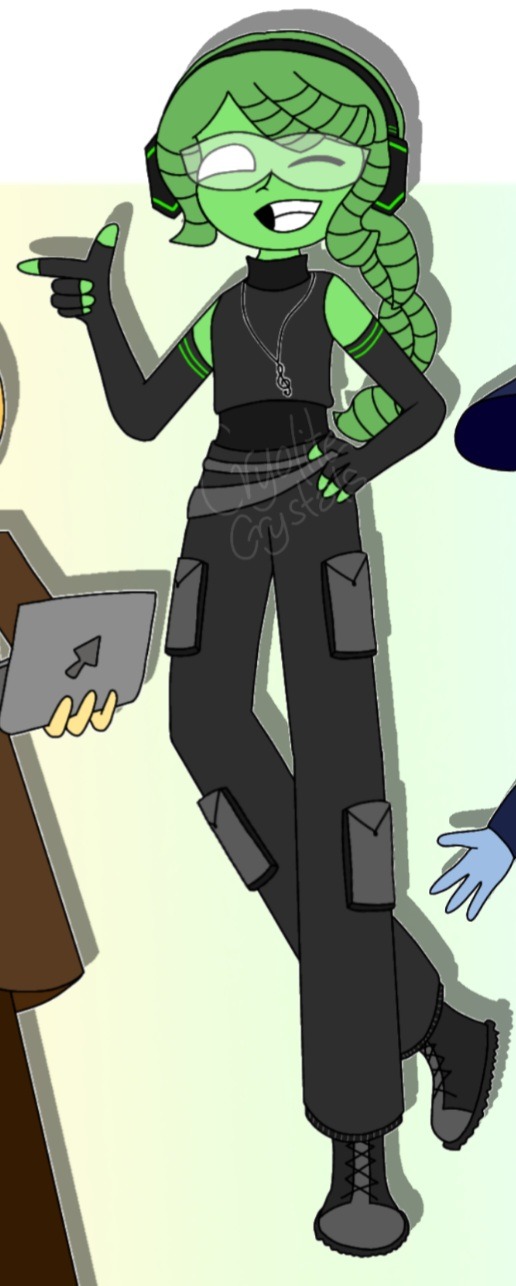
Green/Songbird
His hair is my favorite part of my Green design so I HAD to keep it! The classic headphones are there with a gamer-ish colour scheme.
VERY hip-hop and streetdance inspired! His visor is a reference to the sunglasses Orange gave him in the "More Faces" short, rather than his sunglasses in the Influencer Arc.
His clothes are a reference to the clothes I see my sister wear for her own dance training, and I love streetwear in general, so its a perfect fit! The necklace is just for show, though. Nothing practical about that, but it does look cool! Plus, it's a notion to his powers! His outfit is practical, but still shows off somehow, just like Green!
My vigilante!Green is the most experienced in the group, so I wanted him to look that way, somehow? And he definitely looks the most professional! I think!
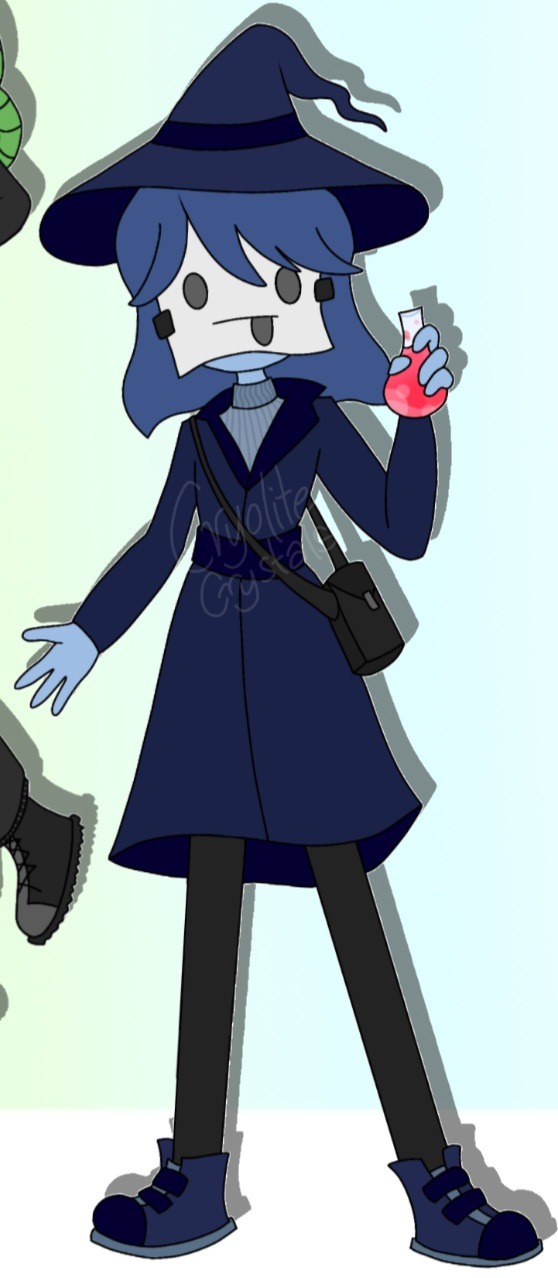
Blue/The Witch
The second member to join the vigilante team!
I HAD to give her a hat. The witch's hat is a must. Practical? Not exactly. Cool? Yes, indeed.
The mask is my favorite part. A direct reference to the "Faces" short, AND a good way for Blue to, ahem, mask her identity (hehe a pun)
The sweater and coat combination seems strange, but it looks a little like a modern witch outfit? Trenchcoats definitely give a vigilante vibe in a way, and Yellow already had one, so Blue gets a belt and a sweater to go with it!
Blue definitely needed a bag for her potions. She can't just make them on the spot!- well, she can, but it would still be a hassle! She'd be the most practical when it comes to her clothing for vigilantism, after Yellow.
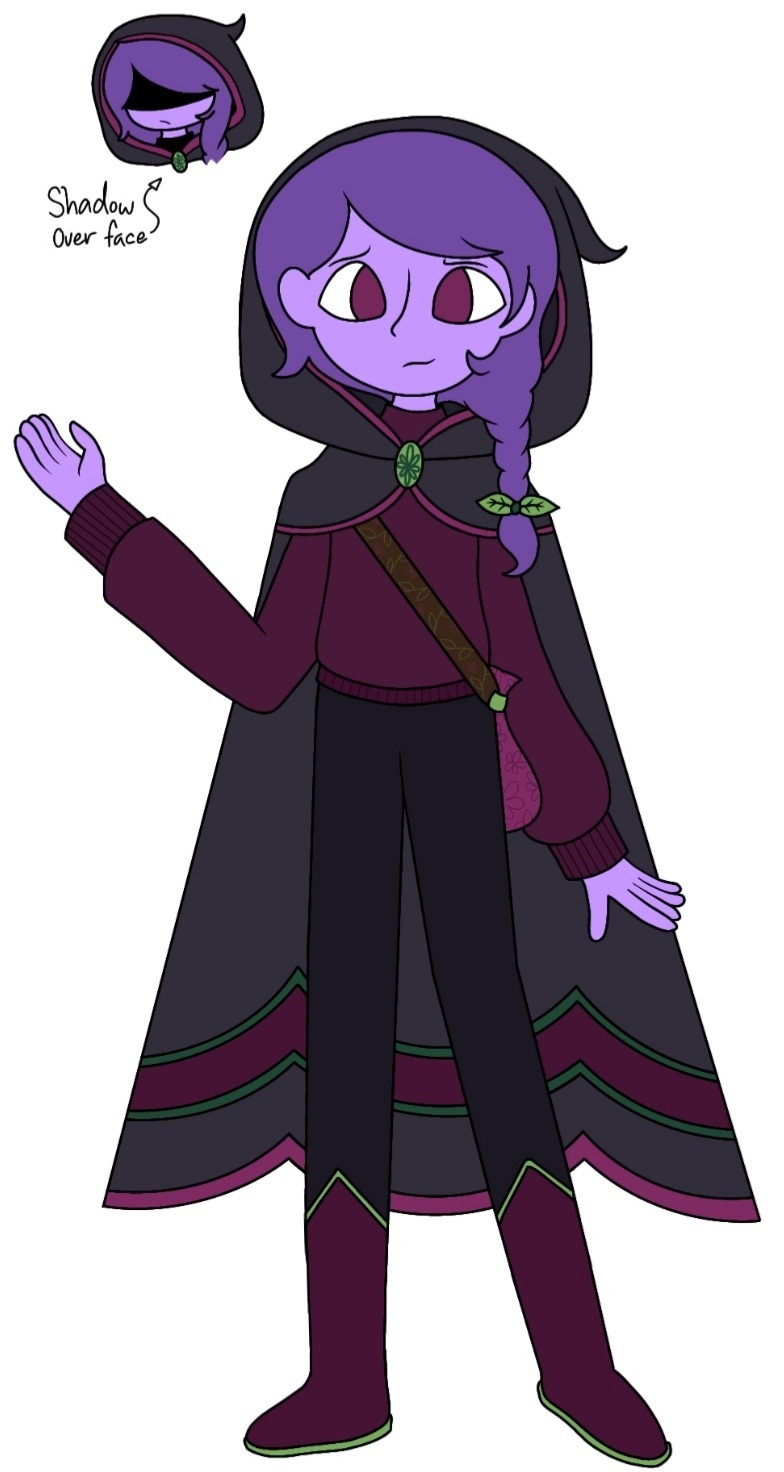
Purple/Aeolus!
Obviously, the cloak is a reference to elytra. The green hairtie, the bag and the cloak buckle is a reference to their mother, Orchid. You can see the vines on the bag strap, the flowers on the bag and buckle, and the leaf-shape on the hairtie.
There's also a lot of green on them, wink wink ;3
To hide their identity, they cover a majority of their face with the cloak hood!
It was hard to balance the colors, but I'm happy with the results! This one is simple compared to the others, but its still cool nonetheless!
Purple was meant to have ripped jeans but my drawing ability to low, so... sorry, Purple.
AAAAND THAT'S ALL! Sorry if this seemed boring or disappointing, or whatnot. I tried my best!
#avm#animation vs minecraft#avm green#avm purple#avm blue#avm red#avm yellow#avm orange#alan becker#crystalizedcryolite#ogtdwv#orange's guide to dealing with vigilantes#the colour gang's guide to heroism vigilantism and villainy#the color gangs guide to heroism vigilantism and villainy#avm au#TCGGTHVV#dang that's a lot of tags
60 notes
·
View notes
Text
chase davenport character analysis i wrote four years ago that i just rediscovered
Chase’s main conflict throughout this entire show is proving his worth and value to himself and to his family. From the very beginning, Chase is portrayed as rigid and uptight, a rule follower. It usually takes the others a little bit to convince him to bend or break the rules outright due to his rational mindset. In the few instances he does break the rules with his siblings, he finds it exhilarating, calling himself a “bad boy” after sneaking in past curfew in one episode. One of Chase’s main things is his mission leader status. According to himself, he was only twelve when he named himself mission leader. From this point forward, that was how he identified himself, and revolved his whole personality around it. Multiple times throughout the show, he is shown to be somewhat of a control freak, and “fun-killer”. He feels somewhat of a personal responsibility to act responsible and mature compared to his siblings. As a result, they often tease him for his intelligence and other shortcomings (no pun intended hehe).
Adam is usually the main person to make fun of Chase, teasing him for his height and intelligence, and often punching and throwing him around. Chase doesn’t have super strength, so he finds it difficult to get even with Adam. This was touched briefly on in “Brother Battle” when they get new abilities and have an epic fight in the lab. Chase is tired of always being subjected to Adam’s taunting and bullying, so he takes matters in his own hands. After that episode however, they resolve to respect each other more, although this is somewhat short lived. I find it interesting because in some episodes, Adam will tease Chase and he’ll get mad because he can’t respond to his insults, and in other ones, Chase will just smile and make fun of Adam’s lack of intelligence, the dynamic never stays the same. Bree and Chase seem to get along better, but they still have their fights. One of the main things they fought about was in that one episode when Bree got a job at Tech Town to feel normal, but Chase walked in and got a job too after impressing Scott with his wide-spread tech knowledge. The conclusion they both came to at the end of the episode was they both desperately needed it. Bree needed to have one normal thing in her life besides her bionics and missions, and Chase needed to have his wealth of knowledge and influence appreciated, since he was always mocked at home.
I guess what I’m trying to sum up is that the majority of conflicts that Chase is involved in throughout the course of this show is his need to feel confident and secure about his value and worth. He is constantly shown competing with people in his life: the student of the semester contest, the designing of the space elevator, the baby project for health class, the talent show, the whole avalanche mission, etc. In fact, one of the main episodes where this arc is shown is in “Avalanche”. They get home from a mission, and Adam and Bree are praised for their flashy abilities while Chase is underappreciated and told he’s “flash glue.” They’re sent on a mission to find a certain property in the arctic to power a device, until a storm shows up on the map. Donald specifically tells the trio not to go on the mission due a storm in the arctic. Chase, wanting to prove his value, goes anyway and is stranded after he’s buried by an avalanche. Luckily, Chase is rescued by Douglas, and manages to trick him into going to the lab, where Douglas is captured.
In my opinion, Chase’s main defense mechanism is what's known as reaction formation. He appears as self-absorbed and brash at certain points, bragging about his intelligence to anyone who will listen, and appearing as cocky and confident, putting other people down for not knowing the obvious. However, I honestly think he’s compensating and trying to appear more confident that he actually feels, like he’s terrified someone will call him out. As a result, he overly gloats to the point where he appears egotistical, when really he doesn’t think he’s good enough.
Continued in part two.
#chase davenport#bree davenport#adam davenport#leo dooley#lab rats#lab rats fandom#lab rats elite force#lab rats disney xd#lab rats bionic island#donald davenport#elite force
10 notes
·
View notes
Text
so I was doing some research after watching movie 6...
...and apparently it was originally written as a comedy

Yeah, I was surprised, too
Baron Omatsuri is not my favorite One Piece movie—Film Z has too many of my favorite tropes to be usurped from that position—but I do think it is the most daring. Of all the supplemental material I’ve seen and read, it feels the least...One Piece-ish.
Yes, that includes the noodle commercials.
If you haven’t seen the movie and can stomach a little spookiness, do yourself a favor and give it a watch. Unlike movies like Strong World or Z that have the look and feel of a manga arc, Movie 6 transplants the Straw Hat Pirates into a world that doesn’t feel like a One Piece story, taking risks and exploring themes that would never fit in the manga proper.
In addition to the obvious changes in art and animation style, there are supernatural elements that don’t make sense within the One Piece world. None of the Straw Hats win a fight—Luffy included, although he is heavily implied to have killed the big bad at the end. The moral of the movie, if it can be said to have a moral, is if you lose the people closest to you, the answer is to forget about them and make new friends. The story ends with many questions left unanswered and the main drama between the crew unresolved.
And, if you allow me to get philosophical for a moment, I wish there were more movies like it. As I wrote in my review of Novel A, I don’t go to supplemental material or side stories looking for a repeat of what’s in the manga. Oda has written 1000 chapters of One Piece—why not spice things up a little and try something different for a change?
I know the answer isn’t that simple, and by their very nature not all risks will pan out. There will be people who don’t like this movie because it’s different, both in look and tone. But there’s something to be said about a creator putting their heart and soul into a work and having it show in the final product.
Which brings us back to the original premise. How does a movie go from a light-hearted comedy based on a variety show theme to...this
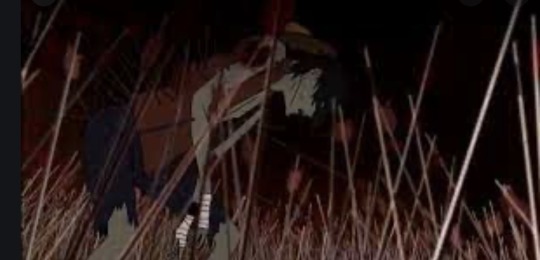
Baron Omatsuri was directed by Mamoru Hosoda and came out in 2005. To put that into perspective, the movie was in production when the Luffy vs Usopp fight was first seen in the manga. Manga!Luffy had not yet faced the challenge of an inter-crew disputes when the story was being written and boarded, nor did the creative team have the events of Sabaody and Marineford to see how Luffy would react to the loss of his loved ones. They were working without a full understanding of Luffy’s character, and to a lessor extent the character of the Straw Hat Pirates, and it seems like Oda was much less involved In production than has been in movies since Strong World and beyond.
Likewise, Hosoda had just left a tumultuous situation at Studio Ghibli while working on Howl’s Moving Castle, and if this interview is anything to go by (https://instrangeaeonsblog.wordpress.com/2016/04/24/mamoru-hosoda-on-omatsuri-danshaku-animestyle-interview-part-1/) was going through a lot of personal shit when he was brought on as director. The script he was given was originally written like a variety show—something that was carried over into the various trials seen in the final movie—and meant to be a lighthearted affair after the relatively serious Movie 5 (which I have not seen am thus unable to compare tone).
With that backstory in mind, it’s easy to see how the bickering and backbiting between the Straw Hats early in the movie is a metaphor for Hosoda’s time at Ghibli, which is something he admits to in the interview. Movie 6 feels different than any other One Piece movie because it’s the project of a man who has had to endure the loss of those who he was close with, at least in a professional capacity.
There are moments in Movie 6 where Luffy doesn’t feel like Luffy. More than once a member of the Straw Hats ask him to intervene during arguments, moments Luffy either ignores or doesn’t notice. It’s a version of Water 7 where instead of fighting Usopp, Luffy ignores the underlying differences within his crew, and as a result loses everybody.
The structure of the three trials follows a clear path of deterioration within the crew, the initial goldfish scooping game showing the Straw Hats at their best and inciting the jealousy of the Baron, the ring toss sowing discord among the crew even as they snatch a narrow victory, only for them to be utterly crushed in the third and final challenge as they’re unable help one another survive.
It is somewhat implied that the Breaking of the Fellowship(TM) is magical in nature—that like the One Ring, the Lily Carnation was able to influence the Straw Hat’s thoughts and actions, but this is never stated outright and I prefer the more mundane interpretation: That without strong leadership the Straw Hats fell victim to the manipulative machinations of the Baron, and simply self-destructed as a result. In the end, it’s up to the interpretation of the viewer.
And speaking of things up to interpretation, I love how the Lily Carnation isn’t explained in the slightest. The plant that initially absorbs the Straw Hats looks more like the stem of a devil fruit than a flower, it for some reason rings like a gong when hit, and somehow is able to turn pieces of itself into facsimile of the Baron’s old crew who can somehow move around despite being plans. It’s weird, it’s wonderful, and the element of the unknown works so well in the horror-lite setting.
My personal theory is the island somehow managed to eat a devil fruit which manifests itself as the Lily Carnation (which due to the L/R conflation in Japanese, is pronounced ‘reincarnation’, which I think is a nice touch of foreshadowing that may or may not have been intentional).
(Also, I can’t decide if little chewing animation it makes when it’s eating people or the weird bullseyes it makes when shit gets real are the most terrifying thing in the movie.)

Hmmm, tasty.
Anyway, this is getting long, so here are some final thoughts:
1) This movie has some low key fantastic outfits. The Straw Hats all look very cool without being over designed like a lot of recent movies. Big hat Robin is of course a fave, and makes me really want to see her in a Carmen Sandiego getup.
2) Screenshots do not do the animation of the movie justice. It’s very fluid and has a lot of excellent expressions/poses, although I admit the 3D is jarring at times. Do not let the art put you off if you haven’t seen it
3) Also, I don’t think there’s any shading? Like at all? The movie does a lot of cool stuff with color instead. For example, the scene where Luffy initially loses to the Baron his skin goes all grey, and I thought it was because he was fighting at night, but it stays grey even in the better lighting of the underground tunnels and stays that way until he finds out the Straw Hats are still alive, where it returns to his normal color
4) There’s an extended Benny Hill-type gag when Luffy first chases after the little mustache pirate that’s perfectly timed to the music, and ends when Luffy just uses his power to grab him. The comedic timing is amazing and it’s probably my favorite funny moment in the movie, of which there are several despite the overall darker tone
5) The extended jungle shot from Nami’s POV? Very cool
6) I love how from the earliest scenes nothing is as it seems. The opening text is Robin reading the map, but the storm that’s seen on screen is the one that sank the Baron’s crew. Likewise the whole fancy city is shown to be fake panels early on, the goldfish catching game is a trap, etc., etc. It does a good job clueing the viewer in early that’s something’s very wrong on the island, even if they don’t realize it at first
7) I don’t think this type of movie would work in modern One Piece without somehow nerfing Luffy. Horror works best when the protagonist is weak and vulnerable, and that fits best with a pre-Gear 2/3 Luffy (same with the rest of the crew, tbh. I was waiting for Nami to use her lightning stick during the games, forgetting it hadn’t been boosted yet).
8) I like how there are four captains on the island representing different levels of loss—the Baron has lost his crew and wants to destroy all others because of it, mustache pirate lost his crew and is willing to put it behind him to make new friends, Luffy has freshly lost his crew and hasn’t decided what path he will go, and coward dad hasn’t lost his crew yet but is at risk if he doesn’t change his cowardly ways
9) I think the reason why Chopper was the first Straw Hat to disappear is he’s the most likely to play the part of peacemaker. He’s also the only crew member needing rescuing at the end of the goldfish scoop game, when Luffy foolishly puts his life at risk trying to save him from drowning, just like he recklessly charges the Baron at the end of the movie. Except that time there was no Sanji to save him, leaving Luffy to get his ass thoroughly kicked
10) This is a very good Halloween movie, and I’m glad I watched it in October
321 notes
·
View notes
Text
Digimon Astrology Journey - Independent women: Sora & Mimi
For references, more understanding and background, make sure to read my posts about basic Astrology 101! Part 1 | Part 2.
A fire Sun/Moon placement combined with a strong Taurus placement... Look out for Femme Fatales! They have a natural beauty, are bold, sensual, strong and creative. Sora and Mimi both have all of that, even though they have very different personalities. Most likely because Sora’s Rising placement balances out her Sun and Moon with compassion and caring protectiveness while Mimi’s big three is here to be a princess and to live for the applause whenever she feels like.
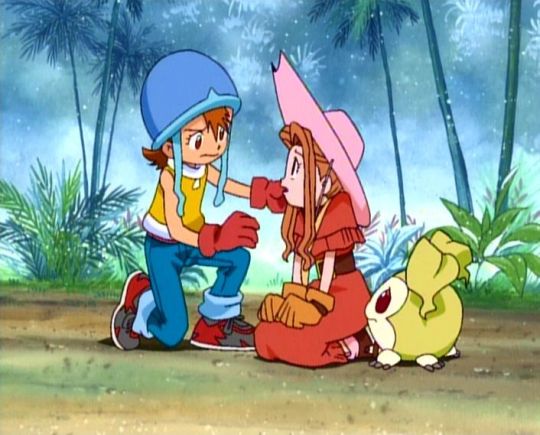
See it like this: Sora takes care with passion, Mimi wants to be passionately taken care for every once in a while.
The important stuff
Sora Takenouchi, March 21st 1988 (around 11AM)
Sun: Aries (fire-cardinal)
Moon: Taurus (earth-fixed)
Rising: Cancer (water-cardinal)
Mimi Tachikawa, July 24th 1989 (around 11.30PM)
Sun: Leo (fire-fixed)
Moon: Aries (fire-cardinal)
Rising: Taurus (earth-fixed)
Charts and analyses under read more!
Beware!: I calculated their birthdays by assigning them a Sun and Moon placement. All of this is NOT CANON! It’s inspired by/based on the canon. I use these analyses and their headcanon birth charts as a reference/character sheet for -as an example- my own fanfiction. Of course be my guest to use these for your own, but remember it’s just someone else’s (in this case it being my) headcanon ;) Some credit, a reblog or a like when used is appreciated.
Sora Takenouchi - March 21st 1988
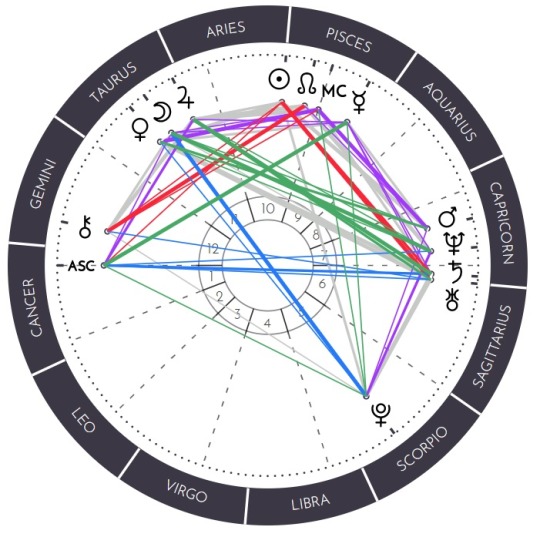
We do know in Our War Game, Taichi gave her that hairpin for her birthday in the Spring break between 5th and 6th grade (for her 12th birthday). Conclusion: she probably has her birthday somewhere between March 20th and April 6th (even when it’s not canon? I once read that her birthday is not canon even though the movie implies her birthday is around that time…). Meaning two things: she is either an Aries Sun or a Pisces Sun. I went for the Aries Sun, because I feel like the Pisces is too ‘dreamy’ for her. Her Sun however is on the thin line between Pisces and Aries (even better: if she was born around midnight on the same day, she would have been a Pisces!). So she is an Aries, but her Aries Sun will probably be highly influenced by Pisces.
An Aries Sun is independent, determined and has a strong physical appearance. These Suns NEED sport or some kind of physical and practical activity to feel good, which in Adventure turns into Sora’s absolute and passionate love for soccer. The determination and independency can be seen in DA episode 26 when she stands up against her mother because of soccer even though her knee is hurt. However, that independency and determination is more often towards or for the sake of others, for example when Sora takes off on her own to secretely help her friends. This probably comes from her Sun placement close to Pisces, making her more compassionate and sensitive than any other Aries Suns. And it’s due to her Rising placement.
Intermezzo: Reboot 2020 Sora is more of an Aries than her original counterpart. I know the character building in the Reboot isn’t that good -or even not existing at all-, but looking through the Astro-glasses, I do see some character. Reboot Sora fits perfectly in this chart!
Sora is a Cancer Rising. Cancer Risings are, even more than the Cancer Suns, protective of others. Cancer Risings tend to see everything or otherwise WANT to see everything. They’re not nosy, they just want to check on you and make sure you’re safe, healthy and happy. This is in fact Sora in a nutshell.
Taking care of others is their priority number one and that’s exactly what Sora does all the time. Cancer is often called the mother of the Zodiac, a title she is given every once in a while. In Tri episode 10 (Confession pt 1) Meiko says “You’re just like a mom”, and Meiko is someone who doesn’t know Sora for that long. Even she sees, feels and experiences it, making Sora a natural mom-like protector.
And even though that motherly role is not something what she wants to achieve, it comes natural to Sora. There are more DigiDestined with Cancer placements, but somehow it’s Sora who they call a mom all the time. Her Aries Sun makes her passionate and determined, while her Cancer Rising makes her care and protect. This Aries-Cancer dynamic gives her a mom-like character you can’t get around.
Sora’s first reaction after Meiko calls her a mom is annoyance and a way of denying and is most likely her Aries-Cancer dynamic. Cancers have a hard shell and they like to keep it that way. Aries can say and feel things before thinking it through. Her face and reaction is a mix of that Cancer’s shell, not wanting to admit she is a mom, and Aries’ impulsiveness, an immediate and bold reaction. (However, it could also be her Moon speaking.)
Cancer Rising makes her sensitive, protective and caring. Place it next to her Aries Sun and she is a bold and independent person with a strong emotional touch. Put her Moon in Taurus next to all of that and she becomes a perceptive human being.
Taurus Moons are highly disciplined, can be somewhat stubborn and crave stability. They like to show others they have everything under control, all the while their bodies extremely react to stress, making Taurus Moons very emotional and (inwardly) reactive people. This could be the explanation why Sora is having such a hard time putting her feelings into words or even doesn’t want to talk about her emotions at all, even when she has these very strong, physical and intuitive feelings and emotions from time to time. So whenever she does have her words ready, she won’t say it, because she thinks about the other first. It’s likely for Sora to bottle everything up and when she can’t hold it any much longer, it will all come out at once.
With her Mars placement in Capricorn -making her ambitious, feel responsible and act thoughtful- on top of it all, she might has the tendency to overwork herself and go into these downward spirals. Especially when she feels -in both her work and private live- like she can not mean anything to others. This is likely due to her MC = Midheaven (career and calling) in Pisces which makes Sora humble and very ambitious in helping others. And here it comes: preferably through sports or art! Maybe that’s why she is suddenly drawn into Ikebana. And I feel like she isn’t an ordinary fashion designer, but someone who wants to help others feel good through her designs.
Also a Taurus Moon can make one very traditional, which is the case with Sora. In Adventure she caves more into standing up against her mother, which is more of the Aries-Taurus dynamic: stubborn and determined. Later on, especially in Kizuna, it turns into working with her mother which could be the Cancer-Taurus dynamic. And When she chooses for herself in Kizuna, she’s fully into her big three, using them all three equally. Well, if that isn’t growing up… No shit she was the first one to lose her partner (which I still think is so sad…).
Mimi Tachikawa - July 24th 1989
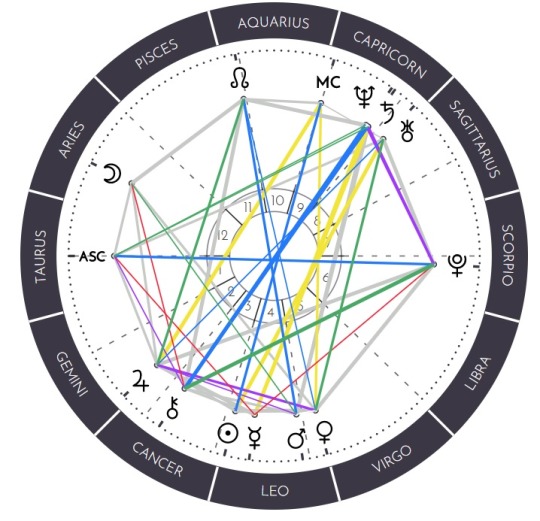
To me, Mimi is WITHOUT A DOUBT a Leo Sun. And also without a doubt a Taurus Rising! Making her a very very very fierce lady. With an extra emphasize on lady. Her Aries Moon makes her even more bold.
As you can see, her Leo Sun placement is on the thin line with Cancer, which means Cancer influences her Leo Sun and makes her more caring towards others whenever it’s needed. But: the Leo Sun is charismatic and can have a big ego. This is pointed out by Koushiro in Tri episode 6 (Determination pt 2). That ego could make Mimi chose for herself and the people that affect her directly in a certain situation first. Her Taurus Rising and Aries Moon will probably emphasize that even more. Let me be clear: that’s not a bad thing! It’s a good thing knowing what you want and need. And Mimi is a good at that! In comparison to Sora, Mimi is way better in letting others know what she really thinks and feels. In that same episode, just a view seconds before Koushiro puts her in her place, she says she is “sick of Palmon and the others being critisized”. Mimi is honest and sincere, of course she has the Crest of Sincerity/Purity!
Leo Suns tend to be bossy, they like to boss around and delegate, something we see Mimi is very good at in the series. When she acts and dresses like a princess in Adventure episode 25, in the second arc of Tri (Determination) with her ‘Daters café’, even in the DA: 2020 reboot twice (episodes 6 and 37). She is a princess and a queen, but let’s not forget she can be an awefully good leader and Mimi is an amazing entrepreneur foremost!
Whatever you think of Leo Suns, they are organized, can be very inspirational, work hard and are very creative. As an entrepreneur myself I can tell that those are the traits you have to possess if you want to make it into the business world. Mimi with her Leo Sun is all up for that! Seeing her starting up her own business in Kizuna is so suiting for her and with this amazing birth chart, it MUST be her calling. Even her Midheaven is in Capricorn, which makes her ambitious, hard working and possibly a tough business woman! She is very practical and needs to immediately act, do stuff.
As for her Taurus Rising, funny thing with this placement is they can have these explosive tantrums, something we could see with Sora too. However, Sora gets angry and passionate after she bottled things up for too long. Mimi on the other hand just passionately rants when she thinks and feels is the right thing to do. Again I refere to the specific moment in Tri, but there are probably a lot more of these moments. Mimi is such a sweet girl, but in the end, she wants it her way and she will get it. She is stubborn, not to listen to any bullshit you have to say. She can be easily bored due to the Leo-Aries dynamic. Though to be clear, she isn’t shallow. Mimi just has a filter for bullshit and won’t budge easily, due to her Mercury in Leo too. However, when you do say something that moves her in whatever kind of way, she will act on that and makes sure it will work for her. This could partially be her Venus in Virgo, making her have the ability to be more critical to and reflective on her own values.
Back to Mimi’s Taurus Rising which wants security just like Sora’s Moon placement, but in case of the Rising placements Mimi finds that security more in materialistic comfort. Mimi likes to possess stuff and things. Clothes, accessories, plants, designer furniture, cute home decoration and more. Flying business class? Definitely her Taurus Rising in combination with her Leo Sun. Her Aries Moon makes her impulsive and that Moon in combination with all of the above makes her buy new things and stuff on impulse. Good thing the girl is rich!
Mimi’s Aries Moon was a placement I had to put some thought in, but I knew she had a fire Moon. In the end, Aries fits the bill. Aries Moons make act quick and impulsive which lead them straight into action. They have a need for independency, which makes Mimi’s Leo Sun more bold and independent. The Leo-Aries dynamic makes Mimi a natural leader, her Taurus-Leo dynamic makes her a sensual leader and her Aries-Taurus dynamic a inspirational leader. She is a leader, she just needs to make sure she doesn’t become too bossy. And she has to pay attention to not let her emotions rule her actions, which is very common with Aries Moons.
Mimi is a badass woman, but let’s not forget she has a soft side too. Again, Mimi’s Leo Sun will likely be influenced by Cancer, making her Leo Sun more protective towards others. Her Moon in her 12th House could imply she needs more alone time than others -and herself included- think. Her Venus in Virgo in her 5th House makes her more devoted and dedicated towards relationships, making her a caring and devoted friend (and lover). We see her devotion towards her own value and others in the Dark Masters arc in Adventure, when she makes a decision based on her own values and what she thinks is important to do. Mimi is not afraid to act and therefore she is beautiful and very strong!
Her Venus in Virgo love-wise could also mean she is held back when it comes to love and relationships. Not because she’s insecure, but because she is picky and very critical when it comes to her partners! Hahaha, can you imagine Mimi breaking things of with someone, because he or she or they doesn’t meet up to her standards? Because I definitely can.
For an end note on both girls: People with a Taurus placement (mainly a Taurus Sun, but I’m using the freedom of intepretation rn) in the Big three are often called ‘natural beauties’. I think that’s very accurate with these two gorgeous anime ladies, don’t you agree??
Also bonus: strong, very caring and loving friendship between these two that can go the distance <3
#DFS Digimon Astrology Journey#Fiery bull girls#Sora Takenouchi#Mimi Tachikawa#Sora#Mimi#Astrology#Digimon#Reference post#Digimon Adventure#Digimon Tri#Digimon Kizuna#Digimon Adventure: 2020#LONG POST.#Digimon headcanons
34 notes
·
View notes
Text
“The 02 characters didn’t get any character development”
Yes, they did.
“But -- “
Yes, they did.
Having had the gift of having rewatched 02 recently, I have to say that it still really, really confuses me how the hell people get this impression. It’s not even “I’m trying to see the best out of this” but that I genuinely do not get it, because as far as I’m able to see it’s pretty much literally right there!! This isn’t even tinfoil hat tier!
But in case you have any doubts, sit down because Shiha’s gonna sit here and write a meta about the 02 kids, and how they are perfectly reasonable characters that developed properly fine over the course of the series.
(All below translations of 02 dialogue are by PositronCannon.)
So the first thing to understand about 02 is that it is fundamentally made with a very different writing approach from Adventure in the first place, and therefore it is not meant to be compared in a one-to-one fashion.
This is a point I’ve said many times over and over, and I think it’s to the point where it shouldn’t even really need official clarification, but I’m just going to go ahead and bring up the words from Director Kakudou himself:
For instance, we had the prior series stick out in terms of its points about “what it means to be oneself”, and for 02 we made it so that you would pay attention to “the relationship between yourself and other people”.
Right, so: 02, by design, does not use Adventure’s character development methodology of “self-awareness”. It is built from the ground up by having its characters and character development predicated on relationships instead of singular characters. This might seem a bit odd on its face, but no man is an island, and, in fact, changing the way you interact with other people and with the world in general does speak a lot about one’s personal growth in its own way. And this also means that if you try to analyze 02 by holding it to Adventure-based standards of “character focus episodes” or the like, you’re already on a losing battle.
This means that character growth in 02 is not presented in a way where it’s up-front and center, but rather something you have to glean over the natural course of the series. We’re working off relationships, so you have to actually pay attention to the natural interactions between the characters or what they say even during “off-hours” -- the focus-episode format used by Adventure doesn’t apply here anymore. And it’s something apparent enough from how “evolution” is a metaphor for “personal growth” in this franchise -- in Adventure it was via the Crests, which meant self-awareness, but 02′s key evolutionary trump card is Jogress, which relies on the strength of relationships.
One thing I have to say in terms of my experience as a 02 fan is that I’ve found I actually appreciated it significantly more as an adult than I did as a kid, and that, in general, a lot of the things to appreciate about 02 are things that you really viscerally feel and understand when you’ve gotten that degree of life experience under your belt. Unfortunately, this is kind of a double-edged sword, too, because it ends up becoming the kind of series that often risks going over the heads of the very audience of children it was supposed to be targeting. It’s got a lot of very nuanced depictions of mental health and the childhood experience that are maddeningly subtle, to the point of possibly going over one’s head or even coming off as illogical without sufficient life experience, or simply just not being as visceral (the entire theme of “parents stroking their own ego with their kids’ achievements” hits the hardest when you’re college age).
So what this means is that 02 doesn’t exactly hand its themes or character development to you on a plate. But it is there, once you actually start looking for it.
Let’s start off by talking about our main core cast of characters. Adventure and 02 prided themselves on the fact that they tried very hard to not be adherent to anime tropes, but rather to portray well-rounded, nuanced characters that felt more like actual kids you might meet at school. So how does the 02 cast fare in not being pigeonholed anime tropes?
Daisuke: Even though official freely admits he has “the most anime-like personality”, it’s hard to say he actually falls that much into the generic shounen archetype. For one, he’s actually shockingly humble and polite in certain situations (he’s consistently polite with his elders, and is very quick to admit his own limitations). Actually, he comes off as a surprisingly friendly and deferential person -- it’s just that he happens to have somewhat of an abrasive exterior, and even then it’s implied heavily in the first half that this stems from a lack of validation and purpose. (He actually “deflates” really easily, so you can’t even say he’s all that arrogant past the surface.) Certainly he’s simple-minded, and kind of an idiot, but his abrasive exterior is actually pretty deceptive.
Miyako: Miyako floats an interesting duality of simultaneously being aggressively feminine and being aggressively un-feminine -- not necessarily in the sense she tries not to be feminine (on the contrary, she absolutely embraces it), but more that she’s also an aggressive, “inelegant” mess in ways atypical for a lead heroine in a shounen show, who are usually either cute or “badass action girls” and not...a mess. Despite that, she is also consistently portrayed as capable of heavy emotional depth and being very genuinely kind and concerned about others, which are not in any way diminished by the fact she happens to be an aggressive mess with a severe case of foot-in-mouth syndrome. It’s an interesting mix of character traits that you don’t see often.
Iori: “Designated young characters” usually fall into the “cute” archetype a la Adventure!Takeru or Tomoki, so it’s interesting that the youngest one is actually the most mature one, and impeccably polite at that (having been raised by a family that emphasizes formal manners and propriety). Even more interestingly, nobody actually treats him like he’s that much younger, and he’s given the weight of respect in a sense that has nothing to do with his age (think about how there are indeed quite a few kids who simply just get along better with older kids). Yet the series doesn’t shy away from his youth, and his overly black-and-white view of morality is portrayed as immaturity in its own way, along with the occasional “slips” in his facade or manners indicating that it’s still something he has to consciously focus on.
Ken: Ken’s development goes without saying (it’s one of the most consistently praised aspects of 02), but it’s also interesting to note the unusual way the series plays his redemption arc. Instead of making him a typical “jerkass anti-hero who learns to get a bit better”, the series completely blindsides you by revealing that Ken is, in fact, a naturally soft-hearted and kind boy, and then plays up the mystery of the severe kinds of trauma that would lead him down that path. And ultimately, even though the cause is revealed to have supernatural influence, the series also makes it clear that it doesn’t matter -- that, whether it was his conscious “fault” or not, he still is responsible for what he did. And on top of that, it also scorns the usual “redemption by sacrifice” mentality by pointing out that it’s a cop-out -- it doesn’t actually solve the problems that were caused, and, in fact, a much better way to make up for things is to fix them going forward.
Takeru: Takeru had the “designated young character” role in Adventure, and it turns out that once one of those gets a few years older, they’re naturally not going to be nearly as pure and innocent! The “sweet child” from Adventure has now grown into having slightly pettier emotions, even to the point of grudge, and things he won’t let go of. Oh, and also, trauma from three years prior is still going to have impact on an eleven-year-old kid. Who would have thought.
Hikari: Adventure’s most infamously inscrutable character also seems to have gained some individualized, not-quite-innocent traits of her own (observe how she deals with Daisuke’s advances), and, moreover, it turns out that her deferential humility and refusal to open up about her problems is...not a good thing! when it starts to actually bite her in the rear in front of her friends. Yeah, it turns out that being the “quiet cute girl” actually has its own mental health drawbacks. Oops.
We’re doing pretty well, actually! At the very least, they certainly feel like they already have the Adventure/02 brand of character nuance, where their personalities are inherently varied and nuanced enough that you may not quite find characters like them elsewhere. On top of that, we definitely get to see what makes these characters “tick” -- we get a lot of depth into their thought processes and what their likes and dislikes or strengths and weaknesses are, and that’s something 02 still completely beats out a lot of other kids’ shows or even certain other Digimon entries with.
But here we’re talking about character development. So what do we know about them at the very beginning of the series?
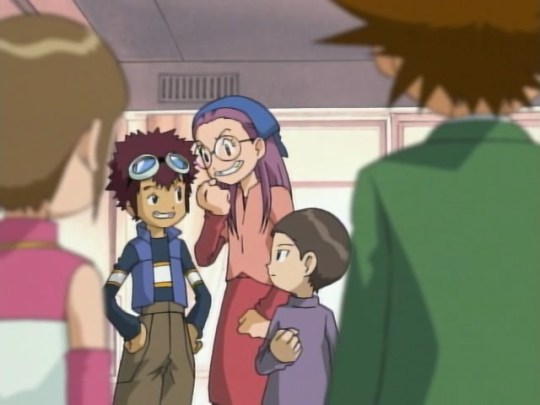
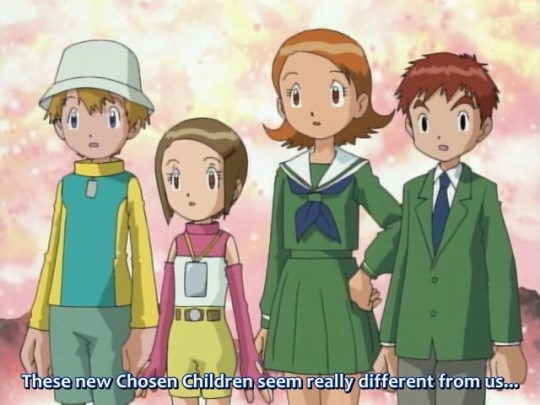
Having watched 02 in Japanese a few times and being very used to the core cast’s latter-half characterizations, rewatching the early episodes always strikes me really hard in the face with genuine shock at how shallow the kids -- especially Daisuke and Miyako -- start the series off as. It’s understandable in terms of the context of the series -- unlike the Adventure kids, who were thrown into a “survival, need to get home” situation off the bat and thus already understood the need to be wary, these kids started off having comparatively easy access to home at any time, and didn’t have a constant sense of danger and survival looming over their heads. It naturally took a lot of time for the gravity of the situation they were in to start really hitting them, and so even the relatively straight-laced Iori didn’t exactly take it all that seriously at the beginning.
Yet while it took them a significantly more delayed time to understand what they were dealing with and take it as seriously as they needed to...they started cultivating something else in the meantime.
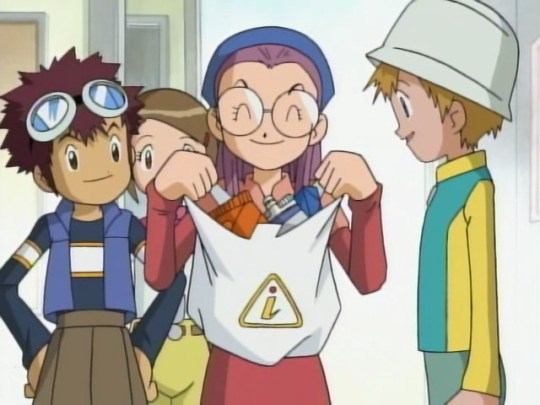
02′s first half is especially full of “random banter conversations” that seemingly involve nothing in particular, but, in fact, that’s actually part of the point. One thing I have always been quick to point out in regards to 02 is that it is rather unique among Digimon series in how it goes out of its way to portray its core cast as having become friends even in pure daily-life social friend terms, even if it had absolutely nothing to do with Digimon incidents -- these are kids who genuinely enjoy each other’s company even in the most mundane of situations. This was something that wasn’t the case for the original Adventure kids -- having been a group of kids thrown together by necessity, even though they most certainly kept in touch and trusted each other as fellow Chosen Children deeply, they started floating back into their own different social clusters after the events of 1999. Relationships are multifaceted, after all; you can still have a deep relationship and bond without necessarily being friends on a social level.
But already, off the bat, Miyako brings food for her new best friends, and it’s implied that she’s the main ringleader behind holding the picnic -- a picnic that started off having no intended relation to the Digital World territory war -- in episode 6. And, to be quite honest, can you really blame these kids? Even the Adventure kids wistfully entertained the idea of a long-term fun adventure through the Digital World in Adventure episode 54, wanting to enjoy its beauty and fun in a situation where they weren’t constantly running for their lives. Now that this luxury is actually available, why not take advantage of it -- and bond further with the others in the process? And for the rest of the year, these kids actively end up spending mundane conversations together and bonding to the point that, by the time we get to the end of 02, these kids have just genuinely bonded so much that they really come off as a cohesive, inseparable unit that would actively choose to spend time with each other if given the opportunity. In fact, even going through all of the TV Digimon series that exist as of this writing, I would say Appmon is the only one that really competes with 02 in portraying its core cast in this manner.
Again, remember: this is a series where characterization is dependent on how the kids treat others and interact with them, so you do actually have to pay close attention to these interactions and see how they change over the course of the series.
So once the episodes start coming in play, we actually learn a lot more about what happens when the characters start breaking away from their shallowness. For instance, episode 8, one of the first key episodes to understanding Daisuke’s character:
Daisuke: He'll be a great opponent. We didn't face off in the last tournament. Takeru: If you had made it to the finals, you would have, right? Daisuke: Don't remind me... Hikari: Can you win? Daisuke: It's not about winning or losing. Right now, all of the boys who play soccer in this country want to be like him. Just thinking about playing against him makes me excited!
For all Daisuke initially seems to be arrogant, he’s actually not that incapable of humility. Far from it, actually; he does have a genuine love for soccer and the spirit of the game, and, when completely and obviously unmatched, fully admits he has no chance and is set on enjoying the most he can out of it anyway. I feel like Daisuke’s surface-abrasive attitude really does throw off the fact that he’s a lot more genuinely humble than he’s given credit for. In the end, he’s satisfied enough with the accomplishment of pulling off one sliding tackle against Ken, and is able to enjoy that -- a foreshadowing of how the latter half relies so much on the fact that he’s capable of enjoying simple pleasures and being straightforward about them.
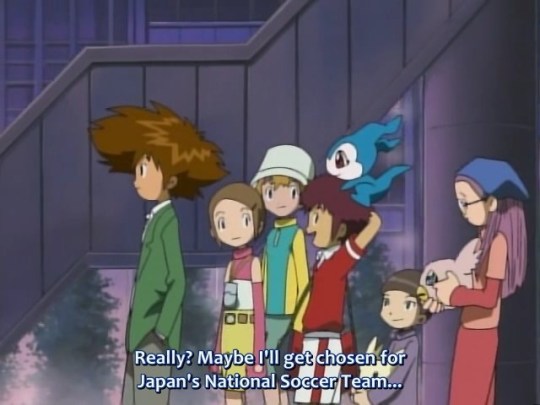
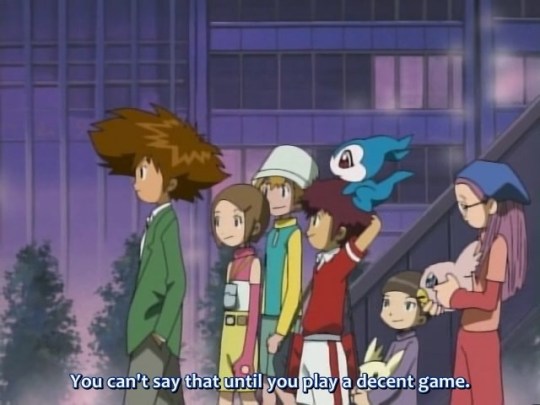
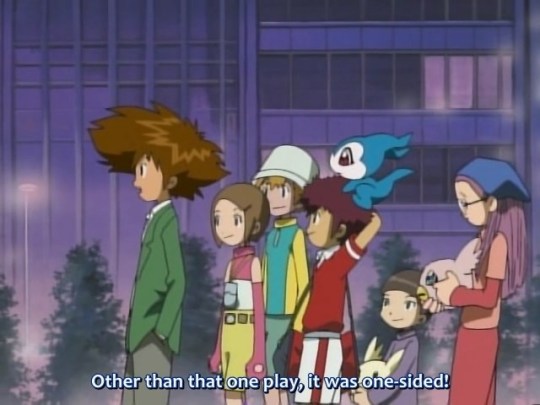
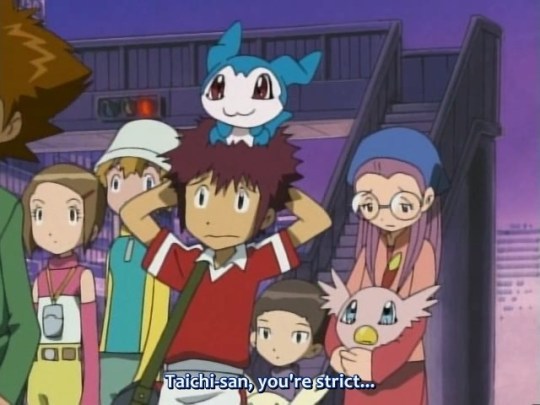
I find that this scene is really underappreciated, too (mainly because it gets lost in all of the other major things in this episode) -- while Daisuke jokes about his accomplishment, it only takes a single comment from his respected senior Taichi to shut him down.
There’s a huge reason I constantly emphasize that Daisuke respects his elders -- this part tends to get lost in translation a lot (especially the American English dub, which just smashed this aspect out of him wholesale, among other things) due to it being a bit reliant on Asian senior deference and cultural propriety, but Daisuke is respectful not only out of societal obligation but also because he genuinely respects his elders! The way he looks up to Taichi and chases after his approval is genuine, and even his interactions with the other Adventure kids have a major hint of him having genuine respect and deference to them. Daisuke is just a deferential person in general -- note that while his crush on Hikari tends to manifest when he’s at his most shallow, he’s actually the one putting Hikari on a pedestal (considering it his own responsibility to impress her), so he’s not actually as assertive as he tries to come off as. The first half of 02 arguably has him deflating more often than he actually stands his ground...and this is a trait of him that starts to actually change quite a bit over the course of the series.
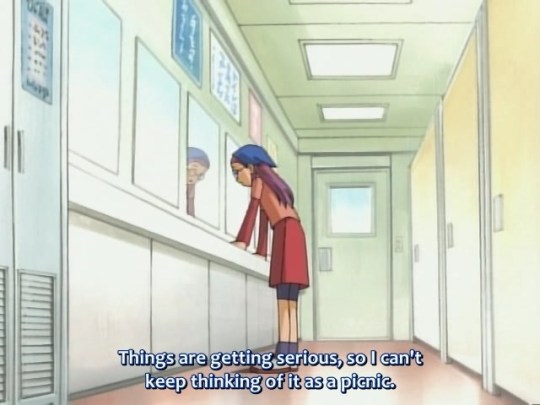
Miyako comes to terms with the fact that maybe she’d been taking this whole Digital World adventure thing too lightly in episode 10, indicating that she actually does have a good sense of priorities when they become increasingly clear! This is actually very important, because it fleshes her out as someone who’s emotionally sensitive -- too emotionally sensitive, to the point that “emotional sensitivity” is just as much of a driving point behind her later breakdown in episode 18, this time from taking her duties too seriously. Miyako is a very id-driven person, and so a lot of the early series is her struggling to find a proper balance on how to adjust her emotions in an increasingly escalating situation. Her heart is in the right place, she’s just not someone with an inherent sense of preparedness to deal with this kind of problem.
We get into the secondary Digimental arc, and there’s a noticeable consistent thread that all of them involve admission of personal faults. This is something that tends to throw people off at times -- wait, having bad traits about yourself is what awards you? -- but the point is that this isn’t like Adventure’s Crests, where things came from proof of exercising the virtue, but rather admitting that there are ways you need to improve, and showing a will to improve in that manner. In the end, people are not perfect human beings, and sometimes even understanding that you’re deficient is half the battle -- after all, the second half is all about a certain character named Ichijouji Ken coming to terms with some very, very serious personal problems.
In episode 11, Daisuke completely admits that he doesn’t feel he understands the concept of friendship the way Taichi and Yamato et al. see it, also latently admitting that he doesn’t see himself as worthy of the Digimental of Friendship. Beyond betraying a lot deeper issues within Daisuke that he seems to have actually had a background lacking in friends and sources of validation, he actually acts very self-effacing when admitting his issues to Taichi and Yamato, ultimately culminating in him calling himself pathetic. Or, in other words, he does want to be a better friend and to understand the concept better, and is harsh on himself for not doing better (which, of course, ultimately leads to how he eventually does gain better relations with the rest of the group and reaches out to Ken).
In episode 14, Miyako admits that she’s shallow and judgmental and tends to jump to conclusions based on first impressions. Recall that she’s comparing herself to Mimi in said relevant scene -- Mimi, whom she admires, and actually spends part of the episode trying to understand and empathize with the mentality of. This is not a statement of Miyako being proud of herself. Rather, this is Miyako being very straightforward about the fact that she needs to try harder to see through the essence of things and to see through to the emotional core of. Again, something she actually does start developing over the course of the series.
In episode 16, Iori gets his first major lesson on the limitations of being too stuck on principles in his attempt to be honest. Recall that Iori’s later character arc is very dependent on him realizing that his own view of the world is too black-and-white. It’s great if you could never tell a lie to anyone, ever, but in the end, that’s going to reach limitations of practicality -- after all, as Jou points out, what Iori did ended up not actually hurting Jou in comparison to the incredible amount of hurt it would have caused everyone by being too stubborn, and thus Iori would have failed to keep his responsibility to help the others because of one narrow-minded principle.
Hikari even gets in a bit during the infamous episode 13, where we learn that her “passive” attitude is biting her in the rear. In Adventure, Hikari’s passiveness and reticence had mostly been used as satellite development for Taichi (his insecurities as an older brother and his obligations to her), so this is actually the first time we get to see a proper perspective from Hikari’s side, and it turns out that his overprotectiveness has actually caused her to get dependent. But even though Taichi is the one the episode actually focuses on, the larger focus is more specifically on the fact that Hikari is too passive -- that she sees being taken by the Dark Ocean as an inevitable thing that’s just going to happen unless someone else steps in on her behalf. Takeru, of course, is having none of it.
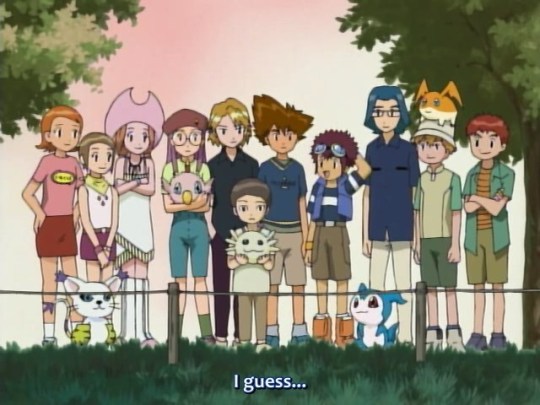
Once that’s out of the way, we go back to taking a look at the subtleties of everyone’s interactions. While everyone generally tends to focus on the second half of episode 17, it’s also pretty interesting to see how the 02 kids react to hearing about their seniors’ adventure in the first half -- remember that this is the first time the 02 kids are actually given any real depth about the degree of 1999′s events that’s not just random points of hearsay, and the way the new kids react to it indicates that they’re thoroughly floored. It’s later established that they didn’t even get the full story (it may not even be possible, given that the Adventure kids’ experiences may well have gone even further beyond what we got to see in 54 episodes), and yet the new kids are overwhelmed. 02 itself does not shy away from the fact that the younger kids really have no qualms about deferring to their seniors if need be, and treating them with utmost respect.
Another minor note, which I pointed out in my Daisuke meta earlier, is that the beginning of this episode is pretty much the last time Daisuke ever shows outright hostility towards Takeru for his relationship with Hikari -- it’s something you have to glean by squinting, but the implication is that the insecure and clingy Daisuke actually got to learn this episode that the two of them had a pre-established shared experience that he himself may not understand, and that it wasn’t just Takeru randomly swooping in and snatching away the closest thing he had to a friend for no good reason.
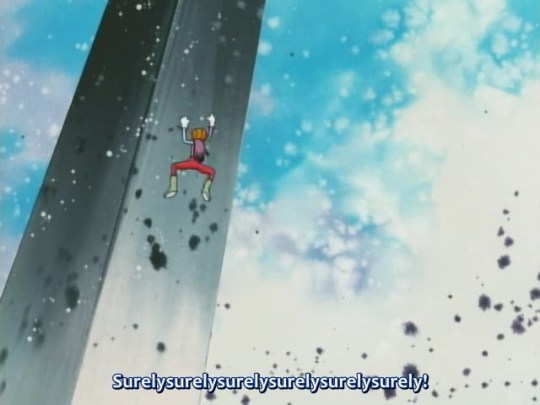
Once the Kaiser infiltration arc begins, episode 18 ends up being one of Miyako’s funniest episodes, but it’s a bit distressing that a lot of people in the fanbase often never let Miyako live this incident down, when in actuality this was explicitly not a good mental health day for her. (This is basically the equivalent of pinning Mimi as a conceited, self-centered jerk based on the fact she was one for a fashion in Adventure episode 25.) The beginning and ending of this episode establish that this is basically a result of Miyako...trying her hardest. She’s scared as hell, but she also learned in episode 10 that this is something she needs to take seriously, and the stress puts her into a mental breakdown. This is why she ends up having a heart-to-heart with Hawkmon at the end; her heart is in the right place, but she needs to find a way to channel her emotional sensitivity in a way that doesn’t make her into a complete mess.
And note that her own voice actress, Natsuki Rio, even pointed out that Hawkmon’s actions had enough of an influence on Miyako’s character that she had to play her differently thereafter.
At first I always played her with Maximum Excitement, and I kept thinking “someone, please, stop her,” but the more straight-laced Hawkmon did his best to pull her in and hold her by the reins (laughs). Thanks to him, Miyako became a lot more of a put-together person…thank goodness Hawkmon is her partner!
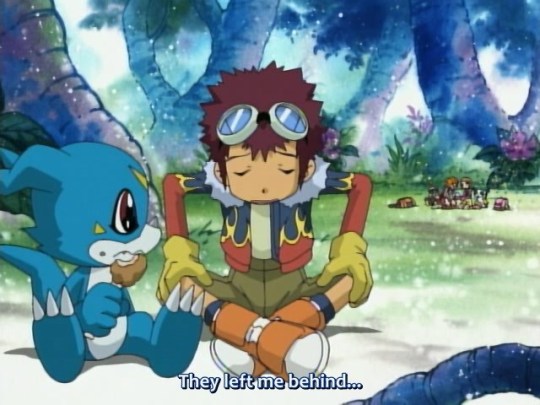
Episode 19 has two interesting things of note that I want to point out -- first of all, starting from the very beginning of the episode, everyone ditches Daisuke because they’re independently going in to infiltrate the Kaiser’s base. Note the complete lack of a plan here whatsoever -- everyone’s just going in on their own -- and the fact that everyone expects Daisuke to come up with what he wants to do on his own. For all it’s worth, even though Daisuke may have a designated protagonist aura to him, within the story itself...nobody actually sees him as a leader at this point in the series (and, to be fair, he’s never really tried to claim the position, either).
It’s similar to how Taichi was never recognized as a particular leader of the Adventure group until Adventure episode 28, but in regards to the full team dynamic, it’s actually inverse -- the Adventure kids were capable of making tactical plans together as early as episode 20, but fell apart emotionally in short order as soon as Taichi was gone, whereas here, the kids are fond enough of each other to hang out socially and support each other emotionally, but they take a while to get any real cohesiveness as a fighting group.
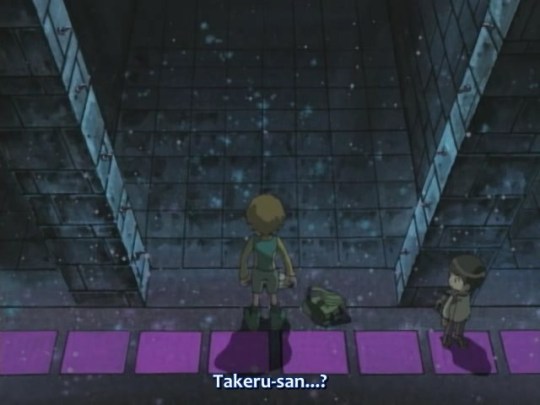
The other is that Iori personally witnesses Takeru’s sudden whiplash into his grudge against the darkness and the Kaiser, and it scares the hell out of him.
Takeru eventually laying a punch on the Kaiser is a pretty awesome moment (and, really, Ken kind of deserved it, so it’s hard to not cheer for him), but it’s also important to note that within the context of the series, this is not a good mental place for Takeru to be in. Iori, the person who should by all means sympathize with hatred of evil things at this point of the series, is still extremely unnerved by Takeru’s actions here, because he’d always seen Takeru as a mature person who’d always kept his composure, only to show a drastically different side of him that he hadn’t even shown a hint of before. That kind of “two-facedness” and emotional repression -- and this way of venting trauma in general -- cannot be good for Takeru at this point in time, and it’s also an important moment for Iori when he later admits during the two’s Jogress arc that he’s having a bit of a hard time understanding him.
And so episode 20 comes, and Chimeramon pretty much takes out the entire party, leading to this conversation.
Takeru: Let's escape. Daisuke: Escape? Takeru: We can't fight anymore. Our mission has failed. We'll retreat and wait for another chance. Hikari: You're right. We have no other choice. Iori: Understood. Daisuke: No. Miyako: Daisuke? Daisuke: We can't just say "another chance" like that. If we leave now, they'll keep attacking anything in sight. We don't know if we'll be able to get into the fortress again. So this is our only chance! Hikari: That's crazy... Iori: Exactly! Miyako: They're all back to their Baby forms... Chibimon: Daisuke... Daisuke: But...didn't you all see it? Destroying those towns...and all we could do was watch quietly. I don't want to see that ever again. I won't let them do whatever they want! So I'm going, even alone. I won't give up now. After getting this far, all I can do is go forward!
Why is this moment important? This is the first time Daisuke has actually stood a firm ground against anyone else in the party -- and not only that, with the entire party standing against him.
Recall that I mentioned earlier that, in spite of Daisuke’s abrasive attitude suggesting otherwise, he actually has a tendency to “deflate” pretty quickly when people tease or criticize him. He spends the first half of the series having a lot more bark than he actually has bite. Earlier in the series, if the entire party were to go against him, he’d be more likely to begrudgingly go along (while complaining) -- in fact, he actually did just that at the beginning of episode 7! But now that push has come to shove, Daisuke’s own sense of morals and bleeding heart have won out. (While his decision here is definitely a bit reckless, he does have a point; if they’d retreated, they might genuinely lose any future chances.) Even with the entire party telling him to pull back, he refuses to accept what they want him to do, and pushes forward.
This is where Daisuke first starts to really make strides towards what becomes his eventual major role in the group as “the one who pulls people forward”. It’s a moment after which the rest of the group themselves also start to treat him with more respect now that he’s proven he’s not just a doormat, and that when it comes to there being a real problem with real priorities, he does have the resolve and initiative to keep going.
Also, a very important point is that he immediately says he’ll go alone if he has to. He doesn’t begrudge the others for wanting to fall back, and has no condescension towards them; he just can’t stand the fact that he himself is being asked to sit it out.
So, you know. Episode 21 happens. Ichijouji Ken goes through some real trauma as Wormmon dies in his arms. And all Daisuke has to say is...
Daisuke: You should go home. There are people who are worried and waiting for you! Go home!
Remember when I pointed out that 02 takes a very unique perspective on Ken’s redemption arc, pointing out the futility of being too trapped in the idea of symbolic penance and focusing more on actively taking steps in the future to make up for and fix things? Here’s our first major sign of this, and Daisuke’s eventual approach to Ken -- Daisuke does not choose to scorn or lambast Ken for what he’s done, even though there are a lot of things Ken deserves to be harped on for, but rather instructs him to take the first active step towards fixing his mistakes, in this case fixing things with his family.
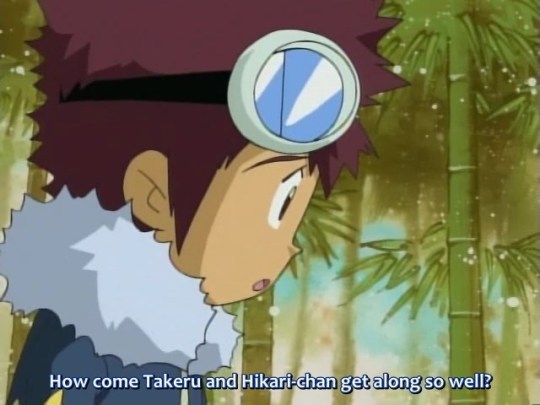
Episode 22 is Daisuke’s own “fanbase will never let him live this down” moment, but there’s still some interesting things to note here. Firstly, Daisuke’s “relapse” happening exactly when it seems like his duty to the Digital World is done and there’s nothing to do besides community service doesn’t seem coincidental, especially when this exact episode actually dedicates a full scene to Takeru, Hikari, and their partners going “...now what?” Secondly, as I touched on earlier, note that Daisuke’s never really seemed to have any resentment against Hikari for not responding to his affections -- in fact, he still considers it his own (and V-mon’s, by extension) duty to be the one to impress her. It’s a surprisingly refreshing take on the “shounen hero with a crush on a girl” trope, because in the end...Daisuke isn’t actually all that possessive of her, he just really wants validation from her, and respects her a lot.
More importantly, though -- note the way Daisuke handles this topic. He’s not actually mad at or resentful of Takeru anymore. In fact, he’s mulling on the topic and wondering what he could do to be on that level. Yup, even when Daisuke’s being shallow and jealous, he’s still learned to handle this issue ever so slightly more maturely than he would have at the beginning of the series.

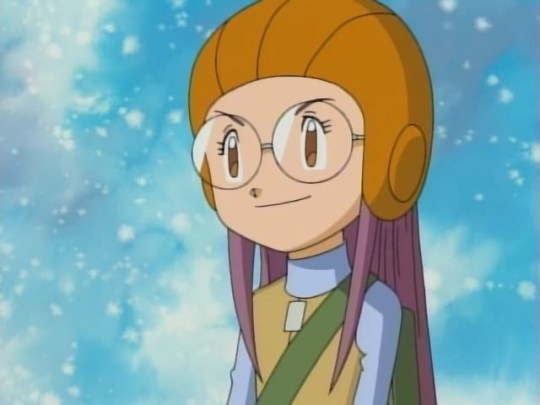
This is also important because only one episode later, once Daisuke becomes disappointed again at Takeru and Hikari walking off on their own, Miyako intervenes -- not only so that Takeru and Hikari can have their space, but also so that Daisuke can have some genuine fun and something to do. This is a very blink-and-you’ll-miss-it moment in episode 24, but it makes it very clear that Miyako was looking out for Daisuke’s welfare, too, and I think it’s very important in light of the events of the prior episode. Miyako, who had always been fumbling on what to do with her emotions, is starting to properly channel them into managing the dynamic between the team and checking in on how everyone’s doing, and that starts to guide her actions and relationships for the rest of the series.

The next episode (25) is where we kick off not only the Jogress arc, but also the arc where we start going into everyone’s attitude towards Ichijouji Ken. This is important not only because Ken happens to be the effective central figure of 02′s story, but also because -- well, remember, 02 is fundamentally founded on the concept of relationships, so it’s only natural that the other kids’ relationship with the “team newcomer” will be a key aspect of the second half, and in relation to their own characters.
Remember how I said that Daisuke’s first-half character involved him being extremely deferential and often deflating whenever he was criticized or someone stood against him? At the time of episode 25, once again, pretty much the entire team is standing against him -- he’s the only one who’s this level of open-minded about getting Ken into the group, and everyone else is showing differing levels of opposition. But while Daisuke doesn’t begrudge the others for thinking this way, he also doesn’t back down, either, and reaches out to Ken on his own because he still really believes in what he’s doing. Now that he’s settled into what it means to be a Chosen Child, he’s started to gain a proper idea of what he wants to do, and what he feels needs to be done.
So, let’s recap everyone’s stances on Ichijouji Ken at the time of this episode!
Daisuke: Forward-thinking and optimistic; willing to believe that Ken should be given the chance to make up for his mistakes and that they should put everything behind him, even to the extent of believing that there’s probably a good reason for the more suspicious aspects about him (prior to the events of episode 25, it was unclear whether Ken was being a bit too callous about killing Digimon). Also the most actively aggressive in reaching out to Ken and trying to get him to join them.
Miyako: Forward-thinking; she openly states at the beginning of the episode that she thinks Ken’s learned his lesson, she’s just worried about whether he’s going to keep doing questionable things in the future (killing Digimon). Once it’s on the table that he’s not just doing this callously, she immediately is on board with him (to the point of even being the first in the group to use given name basis with him), but her stance on what to do with him is more on the edge of “give him space and wait for him to come on his own terms” (she ends the episode saying she’ll be waiting for him to come).
Takeru: States in the episode that he does believe that Ken’s changed, but doesn’t really know what he’s thinking (i.e. too inscrutable to really be sure about). The later episode 35 implies that Takeru was inclined to be a bit more sympathetic than you’d think otherwise, because he understands the trauma of losing a Digimon partner.
Hikari: Wants to wait a little longer and see how things play out. (Remember that Hikari has a known, consistent thread of taking a very passive approach towards things.)
Iori: Absolutely against it on sheer principle.
It should be noted that none of these stances are wrong. Iori sometimes gets a lot of flak for being the one with the most infamously cold stance towards Ken, but when you really think about it, Daisuke and Miyako are very lucky that their hunch about Ken was right and that he actually did happen to be a very kind boy who had a little too much trauma and some supernatural influence. The fact that Ken is a very emotionally withdrawn person for the rest of the series meant that the two of them ended up breaking through to him the most, but there’s nothing wrong with Takeru, Hikari, and Iori’s skepticism; Ken did some pretty shockingly horrible things in front of their eyes for the first half, and it’s entirely within their rights to determine how forgiving they want to be with him.
In any case, we get to episode 26 (the first Jogress), and most of that episode goes without saying, but I do want to emphasize Daisuke’s lines right before it happens.
Daisuke: If you die now, you won't be able to accomplish anything...I don't want that! Ken: I don't want that...There are still many things I must do.
Daisuke urges Ken not to go for the “suicidal penance” route not only because it sucks, but also because, as symbolic as it may be, it’s also counterproductive to the whole point of doing penance to begin with. If Ken really wants to make up for his mistakes, he’s only going to be able to do that if he’s actually alive to do it! There’s only so much you can do by drowning in self-pity by going “because I did this, because I did that” instead of actually taking responsibility for your actions.
02 itself is deliberately ambiguous on how much Ken’s transformation into the Kaiser was Ken’s own conscious will and how much of it was Dark Seed-induced supernatural influence, but one thing it’s consistent about is that it doesn’t really matter. Regardless of what the cause was, Ken did what he did, and it’s his responsibility to make up for it, and the only way to actually do that is to keep moving forward. The fact that Daisuke is so able to viscerally and directly address what Ken needs the most right now is what fuels their first Jogress, and why Daisuke becomes Ken’s closest friend through the rest of the series.
People have pointed out that 02 has a lot of moments of physical hits, but, notably, other than Takeru punching the Kaiser in episode 19 (which he really deserved, honestly), all of these hits are done with the express intent of bringing the other person out of a very, very deep mental abyss (Yamato punching Taichi in episode 10, Daisuke slapping Ken in 26, Miyako slapping Ken in 30, and Miyako and Hikari’s mutual slaps in 31), because they were in a state where words would no longer reach them otherwise. These are all circumstances of the kind where the person on the receiving end understands that they really needed a drastic wake-up call because of how deeply they’d fallen (and these aren’t some average mental abyss problems these kids are getting put through, either). It’s actually hard to imagine any of the 02 group getting in the kind of genuinely angry and vicious fistfights Taichi and Yamato would in Adventure, because of how close they are (the closest being Daisuke and Takeru grappling in episode 11, but it never got near that level) -- in fact, these kinds of things are done with the implication that they’re doing it because they trust the other person to not hold it against them (and in fact, the fact Yamato does this with Taichi in this way is intended to be read as a sign of how much better they’ve come to understand each other).
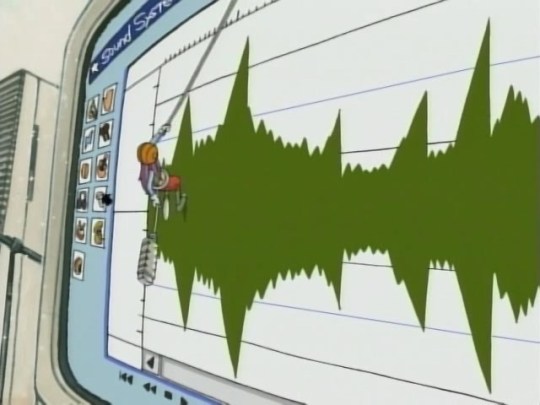
So, moving on with the series! The Giga House incident in episodes 28-29 is the first time the group works together in an organized effort, which is notable not only because it’s their first time coordinating with Ken, but also because it’s their first time properly coordinating at all. Remember when I mentioned that, back in episode 19, as much as the kids were pretty fond of each other and were great friends, they still hadn’t figured out how to actually fight as a team? Here we are, with them actually having started to figure that process out.
We then get to episode 30, where there’s actually quite a lot of interesting things to unpack.
Miyako: What's wrong with you? Daisuke: E-Eh? Mi-Miyako-san? Miyako: It feels weird when you add the "-san". Daisuke: Shut up! Man, you're all the same!
Miyako and Daisuke’s relationship is often misconstrued considering that they’re the two most chaotic in the group (their temperaments are very similar at times, which causes them a lot of friction), but I also think this blink-and-you’ll-miss it moment is pretty much their actual relationship in a nutshell. They fight a lot, and they’re ostensibly vitriolic, but they’re actually two of the most like-minded in the group -- they banter because they’re comfortable with each other. Recall that I mentioned that Daisuke is normally respectful with his elders, yet he’s the only person in the group who won’t use the -san honorific on Miyako (even though she’s the oldest)...but the one time he gets flustered and uses it on her, she tells him that it’s weird and he needs to cut that out. Or, in other words, “it’s not like you to be weirdly respectful of me like that, we shouldn’t have that kind of distance between us, stop it.”
(It’s also pretty notable that Miyako has never seriously used -kun or any other honorific on Daisuke, even right after meeting him -- the only other person she dropped honorifics on was Iori, whom she’d known prior to the start of the series, but she seems to have deemed Daisuke enough of a fellow disaster child that he merited dropping it.)
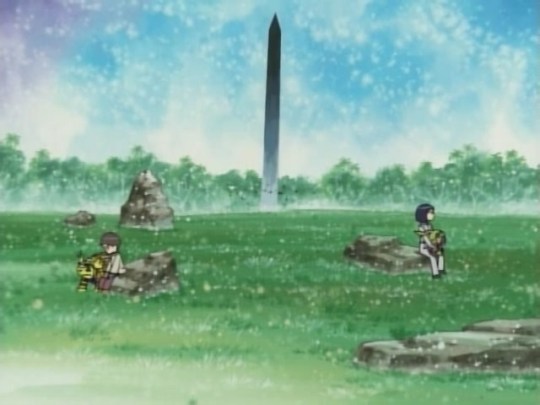
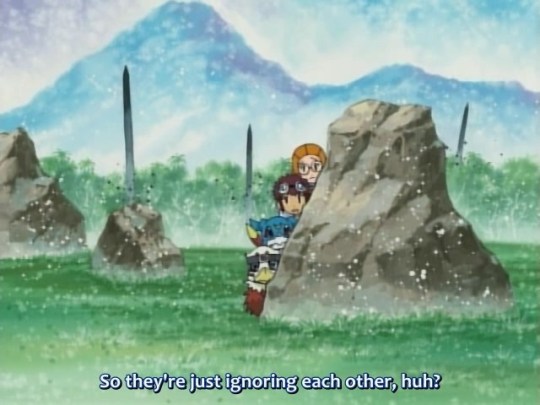
This is especially because, right after that, she recruits Daisuke into her plan to get Ken and Iori to get along -- in the end, when things really get serious, the two are incredibly like-minded (look at how in-sync they are when they scheme together).
30 is actually a surprisingly Miyako-centric episode, despite not ostensibly being one. For one, it says a lot that right now, her biggest priority is to get Ken and Iori to get along -- something that has absolutely nothing to do with herself. In episode 14, Miyako freely admitted that she had a tendency to jump to conclusions about people, and that she was shallow about aesthetics, but this is a very different Miyako from the one who harassed Daisuke for Ken’s autograph in episode 8, or immediately became distrusting of Digitamamon in episode 14. Instead, she’s simply just genuinely invested in seeing people she considers friends get along, and in a selfless manner -- one that has nothing to do with herself. She just really, really cares, a lot.
After all of the first-half hubbub of Miyako really having no idea of what to do with her emotions, the second half has her start channeling that energy into what’s always been one of her biggest strengths: checking on, connecting with, and caring about her friends. Daisuke may be an aggressive forward-thinker who can push everyone in the right direction, but unlike his predecessor Taichi, he doesn’t actually have particular charisma or leadership skills that can necessarily hold everyone together. In the absence of that ability, Miyako fills in for him, checking on the moods and feelings on everyone in the team and making sure everyone’s doing well. And that’s why she loses her temper and slaps Ken late in the episode -- because, really, she’s reached her limit on her “give him space” philosophy when he’s abusing it to be standoffish in a crisis situation, and, on top of that, she really, really did have a huge emotional investment in him.
Moving onto more Miyako in episode 31, her Jogress episode with Hikari, we get to see a little bit of the old emotionally compromised Miyako again, but -- much like the second Digimentals arc -- it involves the two of them acknowledging that both of them are not going about things the best way, and that there are things they can learn from the other.
Hikari: Miyako-san, you're a handful sometimes. Miyako: I knew that's what you thought of me... Hikari: But...I've always envied that. Miyako: Huh? Hikari: Because I can't be honest and say I'm scared or scream like you.
Miyako’s tendency to lose control emotionally results in her being insensitive much of the time, which she calls herself out on multiple times during the episode, and she can’t always be as “kind” as Hikari is -- but, on the flip side, her antics are something that can be a “light” (pun not intended) towards those who are falling in a bad mental state or into the darkness, and Hikari even acknowledges this when one of her trains of thought makes her break out into laughter. Miyako ultimately manages to get through to Hikari this way at the end of the episode, which results in a Jogress and mutual growth for both of them -- Miyako puts more thought into how to approach others (it’s pointed out at the end that she’s still thinking about understanding Ken and Hikari better), and Hikari gains more resolve and determination to fight against things instead of passively accepting her fate (she tells Takeru very directly at the end "I’m fine now. I’ll never go there again.”).
Iori and Takeru's Jogress is a little more complicated to the point where it spans multiple episodes, but a lot of it ends up having to do with the fact that the events of the BlackWarGreymon arc start really putting Iori's black-and-white principles into conflict -- it's wrong to kill something that's been proven to be alive, but it's also wrong to be evil. Putting a huge nail in that is that there's a stake in him forming a relationship with Takeru, but he doesn't really understand Takeru either -- the "two-facedness" he witnessed back in episode 19 scares even him, and he's so intimidated by Takeru that, in episode 35, he goes to approach Yamato about Takeru's past instead of asking the person directly. Takeru, hearing about this, complains that he could have just asked directly, but admits he understands why Iori did so.
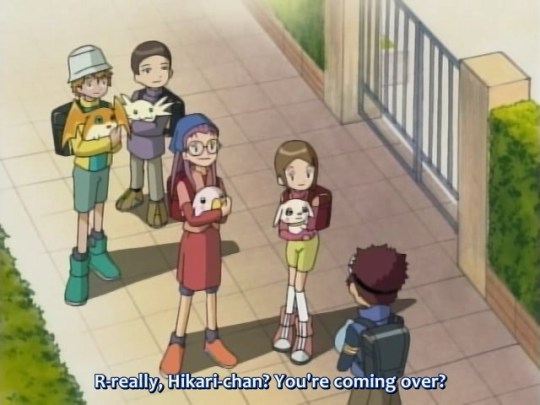
By the way, I should point out that episode 35 is the last time within the TV series that Daisuke is portrayed as having a particular interest in Hikari, and it’s just in terms of being slightly more excited that Hikari is joining his meeting. At this point, there are actual important things happening in the Digital World, and he needs to take care of Ken, too, and so...in the end, once again, Daisuke proves that he’s actually capable of putting aside those kinds of more shallow things when he really needs to.
On top of that, this is when the kids start actively working with Ken in the real world (and, if post-02 materials are any indication, continue to hang out with him even for social outings). The choice to have Ken live in Tamachi instead of Odaiba facilitated his isolation from the group during the Kaiser arc, and during around the third quarter they were all grouping up in the Digital World anyway, but the fourth quarter actually has the kids make an attempt to include Ken in their real-world outings despite the distance. Tamachi is not temporally far from Odaiba (approximately half an hour by train), but it’s a bit of a nuisance to get to, requiring crossing a bridge to/from the Tokyo mainland and paying extra for the Yurikamome. But at this point, he’s an important enough friend to them -- and them important enough friends to him -- that they’ll make it work.
At the end of episode 35, Iori finally decides -- to the point of recklessness, something that would have been previously very uncharacteristic of him -- to try and appeal directly to BlackWarGreymon to get him to stop destroying the Holy Stones so that they won’t have to fight. It’s emblematic of Iori’s heart being genuinely torn, because he’s having such a difficult time rationalizing all of these conflicting feelings. This comes to a head in episode 36, when Iori loses his temper at the rest of the group for “playing around”, but Armadimon snaps him back to reality to remind him that they’re tired and hungry, and this can’t be neglected. Iori himself ultimately becomes the one to proactively suggest that they take time to sit down and eat, indicating that -- little by little -- he’s starting to shift his thinking a bit, after being so incredibly stubborn for much of the series.
This is what leads to Iori and Takeru’s Jogress at the end of the episode, now that Iori is flexible enough in thinking to understand the emotional id behind Takeru’s mentality. And likewise, Takeru’s started to loosen up by 36, too --
Takeru: Sure, darkness is frightening, and we would feel at ease if we could get rid of it completely, but I'm sure that's impossible. Ken: Impossible? Takeru: Where there's light, there's always darkness. Hikari: The brighter the light, the darker the shadow, right? Takeru: Yes. That's why I think it's important not to lose sight of the light inside you, no matter how dark it is.
The thing about Takeru is that while he deceptively seemed more open and playful than Hikari for most of the series, he was actually bottling up a lot of emotions in a way not entirely different from the way she did. (Note how, despite how tied at the hip the two constantly are, they almost never actually talk about their thoughts on each other; it feels like a relationship where they implicitly trust each other but are practically reliant on that implicit trust to maintain that close of a friendship at all.) And he’s been keeping those emotions bottled up until they exploded in less-than-healthy ways, initially distancing himself from Iori. But being a lot more open about his thoughts on the matter allowed them to connect better, and eventually Takeru came to embrace a somewhat more reasonable stance on the matter after observing Iori.

It also doesn’t seem like coincidence that this is the episode that ends with Takeru’s first major act of goodwill towards Ken.
This leads into episode 38, the Christmas episode. Fun things to note!
The episode opens with Daisuke and the other younger kids giving a “Christmas present” to their seniors in the form of letting them reunite with their partners. Remember how I said that the 02 kids always admired their seniors and looked up to them? Even this late in the series, the series does not shy away from the fact you’re supposed to see the 02 kids as their deferential juniors.
The Christmas party is, of course, notably, the first major moment of reconciliation between Iori and Ken, with Iori having gone through major harsh lessons about morality in the last few episodes, and Ken opening up more to the rest of the group. Said party is also yet another notable example of how much of a priority it is for the 02 kids to be “social life friends” and not just friends working as a Digimon incident team -- after all, having genuinely emotionally present friends is what Ken needs most in his life right now, considering that the party is treated as the first time he’s been truly happy in a long while.
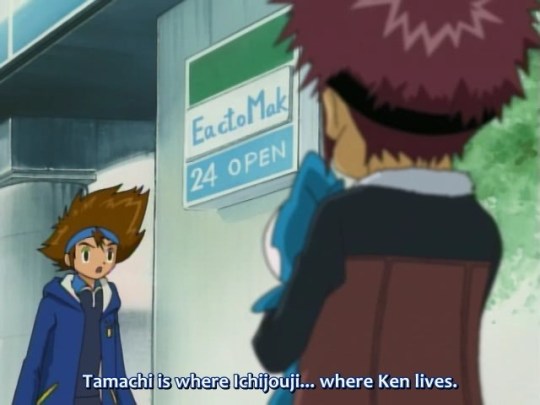
This is followed by episode 39, which is notable as the time when Daisuke finally commits to switching to given-name basis for Ken, and actually opens the episode standing against Taichi -- because he's so worried about Ken that he needs to go join him. This is something that's lost a bit in translation, but although Daisuke stands down against Taichi, he's not rude nor does he overstep his boundaries with his respected senior (he even opens his statement in polite-form Japanese) -- he's just saying, firmly and politely, "I'm sorry, but I can't go, I have to go help my friend." It’s a notable moment because while Daisuke has been becoming increasingly assertive and aware of what he really wants to do, this is the first time we’re actually seeing him refuse to defer to the very senior he’d spent so much of the series idolizing and looking up to.
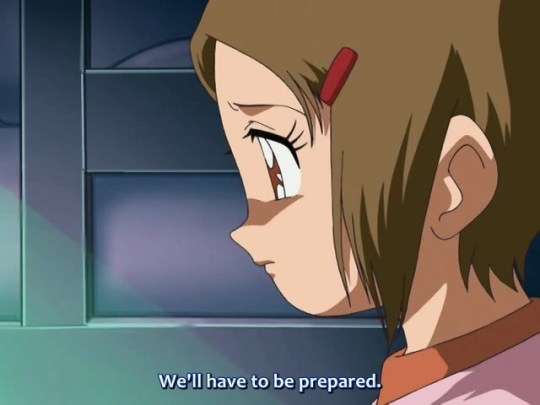
We get to episodes 43-45 (the Demon mini-arc), which is also the culmination of the 02 kids having to face the limits of pacifism. This tends to throw off people who are coming in from Adventure, since the Adventure kids ended up killing Digimon with a lot more ease in the original series, but it’s also important to make note of the fact that the episode itself deliberately portrays a gap in mentality between the Adventure and the 02 kids -- with Hikari torn between the two. It also creates an interesting subversion of expectations when Hikari, the one you’d expect to be more on the pacifist side, is the one who’s already accepted that it may be inevitable, whereas Miyako, the more aggressive and belligerent one, is the one staunchly against it.
The reason for this “paradox” comes out of a single line from Hikari in episode 44:
Hikari: You’re the one who saved him, Miyako-san.
The Adventure kids never liked killing. They were never enthusiastic about it -- it was just that they were almost immediately put in a situation where the entire fate of the multiverse was at stake thanks to some unambiguously evil Digimon who wanted nothing but wanton destruction. Even then, it was pretty clear that they never enjoyed it -- Takeru professed a desire to avoid fighting in Adventure episode 12, and the pacifist Mimi went through a breakdown in Adventure episodes 45-50 trying to avoid casualties. But one of the most important lessons Mimi learned at the time was that pacifism has its limits -- there’s no point if it ends up in more deaths than it saves, because at that point you’re adhering to moralistic principles more than you’re actually saving lives.
The fact that the Adventure kids and the 02 kids have a “different mentality” isn’t just happenstance, but outright embraced. Daisuke, Miyako, and Iori never had to actually deal with a conscious Digimon that was unambiguously evil for most of the series, and Archnemon revealing that her motives were pretty much nothing but wanton destruction in episode 29 was the first major warning signal to Iori that his pacifism might have limits. And during this Demon mini-arc, it’s not like these Digimon are threatening multiverse destruction or anything -- it really does seem like a constant “glimmer of hope” that maybe, just maybe, they can save people non-lethally. Alas, they can’t.
Daisuke, being someone who’s inherently practical-minded, starts entertaining the idea that push may come to shove as early as episode 25, and finally makes his first statement about practical limits in episode 43. But the more emotionally caught-up Miyako and Iori end up taking another episode to swallow it, and they don’t take it well. Most of the attention in 44 is given to Miyako, and it reconfirms that, despite her aggressive exterior, she’s emotionally sensitive and empathetic -- and while killing LadyDevimon is framed as truly the only thing that could have been done in that situation, Miyako is not faulted for being emotionally compromised, nor is Iori likewise when he faces a similar situation with Takeru and is forced to confront the people whose lives were at stake.
Episode 45, when Ken opens the gate to the Dark Ocean, doesn’t really have much to add on top of what’s already there, but this is basically “the point of no return” when everyone confirms their own emotional investment in Ken and understanding that he’s not just reformed, he’s genuinely struggling under the pain of what’s been happening -- and this is before they find out about the truth behind the Dark Seeds, and that Ken’s transformation into the Kaiser may have been supernaturally influenced, too.
It’s also interesting to see the different ways each kid reacts to Ken as they support him:
Hikari, the most outwardly compassionate, goes to support him the second she notices him in physical pain; Takeru notices that it might work, realizes Ken needs the support, and joins.
Iori and Miyako reflect on how Ken’s putting all of his efforts in, and lambast themselves before joining. Interestingly, given the circumstances behind what’s happened up until now, Iori and Miyako criticizing themselves take a different meaning -- Iori, who’d been scornful of Ken until recently, seems to be regretting that he distrusted him when Ken had been trying so hard, while Miyako, who had been open to him since episode 25, seems to be upset that she’s sitting there and not doing enough when he’s in all of this pain.
And Daisuke, of course, the most “forward-thinking” of them all, gives Ken a speech about what he’s done so far and reminds him that he’s already done more than enough for “atonement” -- which is, of course, what directly reaches Ken the most.
And when we get to episode 46, and the kids, now knowing about the Dark Seeds, hold a roundtable (and emotional support group) to discuss what to do about the Dark Seeds, Daisuke’s the one with the most spirit and energy about it, but...
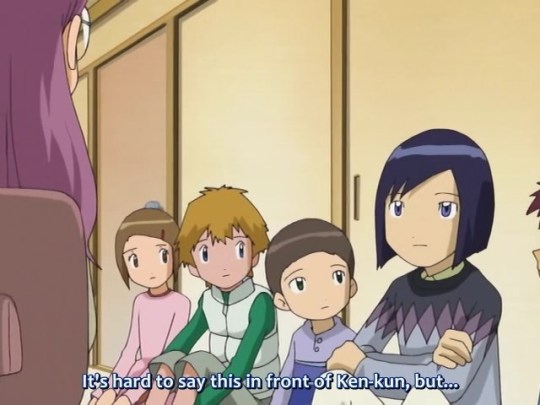
...the one actually leading the roundtable? Miyako.
Miyako: Sorry, that's all I can think of. Ken: Please don't worry about me. Miyako: (nods)
It’s subtle, but the scene in question does actually make a deliberate move in indicating that Miyako’s continuing to channel her emotional sensitivity and desire to go out of her way to help Ken -- of course, they all know how traumatic this is for him, but she’s the one who’s actively calling attention to how he must feel about it first and foremost.
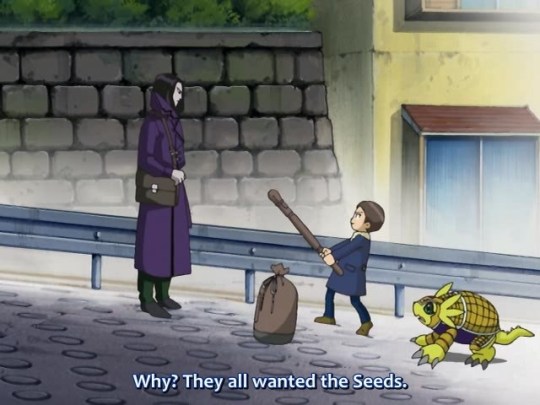
Episodes 47 and after end up becoming yet another major wake-up call for Iori (seriously, I do not understand why people claim he had no character arc when this wasn’t even remotely subtle) when he learns that Oikawa, whom he’d pinned as “evil”, has a deep relationship with the father he’d grown up idolizing so much, and it completely flips his world around -- even though he had started to get a bit more open-minded, he’s still trying to rationalize what should have been, in his mind, two diametrically opposite things. It fuels his confusion and desperate desire to understand more, not just about Oikawa, but about everything he’d thought about morality and why people turn to evil.
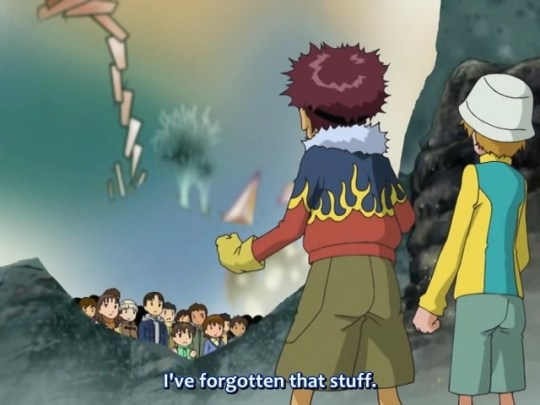
So we get to the final arc of the series, and it involves a confrontation with BelialVamdemon -- but said finale is heavily dependent on talking to the Dark Seed children and inspiring hope back into them. This results in a conversation where everyone talks about their career dreams, and Daisuke admits that he wants to be...a ramen chef, which completely blindsides even his friends.
What’s with this arc?, you might think. And moreover, why is Daisuke ending the series still kind of an idiot? Even Miyako still seems to be a bit of a mess and chaotic. Weren’t they supposed to be growing into dignified heroes, like Taichi and his friends were last series?
Well, here’s the thing -- the fact that the 02 kids end the series comparatively “undignified” is actually very inherent to the core theme of 02 itself. There were more than enough episodes that established that said kids are heroic in their own way -- caring about others, fighting on others’ behalf, and learning important lessons about what’s important to fight about. That doesn’t mean they don’t get the right to continue being disaster children while they’re at it.
Why?
Let’s look at a few official statements behind the creation and intent behind 02 as a series. From producer Seki Hiromi, from the Digimon Animation Chronicle:
That came from an idea I had while reading a newspaper article. I read a story about a nine-year-old boy going to Columbia University, and I thought, “This boy is going to college because he’s considered a genius, and everyone around him will be in their twenties, and he won’t get to have any friends his age. What kind of life would this boy end up having?”
Or some very interesting statements from head writer Yoshimura Genki from the 02 Blu-ray box:
When I was writing Ken Ichijouji, the main idea for him I used as a basis was the conflict between “the self that has to be a well-behaved child when adults are watching” and “being able to be oneself”, and the pain that came from it as a result. So for instance, in the same way as the Pinnocchio fairytale, or the short story A.I. that was adapted into a movie, or many other works, there are probably universal worries that all children feel as they grow, but also, there were ongoing unimaginable, atrocious incidents happening with children at the time, and perhaps it was those social conditions that gave me a hint on what to do. I think I had some thoughts that I wanted to convey to the children who were living through that time. I was given the opportunity to put those kinds of feelings, as much as I liked, into episode 23, and I am truly grateful to all of the staff, including the director. ... Also, this is about Daisuke’s character, but I believe I paid particular attention to making him “a child who could be himself”. He has no special talents, and although he’s clumsy and scatterbrained, I wanted him to be someone whose strength was in his straightforwardness, and wrote him that way.
Lying underneath the entirety of 02 itself is a theme about “children who are not allowed to be children”. Or, in other words, the pressure placed on children to be “talented” and “dignified” and “well-behaved”, often imposed on them by well-meaning parents who are unfortunately taking the opportunity to stroke their own ego, robbing them of the happiness and mental freedoms they should have as kids.
Ichijouji Osamu and Ken, who were placed under the pressure to be “genius children” and cracked under the pressure to please their parents. Oikawa Yukio, who was cut off from the Digital World in childhood by a well-meaning Hida Chikara, worried about his son getting into “foolish” talk. The Dark Seed children, who also fell victim to similar pressures that Ken did, and lost hope for life unless they could force themselves into that mold.
Takeru: If you want the Digimon to exist, if you believe in that, they will. Just like our feelings...Just like every child having the power to make their dreams come true. Keiko: That's just childish. Daisuke: You all have dreams for the future, don't you? Noriko: Dreams for the future? Takashi: I've forgotten that stuff. Daisuke: No way! You must have one! Takeru: It's nothing to be ashamed of. Takashi: Then, what's your dream? Daisuke: Mine? Mine's a ramen shop. I love ramen! I'll become the world's best ramen maker! Ken: I had no idea... Noriko: Well...actually, I wanted to be a kindergarten teacher. Hikari: Me too. Daisuke: What about you guys? Takashi: A baseball player! Keiko: I really want to be a pastry chef. Hiroshi: When I said I wanted to be a manga artist, everyone laughed, so I gave up... Takashi: We all had aspirations, and at some point we thought that wasn't allowed...But we were wrong, right? Daisuke: Let people say whatever they want! Noriko: You're right, we should be free to dream. Miyako: Not just dreaming. If you work hard, your dreams will surely come true!
Notice something about all of these careers mentioned? They’re all the kind of “overly childish” “wild dream” “undignified” “too simple” kinds of dreams that an average parent might be uncomfortably quick to shoot down because that’s “not good enough”. These are the kids who willingly accepted the Dark Seeds; they, much like Ken, probably grew up under parents who prioritized school performance and other “societally dignified” things that ended up eating away at their happiness.
02 has a lot of different themes, but the one that lies in its undercurrent from start to finish is “so why does a child have to be this way? As long as they still understand what’s important, do they have to be dignified people? Why can’t they just be free to have dreams and be themselves?” And Daisuke and his friends are there specifically to stand up against this mentality, and to remind Ken and the other victims of it that it doesn’t have to be this way -- that it’s okay to be your true self, and be a child, and not succumb to all of those arbitrary, shallow standards people put on you. Even if that means you’re still a bit of a chaotic disaster at the tender age of eleven.
Digimon, in the Adventure and 02 universe, have always been treated like a part of the self (they were literally conceived as a physical manifestation of the soul), but in 02 they gain an extra meaning of representing “the inner, deepest part of yourself that represents your wildest ‘childish’ dreams”. The symbolism of Ken spending the first half of the series trying to reject Wormmon for being “weak” -- in other words, rejecting his own kind-hearted self for not being the kind of “strong” entity he was pressured and groomed into being -- is not lost, nor that of the Dark Seed children gaining partners when they reconnect with their dreams and wishes, nor Oikawa finally, finally meeting his partner when he comes into contact with the past he’d really lost (and especially not the fact that his attempt to reclaim shallow reminders of said childhood involved trying to make his own Digimon).

And notably, the series’s finale (prior to the epilogue) ends not on Daisuke but on Iori, escorting Oikawa to the Digital World despite how completely impossible it would have been for early-series Iori to even entertain the idea, finally coming to truly understand what happened with him and being most personally impacted by his death.
But in any case, where are we with the characters? We’re here to talk about how they’ve grown and developed over the course of the series. Let’s recap:
Daisuke: Started off the series as an abrasive kid with more bark than actual bite, constantly deferring to others and easily deflating, relying on shallow sources of validation like wanting attention from Hikari; gradually gained an ability to identify what was important and put his foot down for it, embraced his forward-thinkingness to reach out to a heavily troubled child as a friend, and ended up surrounded by a friend group that loves and respects him.
Miyako: Started off the series as a shallow, flighty girl with poor control over her emotions and difficulty in appreciating the gravity of things; came to channel her emotional range into empathy for others and compassion, bringing other people together and taking care of them.
Iori: Started off the series as a straight-laced but too principled child who stuck to “rules of what’s right” not only in morality but also in way of acting; started to appreciate the emotional nuances and heart behind why people do what they do and how it’s possible to be more flexible in “doing good”.
Ken: Well, his character arc is pretty obvious, but -- again, while his arc of learning to forgive himself is well-known, less often pointed out is that it centers very heavily on not only having penance but also not being too hung up on the past, and the futility of drowning in self-pity and regret instead of choosing to take responsibility and act more productively going forward.
Takeru: Started off the series as a seemingly mature but deceptively inscrutable character whose duality made him hard to approach; eventually opened up with the help of others and showed a capacity for being more flexible with his personal grudges.
Hikari: Started off the series emotionally repressive and passive to the point of self-destruction; eventually embraced connections with her other friends and became more active in taking a stand for herself.
Hey, not bad!
And, again, this is not a series you should be reading in terms of “self-awareness” in the same way Adventure was, but in the sense of their “relationships” and how they interact with others. By being less abrasive and more assertive, Daisuke gained the respect of his other friends. By putting her emotional capacity into caring about others, Miyako became someone who holds the group together. By learning to think a little more flexibly and be less stubborn, Iori arrived at a position where he could more easily sympathize with others in the group. Takeru and Hikari both moved from their previously relatively inscrutable positions to ones who could more effectively interact with and open up to others. And Ken, of course, became someone who managed to integrate himself into a group of true “friends” despite everything he had done against them in the first half.
This, in the end, is how you get what’s one of the tightest friend groups in Digimon history. In the end, the relationships themselves are almost like characters of their own that got development -- I say very often that you could take two of the characters and have an excellent scope of how they’d interact and play off each other by the end of the series. And although they end the series as possibly one of the most shameless, undignified disaster groups out there...they’re certainly still heroic, and in any case, given the lessons they learned throughout their own series, they probably wouldn’t have it any other way.
251 notes
·
View notes
Text
A not-so-brief overview of my Skyrim Dova OCs bc i need to scream to the digital void about my ideas
Freyora Lind, more commonly known by her strange alias “Bjorne Icepick”
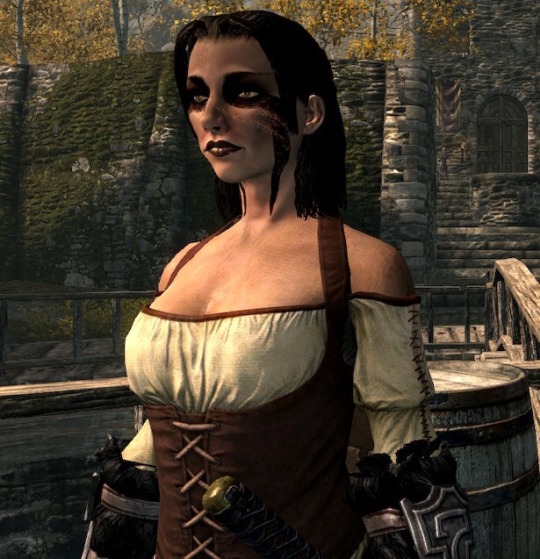
A Nord-eventually-turned-werewolf who orphaned during the Great War and taken in by a Dunmeri mercenary whose residence was in Windhelm’s Gray Quarter. Grew up in a cramped boarding house setting among desperate mercenaries of varying backgrounds. Many of them would all come and go, but there was always some sort of a familial bond between them all.
From a young age she got in a lot of fights against people who insulted her for living in the Gray Quarter among the dark elves. Eventually she took a fight too far and was jailed for murder around 14, but was broken out shortly after by a band of masked vampires. Turns out some of her mercenary comrades unwittingly caught vampirism during a contract to clear out a vampire den and had to skip town, but not before ensuring one of their own wasn’t left to rot.
Lived in Cyrodil for about 15 years, but returned to Skyrim pursuing rumors surrounding a cure to vampirism, as her adoptive father would be nearing the end of his elven lifespan and had wished to die a normal death.
Seeing as she was literally a fugitive, and her long-belated parents were somewhat renowned for their battlefield prowess, she took on a false identity. AND an act to match it.
She’ll eat raw meat, chase prey with swords instead of using a bow like a normal person, harp about irrational conspiracy theories, and more. Everyone’s foul reactions to her outlandish act are plainly hilarious to her and only encourage her to act even stranger.
The alias “Bjorne Icepick” was simply the most ridiculous name she could think of.
Not the most morally outstanding. Besides drunken brawling, she’ll steal from anyone who angers her, even if it’s things she literally won’t ever need such as all the goblets in a household. It’s the pettiness that counts. “Try drinking your damn high-end wine now, jackass.”
Calls Dwarven Automatons “Gundams.” Including she herself, no one knows what that means.
Joins the Companions out of homesickness and a desire to fill in a gap that leaving home left.
Hasn’t bothered curing herself of lycanthropy because her whole schtick is being incredibly resourceful, and that includes using any means of power necessary. Still doesn’t fancy Hircine’s Hunting Grounds as her desired afterlife, though.
As her journey goes on, however, her lightheartedly eccentric face starts to fall off as a number of events push her to begin to question the legitimacy of her actions up until that point.
Some of which include the eventual death of her adoptive father (and how she was indirectly responsible for it even if it was what he wanted), Delphine’s ultimatum, the civil war as a collective, learning the tragic history behind the Falmer and the original Companions’ role in it, and killing of Vyrthur (no matter how much he genuinely deserved it).
She grows disgusted by herself down to the core. She takes to skooma to cope, and starts to be plagued by serious skooma-induced side effects. She ends up shutting herself away from all her responsibilities and distancing herself from her friends.
Does she get better? Maybe. I haven’t thought up anything past this point lol
Moureneris Alta
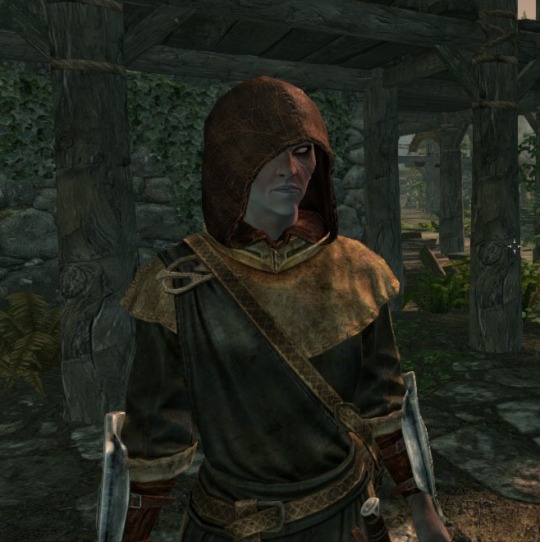
A very, VERY ancient vampiric snow elf, (though it’s notable she was born a considerable amount of time after the razing of Sarthaal)
Survived many atrocities. Stayed in isolation with a band of vampires for countless years out of sheer disgust for the nature of the sapient races. (I’ll explain her full story some other time. It’s pretty complicated)
She was abducted from her isolated lifestyle by a certain person i’ll talk about later. She managed to free herself south of Skyrim, and uh, walks right into that Imperial ambush. The rest is history.
Super ignorant to modern society as a result of centuries of isolation. Exploited for comedic relief. (“What in the name of Oblivion is a Cyrodilic Empire? Are you messing with me? And please, how does levitation magic simply get outlawed by this hypothetical Empire? What are you to do when you fall down a crevice? Just... let yourself perish? How degrading.)
She reintegrated herself into society with vengeance in mind under the belief that all humans are savage bloodlusting murderers who had to answer for their treachery. (And she was royally angry there was no Dwemer left to spite, but partially satisfied at the same time). But she grows conflicted after being shown genuine kindness, even as early as being freed from her binds in Helgen.
Subsequently has a very muddled redemption arc. Queue Dragonborn hero stuff
She has impaired vision, but she cultivated detect life magic to aid her in daily life and combat (think Hyakkimaru from Dororo ‘19 and his soul detection or Toph Beifong from ATLA and her seismic sense). At her peak, she can detect life from about a kilometer away.
She can just barely read, but only if she holds the text incredibly close to her face, not to mention her Cyrodilic lessons were left unfinished after her abduction, making reading a very taxing process. Weary travelers are often spooked at the sight of a floating, ghastly looking elven woman with her nose pressed up against crossroad signs, and it has become somewhat of an urban legend.
Isn’t as nearly as skilled with detecting the dead and tenses up in burial crypts or around other vampires for that reason. Unfortunately, being the Dragonborn and all, she finds herself in a lot of crypts...
When questioned about her background due to her unique appearance: “Oh, yeah. My mother was one of those mer from the east. You know the ones. Dark elves, I think? And my father was one of those er, tall elv- no, sorry, HIGH elves. Yeah. They both died in a big fire or something though. It was horrible. I can’t get the noxious smell or the deafening screams out of my head. Good talk, but never ask me about that again.”
Queue sheltered old immortal antics: “Wow, you’re THAT old? Enlighten me on how it felt witnessing the fall of the Dwemer. Or perhaps the rise of Tiber Septim’s Empire. The Gates of Ob-“ “Oblivion if I know. I lived in someone’s basement for thousands of years. And I still don’t know what everyone means by Empire. You all are messing with me, aren’t you? That really annoys me.”
She ultimately returns to faith in Auri-El and makes it her life’s purpose to help the Betrayed find peace, as well as to seek out any remaining snow elf groups. Probably good friends with Gelebor or something.
Had a crush on Serana. We all know how THAT went. Damned temples.
Was originally gonna spiral into a much darker corruption arc (another ATLA comparison being Jet or Hama) but I just felt bad for her. Moureneris can have a little found peace. As a treat.
That’s her preliminary design made. I’ll need a mod to properly play her, because that right there was made by choosing Dunmer as her race. But I can’t do that. I’m on console, and while I got the Steam port a month ago, my PC’s stone age specs can’t handle Skyrim yet and I’ll need to wait until I can afford a better graphics card (thanks economic inflation)
Alexandre Armasi, jokingly nicknamed Alexandre the Curious

A complete and unapologetic export of my character from a dead and unfinished DND campaign. Except there are no Aasimar in Skyrim, so he’s half Altmer half Bosmer. And his initial last name was Armas but I thought Armasi suited his Skyrim counterpart more, as subtle a change it is.
He’s mainly Bosmer in appearance and constitution, save for his hair and eyes, which are more similar to that of his Altmeri father’s.
I can’t really export his original backstory though because the campaign wouldn’t translate well into TES lore at all.
He’s a writer who came wandering into Skyrim in search of inspiration. While he mainly writes dramatic fables, he wanted to divert his focus to crafting his own bestiary and herbal compendium surrounding Skyrim’s fauna and flora. The ones at home are simply too vague to him!
He’s very altruistic, wishing to spread cheer wherever he goes, through the art of song (even though he was a cleric in DND and not a bard. My bad.) However, many of his verses are just blatant self promotions of his published fables.
But he’s too naive for his own good. Dangerously so. In fact, he says what’s on his mind with little forethought, with little grasp on the consequences of his actions, which lands him in lots of trouble. “I don’t favor him myself, but you guys kill people over Talos worship? That’s not very cool. A bit scary, if you ask me.” or “A Stormcloak rebel? Didn’t your leader kill a bunch of Reachmen rebels years back, or so I’ve heard. By the divines that’s not a man I’d make a symbol of nonconformity.”
He’s also insatiably curious. The type to ACTUALLY shove alchemic ingredients in his mouth with no knowledge of their properties, experiment with dangerous rune spells, throw rocks at pressure plates, and more. Needless to say he’s very accident prone.
Doesn’t know common curse words. People exploit this for laughs. Think that episode of Spongebob.
Everyone is a little baffled that HE of all people is the prophesied Dragonborn of legend. This agonizingly imbecilic writer who has absentmindedly wandered into burial crypts, troll dens, bandit forts, and more, too busy juggling his manuscripts to pay attention to his surroundings.
His past doesn’t exactly reflect his outlook on life. His mother and father fought in the Great War aligned with the Imperials despite their elven background. Both managed to live to see the war’s conclusion, but his father vanished without a trace shortly after, and it seems his mother knows something she won’t tell him.
With plenty of exposure to bad influences, his innocence is slowly lost throughout the course of his journey, and his altruism begins to grow twisted. But nevertheless, he maintains his jovial, social persona, except this time with much darker undertones. Kinda like a creepy dentist or something.
Whoops. He winds up becoming a feared Dark Brotherhood assassin. (Haha get it “Innocence Lost”???) He somehow deluded himself into thinking that the life of an assassin was the right thing to do. But he’s a funky little guy so he gets a pass for his heinous crimes against society
21 notes
·
View notes
Text
Why Amon Should Have Been An Android
(spoilers for LoK and Young Justice season 1)
If you followed my LoK liveblog at all you may have noticed that I theorized at one point or another that all four major villains of LoK (Amon, Unalaq, Zaheer, and Kuvira) were secretly robots/androids (the term I used was robot, but the more accurate term would have been android.) Now, with Unalaq it was definitely just because I found him boring, with Zaheer it was to make fun of the fact that he was an Airbending prodigy with zero training, and with Kuvira it was because it was a thing at that point for me to predict that an LoK villain was a robot (and I was kind of right that time!!)
But with Amon? I was completely serious. We never see his face, his cause is stupid (and the perfect way for his programmers to start some trouble in Republic City), and he was able to resist bloodbending, which, if you’ll recall, requires that the victim have blood for it to work. You know who doesn’t have blood? That’s right, androids/robots.
But there’s another reason that I sincerely thought Amon was going to be a robot (android), and it’s the reason I’m writing this. There was something naggingly familiar about LoK to me, and no, it wasn’t that it was a sequel series to ATLA. To me, LoK doesn’t really feel a lot like ATLA (barring, of course, the very poorly shoehorned in fanservice cameos of Iroh, three times, like he’s a recurring character or something.) I struggled to pinpoint exactly what it was, but in my own observations and the observations of other people that I was talking to while liveblogging, a couple key differences became clear:
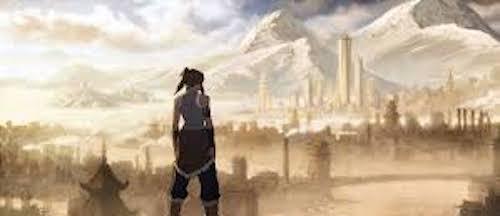
[ID: an image of Korra from the back looking out towards Republic City, which is shown to have large white skyscrapers, a bay, and numerous smaller buildings. Much of it is obscured by fog and clouds. The city is built in the middle of a sprawling bay. /End ID]
1. the setting of LoK is incredibly Americanized and Eurocentric. While ATLA displays a lot of cultural insensitivity towards the cultures it borrows from in choosing how to depict them, LoK...doesn’t really depict other cultures. Republic City to me felt very similar to how 1920s New York is typically depicted in media, and no setting in the Earth Kingdom or Water Tribe was explored enough to really explore the unique cultures of those settings. While you can tell in ATLA that bryke was somewhat interested in (a vague, exoticized, unrealistic vision of) East Asian culture, LoK is very clearly inspired by America and Europe, with very little else influencing how the setting was depicted.
2. there are no “unimportant” people in LoK. Everybody is related to somebody we know from ATLA (or somebody from ATLA), a powerful business mogul, military, somebody high up in the government, a celebrity, and/or the Avatar. The only character I can really think of that’s an exception to this is Kai, who really does not have much of a role. (I guess you could argue that Mako is an exception but y’know...he was a famous pro-bender for a while there) You don’t just get to meet a regular person living in a village anymore. Every character in LoK has political, social, or cultural power.
These points, put together with the technological prowess of the world of LoK (which is different season to season and sometimes even episode to episode depending on how the writers are feeling that day), made the show feel very distant from ATLA, but very, very close to another show that I have watched and loved. And that show is Young Justice.
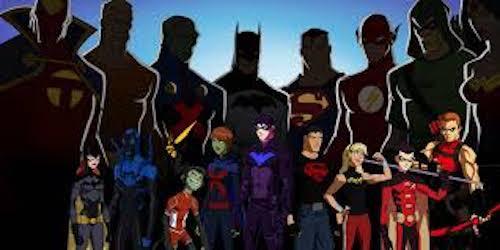
[ID: an image, from left to right, of Batgirl, Blue Beetle, Bumblebee, Beast Boy, Miss Martian, Nightwing, Superboy, Wondergirl, Robin, and Red Arrow in the foreground, posing together. Above them and in the background are the adult heroes, obscured in shadow. From left to right, Red Tornado, Aquaman, Martian Manhunter, Batman, Superman, the Flash, Green Arrow, and Wonder Woman. They are all against a gradient blue background. /End ID]
For those not in the know, Young Justice is a DC animated cartoon focusing on the teen sidekicks, proteges, and relatives of superheroes like Batman, Superman the Flash, Green Arrow, Aquaman, Martian Manhunter, and others banding together to form their own superhero team. YJ is set in America, vaguely, with characters residing in cities with names like Gotham City, Star City, and Central City (a naming convention that Republic City fits right into). And as is apparent from the premise, most of the characters you’ll meet in YJ are superheroes, related to superheroes, or otherwise important business moguls, celebrities, or political figures. And while the world of YJ is of course significantly more technologically advanced than that of LoK, there’s more overlap than you’d think. Besides spaceships, teleportation, smartphones, and genetic engineering, there’s really not a lot of tech that YJ seasons 1 and 2 have that LoK doesn’t.
So you may be thinking, “ok Arthur, we get it, you’re a fucking nerd, what does this have to do with robots?” I’m glad you asked! One of the storylines of YJ focuses on the war between rival tech moguls Tio Morro and Professor Ivo, in which they build increasingly sophisticated androids. Ivo’s are pretty much just designed to kill supers, but Morro’s are expressly designed to mirror the human psyche, and desire to be a part of human society. Amon very clearly also desires a community, and does much of what he does to integrate himself into a community of nonbenders where he really doesn’t belong. Further, Morro’s androids are immune to threats that humans are not immune to because they are not made up of organic matter. For example, in season 1, episode 3, Miss Martian attempts to read Red Tornado’s mind, to no avail, because she can only read the minds of organic beings. In a similar vein, Amon was able to resist bloodbending, and while unfortunately that was not because he was an android, it would have made sense given the conventions of the cartoon android genre. I didn’t realize it at the time, but my previous YJ knowledge very much influenced the way I read that scene. The way Amon’s body was animated very much mirrored the animation of Morro’s androids trying to resist their evil creator’s programming.
So, I’ve taken you through the what, the how, but I promised that I’d say why Amon being an android would have been better, and I plan to deliver. First, it needs be remarked that while Amon being an android wouldn’t have made much sense, it would have only made slightly less sense than the canon explanation of Amon being Tarrlok’s secret brother. In fact, I’d argue that, if handled correctly, Amon being an android could make more sense and be more impactful. Here’s how I envision it: android! Amon would be pretty similar to Red Tornado, in that he would know that he was an android and be programmed to help people. He was of course, built by Hiroshi Sato (that man designed and likely built all the Equalists’ weapons he has the range), who sees himself as a sort of father to Amon. Hiroshi tells Amon about the systemic disenfranchisement of nonbenders and how a Firebender killed his wife, and Amon, being programmed to want to help people and to desire participation in human society, decides he wants to lead a revolution against benders. However, an android can’t very well openly lead a revolution (you could add a bit in the backstory episodes about how humans don’t trust androids or something), so Hiroshi and Amon come up with the story that Firebenders burned his face and hands, which is what prompted him to lead the revolution. Thus, his whole body, including his face, is covered, and his followers assume that it’s because the burns are so bad, and they follow him. In the latter half of the season, the krew would uncover Hiroshi’s involvement with the Equalists, but Asami would be the one to realize that Amon is an android that Hiroshi built. Amon being Hiroshi’s “son” of sorts would be another element of Asami coming to terms with the evils of her family, as Amon in this case would be a machine programmed to be easily manipulated to follow Hiroshi’s cause and would consider himself her brother, and she would have to reckon what to do with both of them. The nonbenders’ cause would still be legitimate after Amon was exposed as an android (unlike it is when the literal figurehead of their movement is also antithetical to their movement) and the heroes would have to reckon with the realities of bender supremacy and the hurt it caused. Amon could even get a redemption arc and work with world leaders to make a better society for nonbenders and androids like himself (I’m sure there’s some parallel you can draw between nonbender oppression and android oppression, though I can’t think of one atm) As an added bonus, Amon wouldn’t be able to bend, so he couldn’t bloodbend Korra, which would be one less time that an LoK villain took away Korra’s bodily autonomy. Amon could even be a recurring character in the later books, because really, wouldn’t LoK have been more fun with a newly-redeemed android sidekick still learning about what the world is outside of his creator’s narrow worldview? Plus, that would give Asami more to do in books 2 and 3 than meet Varrick and participate in love triangle drama (Amon is of course replacing Varrick’s presence on the show), and getting to know and bond with Amon could be the catalyst for her visiting her father in prison in book 4.
Remember, I didn’t claim that this would be good, I claimed that it would be better, and since the bar was on the ground with that secret brothers twist that wasn’t too hard to accomplish. tl;dr bryke are cowards, take the plunge and make him an android.
#still don't understand why bryke cut pro bending after b1#it was genuinely brilliant#i know amon's not a bender but i would want him to be involved in a pro bending storyline post book 1 somehow#longpost#meta#ehhhhh is this a meta tho?#genuinely kind of a stupid meta but once my brain made the republic city star city central city gotham city connection this genuinely#would not leave my brain until i made it#amon#lok#idk honestly i feel like what i wrote is actually more thematically appropriate for an atla sequel series#like found family and redemption and that junk#plus asami could potentially get an arc#if i were writing it she'd get an arc#well generally if i were writing the show asami would get an arc but also specifically with this android thing#tbh if you ask me how much of this is a joke i couldn't even tell you#it is a thing that exists and you can interpret it as a high effort joke or as sincere#it's 2020 cringe is dead
49 notes
·
View notes
Text
i rewatched the entire ice age series and i have opinions
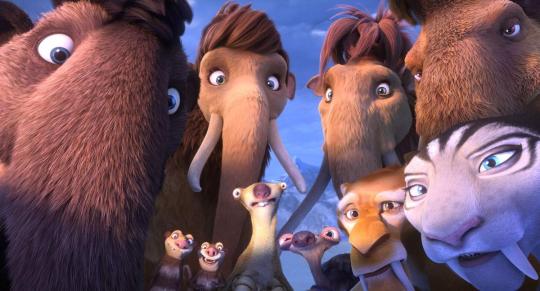
after rewatching some of the madagascar movies, me and @calocybe decided to embark on a quest to watch more animated series from our childhood. an obvious choice was ice age! so, i present to you: finn’s comprehensive ice age opinions masterpost.
read on for an in-depth review of each movie, my opinions on what the series does well (good animation, really fun chase scenes) and what it does not so well (manny is an awful protagonist), and some other things too (like my analysis of queerness in ice age)
first of all, a ranking of the five movies from best to worst:
ice age
dawn of the dinosaurs
collision course
the meltdown
continental drift
first movie
definitely the best
accidental baby acquisition…
it’s just a really good premise. three bros with completely different personalities are forced to work together towards a common goal that doesn’t even benefit any of them personally!
it’s silly and charming and well-written
diego’s arc is especially well-done and it’s easy to follow the way his personality and opinions change
my theory is that they made this movie because they wanted to show off how good they were at animating ice. most of the models and stuff are not very realistically rendered but the ice is honestly pretty impressive
honestly hilarious, has really good visual gags
one of my favorite parts is where they go into the ice cave and find like the ufo and stuff
also the baby does the vulcan hand sign at the ufo which was so subtle and REALLY funny
the ice slide scene. incredible
and then it transitions to the cave painting part with a fantastic depiction of manny’s backstory in a way that’s honestly heart-wrenching??
i wonder if the death of his own family is the cause of his annoying clinginess in later movies, especially with regards to peaches. unfortunately this never comes up again
there are some genuinely emotionally affecting moments in this movie, especially with the humans (when the human woman gives away her baby, when they return the baby to the group) - plus, kudos for conveying all that emotion with no dialogue
this is the only movie where manny’s emotional stuntedness is actually somewhat endearing rather than aggravating
this is also the movie with the most interesting villains - they feel like an especially relevant threat to the protags, and putting diego in with manny and sid creates both good tension and good humor
i wonder why the humans never came back. i think subsequent movies could have benefited from their presence, though i have no idea in what ways. not sure how they would’ve pulled it off but having the baby they rescued in the first movie appear as an adult in a later movie is a plot point that i think would have had the potential to be really powerful
second movie (the meltdown)
pretty underwhelming after the first movie
plot feels disjointed and the climax is weak
i feel like they were trying to go for this sort of found family vs nuclear family / reproductive futurism bent but didn’t entirely succeed and instead made the themes feel muddled. especially after the first movie which was all about rejecting heteronormative standards of family, having manny suddenly go “oop i’m the last mammoth better Reproduce” was a bit jarring
even if he isn’t actually the last mammoth, it feels like the wrong way to start a romance
in general the romance between ellie and manny isn’t very well-done in my opinion.
manny should’ve apologized for getting so offended when ellie freaked out about the pressure to save their species, but instead ellie apologized for “overreacting” for some reason???
number of biblical parallels: a surprising amount??
you’ve got. sid as a jesus figure to the sloth tribe, the ark saving them from the flood, scrat as moses??
the villains in this one were super boring they were just like… evil fish…
ok i’ve said too many mean things about this movie. to atone let me present this opinion: the scene where the vultures sing a parody of “food, glorious food” from oliver completely unprompted is one of the best moments in the series
also the possum brothers are wonderful
third movie (dawn of the dinosaurs)
this was my favorite as a kid!!
it’s still really good
it doesn’t take itself seriously and that’s wonderful. like… dinosaurs? in the ice age? objectively stupid plot. who cares
buck is the best character ever he’s so much fun
buck’s entire thing is also being a VERY cliche kooky adventurer but the way that they play with it and are self-aware about it makes it good
also i legitimately get chills at the scene where he explains his tragic backstory with rudy
god the romance with the female scrat is SO stupid but at least they’re clearly making fun of romantic tropes here
good team-building shenanigans, like the laughing gas sequence
there’s probably something to be said about the ways that family is portrayed in this movie but sorry i’m too busy looking at the scene where they get swallowed by a giant plant and buck has to like cut its veins like he’s diffusing a bomb
also i do need to mention that the scene where they find the carnage of sid’s attempt at feeding vegetables to the dino babies and buck goes off on his whole silly detective-shtick about what must’ve happened (“leaving broccoli… a vegetable!!!”) was my favorite scene in the series as a kid. it’s so wonderfully absurd!
there are a surprising amount of dick jokes in this movie? and by that i mean like 2 but. it’s really funny rewatching this and going “holy shit”
there’s also a joke about a butterfly dude that i’m pretty sure is a trans joke (“i knew that guy as a caterpillar! yknow, before he came out”) so that was also pretty funny
this movie parallels the first 2 by 1. having sid take care of kids and 2. having a group of creatures who copy all of sid’s wacky movements. i don’t have anything more to say i just think that’s funny
buck and rudy are kismeses send tweet
fourth movie (continental drift)
yeah okay this one’s the worst
it takes itself too seriously and that is its downfall
feels tonally off from the other ones
i saw this movie during the height of my hyperfixation on plate tectonics and i remember being very offended at the fact that they made such a mockery of the way it actually worked… :pensive:
(granted, poorly-done science is a cornerstone of ice age, so i can’t really say shit)
anyway this one really felt like a jumble of cliches. the enemies-to-lovers thing with diego! peaches’ teenager problems! manny’s troubles of raising a teenager! all the mean girls! evil pirates! sirens! woooo!
it just didn’t feel all that original and it didn’t play with the tropes like 3 did
what is it in this series with guys not apologizing for their sexism and then getting the girl anyway
also wow. damsels in distress much
sheera’s design is also such a generic “female animal” look
the ape dude was a boring villain and too much of the movie focused on the pirates
okay BUT the sea shanty scene slapped. had some good rhythm and clever lyrics
lewis was good and i’m glad he stayed friends with peaches
the water was well-animated! maybe they made this movie so they could show off how good they were at rendering water
the chipmunk creatures on the island are like knockoff minions/ewoks
in general this movie felt way less funny than the others. less punchy dialogue
fifth movie (collision course)
solidly in the middle of my movie ranking. not as good as 1 or 3, better than 2 and 4
this was my first time seeing this movie! which means that my view of it isn’t colored by nostalgia, and also that i have a lot more to say about it i guess
first of all it’s wild to see how much the animation has progressed… this one was so well-rendered wow
i liked this one a lot more than i expected to! it was a good time, and, like 3, didn’t take itself seriously, which is always great
the whole thing is built off a lot of bullshit science which offends my inner scifi nerd BUT i think they pulled it off quite well
the fact that they got neil degrasse tyson to do voiceovers is just so funny
they’ve firmly established by now that the ice age universe can fully ignore the laws of science when it wants to, especially with regards to scrat and his butterfly-effect influence on the world
okay buckle up because i have a lot to say about scrat actually.
scrat’s ability to influence the universe has been steadily increasing as the series goes on, so it made sense that he would be the catalyst for the apocalypse in this one
and also the catalyst for the creation of the solar system i guess?? which was very stupid. i say that in an endearing way. that beginning scene was super fun & wacky
absolutely brilliant way to bring the ufo from movie 1 back btw
ok so the prophecy tablet thing that buck brings back? he finds it by pressing a button with the outline of an acorn on it and that’s very interesting to me
at that point in the movie i was really invested because i thought that scrat and the protagonists were finally going to be forced to confront each other on the same level. the idea that ice age might finally break its unwritten rule of “the protags can never know scrat as the force of global change that he really is” was legitimately exciting to me, and it seemed appropriate for the last movie in the franchise
unfortunately this did not happen. scrat just keeps doing his silly scrat shenanigans
um anyway let’s talk about some of the other characters!
manny continues to suck. more on this in the “low points as a franchise” section
peaches was actually really good in this one! she’s grown out of her “teenage stereotype” phase and into a character with a believable narrative about growing up and moving out.
her boyfriend is adorable and i was surprised to discover i actually liked their relationship!
sid did not need to be paired off though. neither did diego. what is up with kids’ movies and their shallow heterosexual romances
buck is back and he is fruitier than ever
man i really like buck. he’s so silly and irreverent and flamboyant and it’s like kind of embarrassing to watch sometimes but it’s ok he’s just doing his own thing
the villains were pretty good in this one. i liked how the female dino didn’t have a stereotypically feminine design
on an entirely different topic: let’s talk about the aesthetic direction!
the scifi thing was super fun. like, absolutely wild for a series about the ice age, but whatever. i like scifi
like the whole superpower magnetism shit, especially the scene in the forest? great! especially reminiscent of the climax of the guardians of ga’hoole movie
however the whole dive into the crystal cave environment was a lil tonally dissonant and i think it should have been cut (introduced an entire new world/characters way too late in the plot and didn’t have time to develop them enough, went too far down the rabbit hole of magic healing crystals jokes and all that stuff which didn’t seem to relate to the rest of the story at all, introduced a fun but unnecessary girlfriend for sid, the time could have been better spent making fun of more scifi tropes and developing the villains)
brooke the sloth girl is just miranda from the tempest change my mind also that climax is on a similar level of stupid as that one episode from hoshi no kaabii where they deflect an an entire asteroid using uhhhh cannons i think
but it’s like. whatever. they’ve fucked around with science enough that they deserve this
also i just realized there were no chase scenes in this movie which is so sad??
so there are my thoughts on the individual movies. let’s talk about it as a whole!
high points as a franchise
this series consistently has VERY good chase scenes
just top-tier chase scenes with excellent comedic timing and general pacing
3 is so good because it has a chase as the climax, and that’s what ice age is good at
4 is bad because it doesn’t have a proper chase anywhere!
the animation is really good. by that i mean less like the models are realistic and more that they’re great at conveying emotion and body language through animation
like this is especially true in 1 if you look at the difference between the sort of smooth, not very realistic animation of the humans vs… scrat
like they’ve got the way scrat moves down so well it’s delightful
the movies are, generally, funny
there are good messages about found family, especially in the first couple
low points as a franchise
alright i had a bunch of these written out as universal truths about the series and then 5 actually improved on many of them! so here are some criticisms that apply to the first four movies only:
just… every single female character? they deserve better
too many damsels in distress
all the fat jokes about manny are so unnecessary
the romances are really boring and not very well-written or believable
okay with those out of the way here’s the real biggest issue with the series: manny is an awful protagonist
heterosexual “no fun allowed” man
they keep him sucky so he can have a fresh new character flaw to be worked on in the next movie but that seems like a bad formula for character development, especially how many of his character flaws seem to be related to mistreating the women in his life
the man’s got a major possessiveness issue
he is just the archetypical slightly shitty husband/dad who forgets the anniversary and doesn’t let his daughter see boys and calls women hysterical and yes he does get better at each of the individual problems and he does love his family but that development feels so shallow!
manny is absolutely making AITA posts and getting labeled the asshole
it also feels like he never truly learns from his mistakes. he needs to be learning to apologize properly and most importantly to communicate properly! there’s so little emotional reality to his development and the script always seems to give him the benefit of the doubt when he doesn’t deserve it.
plus, this series is meant for kids and i just don’t think manny is an appropriate or relatable protagonist for that audience?
on a mostly unrelated note, yes i do like the found family themes but when it starts pairing up every single character and implying that all of them are gonna be monogamous het couples and have kids and conform to the nuclear family model. that’s pretty sad
some more random thoughts
my dad once said that ice age fails as a franchise because the premise of the first movie was not strong enough to support sequels. i think i kind of agree - you can see in 2 they’re trying to worldbuild off what little they established in the first movie, and also set up a bigger cast of characters, while still keeping up the “man vs nature” theme that’s such a cornerstone of the series.
i’m not sure they completely succeed. the worldbuilding of ice age isn’t necessarily weak but i do think they could have done more to round out the world and make it feel less like just a prehistoric clone of ours
there’s something about the first movie that makes it feel like a moment suspended in time. we don’t learn very much about the pasts of the characters and they get enough development in one movie that we (or at least i) don’t feel any desperate need to know their futures. it feels complete!
so in all the other movies are working with a set of characters who have ostensibly completed their development. so in each new movie, they need to give the characters more problems. usually this comes from external factors, like new characters. a couple times they do a pretty good job introducing new internal problems for the characters - diego’s quest to get over his fear of water was a pretty good one i thought.
but after a while the main trio just stagnates. diego, once the most compelling character, becomes pretty boring. he doesn’t have anything to do anymore. i’ve already talked about manny - each movie he reverts back into an asshole and it gets old so fast. sid’s a little better; he’s got issues with his family and a desire for a family of his own and all that, but more often than not the conclusions to his arcs are unsatisfying
sid plays the role of the character who’s doomed to never get exactly what he wants, except, like, in a way that’s supposed to be funny. we pity him!
i think he has some archetype parallels with escargon from hoshi no kaabii (why do i keep mentioning hoshi no kaabii) but i am not going into that here oh boy
i feel like i’m juggling a lot in my head right now, but sid’s position as the comedic scapegoat is interesting. i’m sure there’s more to unpack here but i’ve already gone way too deep into this series
there’s also more to unpack when you consider his queercoding hmm
anyway, on that note…
additional thesis: sid the sloth is queer-coded
complicated relationship with family (they hate him and think he’s useless)
lispy voice
cares about “fem” things like children. takes care of kids in both movies 1 and 3. calls himself “mama”
gets pushed into the role of caring for the kid in 1
makes vaguely gay comments at his male friends, like “you have beautiful eyes” to manny
there are literally so many jokes in the first movie like. diego’s “you guys are an odd couple” to manny and sid
that whole part in 4 where he’s trying to kiss the sirens and kisses diego instead and is like “wow romantic”
not interested in the idea of a nuclear/traditional family. see his shenanigans with the dino babies
he is interested in women throughout the series though (bi rights)
5 especially tunes down the queercoding and tunes up the “awkward guy who can’t get girls” angle
so. ice age. is it fun? yes! i definitely enjoyed rewatching the series with my friend. and kids will probably get a kick out of the slapstick and silly dialogue. but if you’re not a kid and looking to (re)watch any of them, i’d probably just stick to the first one.
#ice age#movies#analysis#my post#long post#please clap this is 3k words#i sure do love overanalyzing media that isn't that deep LMAO
23 notes
·
View notes
Text
[QZGS meta] what’s in an OP? dawning glory (pt 1)
or, why TKA S2′s OP is actually really good
{The King’s Avatar season 2 premieres in less than 24 hours!}
(part 2) (part 3)

Ever since I got into The King’s Avatar, I’ve always wondered what a “classic-anime-style” TKA opening would look like. OPs are something I pay a lot of attention to, both for the sheer enjoyment and hype as well as the deeper story and symbolism they may allude to. And although I enjoy the S1 and OVA OPs for what they are, I always wanted an OP that really followed the tried-and-true formulas, an OP that gave a proper look at what the series was really about, an OP that had a lot to dig into and analyze.
S2 brought us this kind of OP, finally, and I’m very excited to see it. Heavily inspired by the “What’s in an OP?” youtube series by Mother’s Basement, I really wanted to try and break down this OP. Because things got very long, this is only part 1; the other 2 parts are linked above and below.
Some of the points I bring up may be reading too deeply, but whether some of these details were intentional or not, their meanings and effects are still worth analyzing. Also as a warning, there will probably be novel spoilers.
For reference, watch and read the lyric translation here.
With all that said, let’s jump right in.



We open with some very nice shots of the morning light streaming in, shining on the gamers’ tools of the trade. Right away, the new animation studio promises us a visual treat - the lighting and colors are excellent. Although the props are unmoving and there are no living beings in these shots, the changing angle of the light adds motion to the scene, giving the impression of a sped-up sunrise. This accompanies the music well, which starts out muffled and distant, and gradually comes into clarity. From the very beginning, the OP grabs our attention and holds it, building our anticipation for what’s to come.
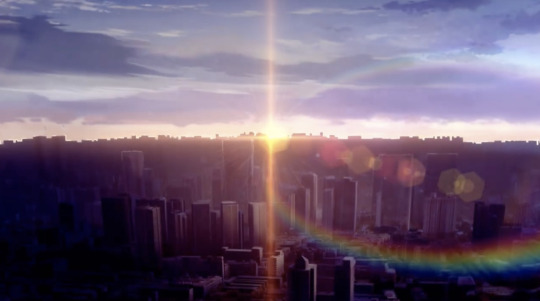

Now we cut to outside, atop a roof, and we get a proper look at the sunrise - only for a brief moment, though, as Ye Xiu’s hand quickly comes up to block the blinding light. “Anime protagonist staring at sunrise” is a pretty common trope, but I think it’s used to nice effect here - we’re introduced immediately to the “dawn” motif that underlies this entire OP (it’s even in the title). It’s a suitable motif for this arc of the story, because this is where Ye Xiu finally has the concrete goal of building up his own team - this is truly the dawn of Team Happy.
I like how it’s Ye Xiu’s hand that’s the first thing we see of him, or of anyone. As a pro, his hands are the most important part of himself; his hands are also one of the first things that Chen Guo notices about him when she first meets him.
Furthermore, this view provides a nice natural transition to the next shot, in which we finally get to see him properly.
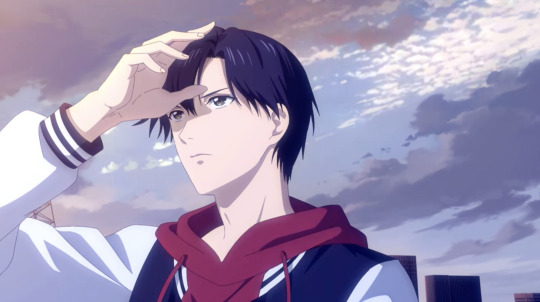

Look at how pretty the sky looks! Look at how pretty his smile looks!
After the first few seconds of pure buildup in the music, the beat kicks in at the exact same time as his hair begins to blow in the wind. I think it’s very important for the visuals and the music to sync together in an OP, simply because of the raw impact this has on the viewer - they reinforce each other’s effects. Both components of an OP need to work well together in order to create something greater than the sum of the parts. It’s just very exciting, when you can sit back and think “oh yeah, it’s all coming together.”
Ye Xiu stares thoughtfully at the sunrise for a few moments, before breaking into a soft, relaxed smile (right on the second four-count after the beat starts). It’s not one of his mocking smiles, or his shamelessly confident smiles - here he’s just genuinely happy and hopeful at what the future has in store.
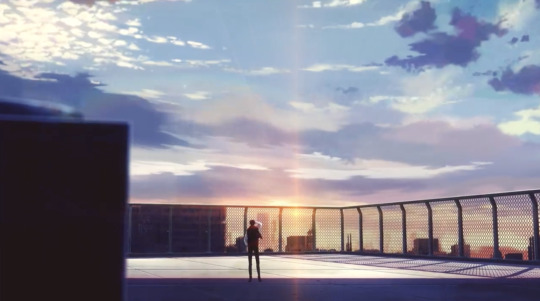

We see him lower his arm, and then the camera pans upward to a shot of the new series logo for Season 2. This pan-up to title card is also a fairly standard technique, but hey, it’s effective and efficient at getting us ready.
Speaking of the new logo: it’s basically the same as the old, but I was shocked to see just how prominent the English title “The King’s Avatar” is now. Honestly, it’s really exciting to see - feels like it adds some legitimacy to our small English fandom, and it’s also so cool, knowing how the title “The King’s Avatar” became the official English name almost by accident - we could have easily ended up with something much less interesting. However I do think they could have positioned the text a little better, because I and others keep reading “The King’s Iavatar” haha

As the dawn shifts more into morning, we refocus on Happy Internet Cafe, the origin of it all. Notice the new green leaves on the tree: our story began on a snowy winter, but we’re now firmly in spring, a time of new beginnings.
The music excitement level settles down a little as we enter the first verse, and here we get a montage of many of the to-be Team Happy members. Although each shot is fairly short, each manages to tell a story, conveying a good amount of information about the character in question. One of TKA’s strengths is its large cast of well-developed characters, and I’m really glad to see that they’re not completely flattened out in this opening montage.
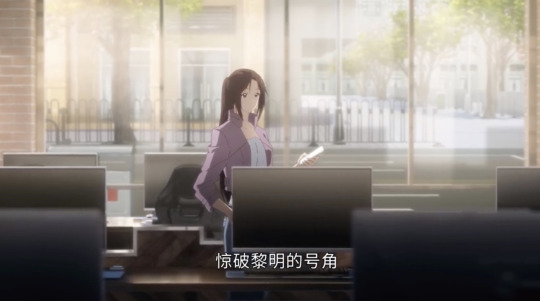
Here we see Chen Guo, presumably opening up the cafe for the day. However, by the time she comes down here to do this, it seems that Tang Rou has already been awake and training for a while.

Like Ye Xiu, the first thing we see of Tang Rou is her hand, a parallel that perhaps emphasizes how deep Ye Xiu’s influence on her is and how she wishes to learn from and surpass him. The nimbleness of her fingers on the keyboard definitely evokes the image of a pianist - a subtle clue for the future.
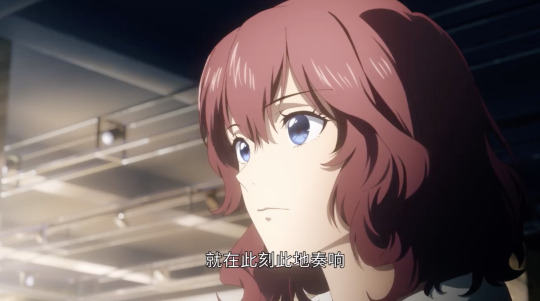
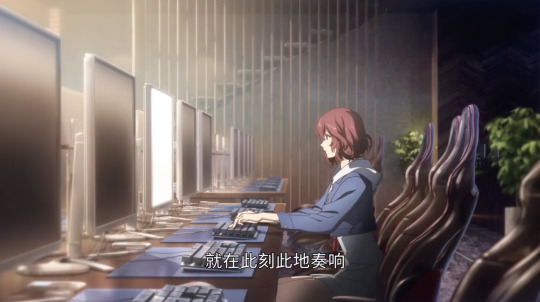
Look at her straightened back and serious eyes - her posture and expression say it all. Awake, alert, steady, calm, as she continues to strive for improvement.
The lyric for this part is roughly, “the bugle call to split open the dawn is sounding right here and now.” As mentioned, it’s here at Happy Internet Cafe that it all begins.
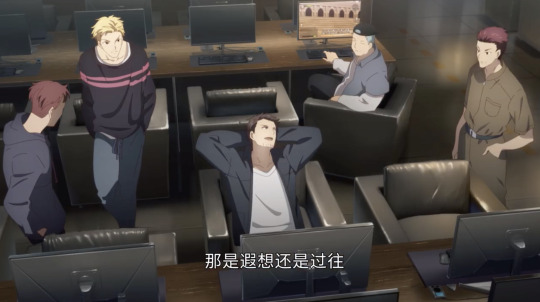
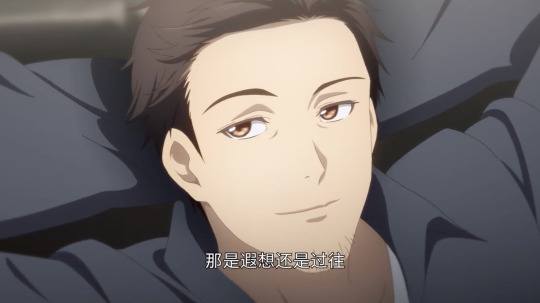

From one internet cafe to another, it’s Wei Chen and his bros! Notice how he’s at the center of their little group, in both position and attention - we immediately get the sense that he’s their leader. Slouched against the couch (which seems to be built more for comfortable lounging than proper gaming), hands behind his head, glancing between his friends, an easy smile, it all gives off a relaxed, casual air of confidence.
Still, in contrast to the seemingly light-hearted mood of this scene here, the accompanying lyric is somewhat melancholy: “were those daydreams or the past?”
When Wei Chen’s character design came out, a lot of people were surprised at how young he seemed to look, and he has barely any stubble. But with this close-up of his face (which is specifically timed to “or the past”), the lines under his eyes are clear to see. Combined with the lyric, there’s suddenly something sad beneath his smile here. He’s not young anymore.
Notice the one screen that’s turned on behind him - clearly an image of Glory. Despite everything, he couldn’t bring himself to leave this world entirely.
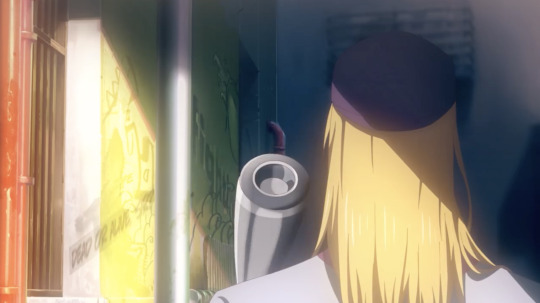

Where the hell is Steamed Bun? Why does he have a bat? We just don’t know. We don’t even have any lyrics to give us a hint. He’s a real-life Brawler, totally incomprehensible. Even the camera shakes a bit erratically as it tries to follow his movement. Honestly, isn’t this just the best way to sum up his character?
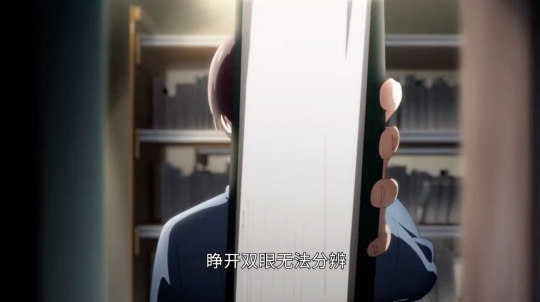

Our favorite math nerd Luo Ji, in a library of course. The shot begins with everything blocked off by the books, and it’s only when he pulls out one of the books (the black-to-light is timed with the lyric “I open my eyes”) that we’re able to see him. He’s still framed by the books in this shot, because he’s first and foremost still a student. For now and for a long time to come, his studiousness and mathematical ability will be what defines him and his contributions to Team Happy.
Still, he looks thoughtfully at the book in his left hand. Maybe his contributions can go farther. Pay attention to his character Concealed Light when we see him later.
I can’t say if there’s a significance to the woman passing by, but it serves its purpose as a transition to the next scene.

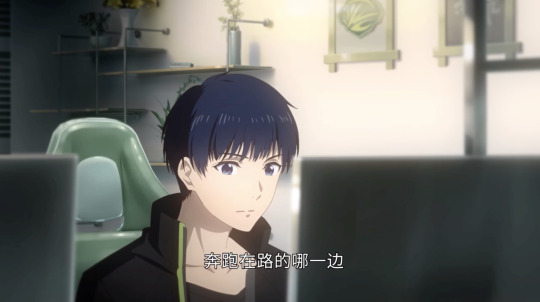
Qiao Yifan! From the logo in the back, as well as his uniform and color scheme, you can see he’s still at Tiny Herb here. He looks determined and focused on his screen at first. When he blinks, though, his gaze subtly shifts to the side and down. Something is distracting him; he’s not quite as certain as he might appear at a glance.
The lyric here is “[I can’t tell] what side of the road I’m running on,” an apt reflection of his current, conflicted and somewhat precarious situation. He’s on a championship team right now, a place that so many would envy. But he feels much more at home with the ragtag crew from Happy. But what prospects do they have? But it’s not like he has much of a place in Tiny Herb right now either…


From Qiao Yifan looking to the side, we cut to An Wenyi looking to the side - our eyes are able to very naturally follow the transition. Although blurry at first, we soon see that he’s looking at a figurine of Immovable Rock - the number one Cleric in Glory, An Wenyi’s idol. He looks at it thoughtfully for a moment, brows furrowed, before turning away and closing his eyes. As though in resignation, knowing he’ll never be able to reach that level.
The lyric is, “do I understand” - a very short line, with the note held out.
An Wenyi is the logical one; he’s the one who understands. He understands his current position, he understands that he has no hope as a pro with his current skill, he understands that the chance Happy is offering him is a once-in-a-lifetime kind of opportunity for someone like him. It’s a decision he considers carefully, he’s unafraid to ask bold questions about the practicality of what Chen Guo and Ye Xiu are trying to do, but in the end he knows this isn’t something that he can pass up.
I like An Wenyi’s character arc a lot. There’s a lot of worry and self-doubt in his expression as he looks at that figurine; there’s a lot of sadness as he turns away. Even through Season 10, this aspect of him doesn’t just magically disappear - he has to deal with this reality of being Happy’s weak point. His logical mind is both his greatest strength and his greatest weakness.

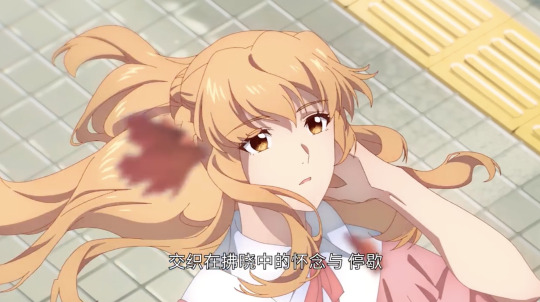
From An Wenyi’s closed eyes, we cut to Su Mucheng’s downcast eyes - another natural eye-focused transition. She looks up as the wind picks up around her, blowing her hair and scattering leaves.
Notice that she’s not wearing her Excellent Era uniform here. Her dress reminds me of her outfit from the prequel movie, actually - color scheme, sleeves, bow, length, cut, etc.
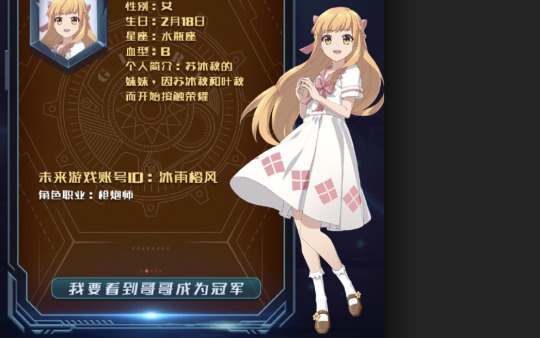
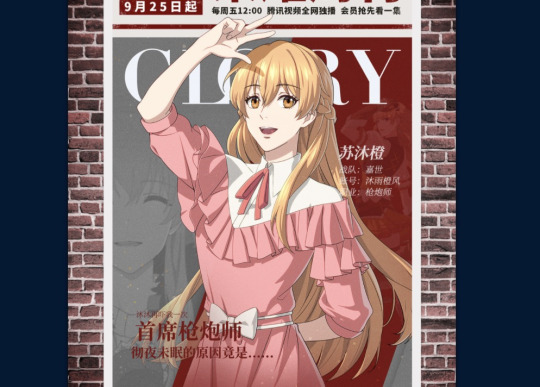
It’s a style calling back to younger, simpler times. The light pink color adds to that effect as well.

As the camera pulls out, we’re able to see just how alone she is, isolated from the cars passing beneath her, not a single other person nearby. And at this point in the story, she really is rather alone; she doesn’t really have any allies on the team, and her only escape is to play in the game with the Happy crew.
The wind is scattering many leaves, and she blurs into the background as the camera focuses on one drifting red maple leaf in particular.
Blatant symbolism is blatant (it’s not even fall right now, it should be early spring…). Still, it’s a convenient shorthand to reference many things. One Autumn Leaf, Ye Xiu’s account and identity for a decade, now snatched away. The symbol of Excellent Era and those earliest hopes and dreams, now lost to the wind. It could even reference Su Muqiu himself, the boy with “autumn” in his name, now lying in eternal rest.
The lyric is, “interwoven in the dawn, those memories and rests.” The past is now past, far out of reach; all we can do is look up and reminisce on what once was.
Over the course of these shots, you can see the passage of the morning. The earlier characters are illuminated by a golden glow, but by the time we reach Su Mucheng, she’s standing in full daylight. Here we end section 1 (verse 1), and move onto the next part of the song.
Thanks for reading so far!
(part 2) (part 3)
28 notes
·
View notes
Photo
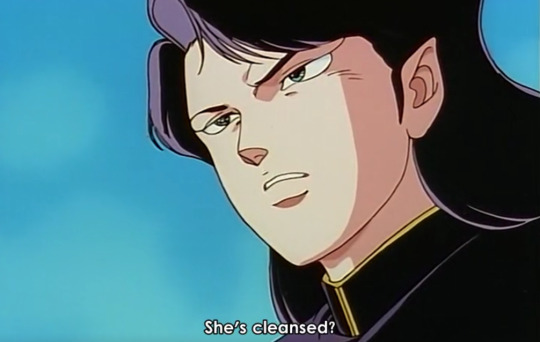
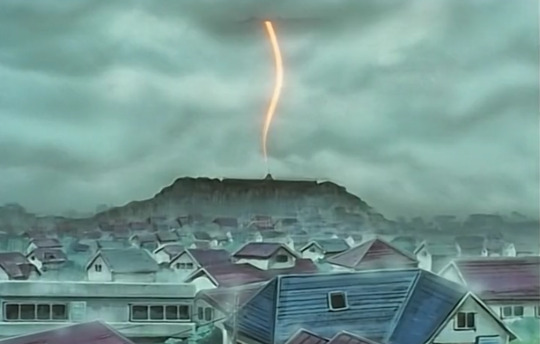
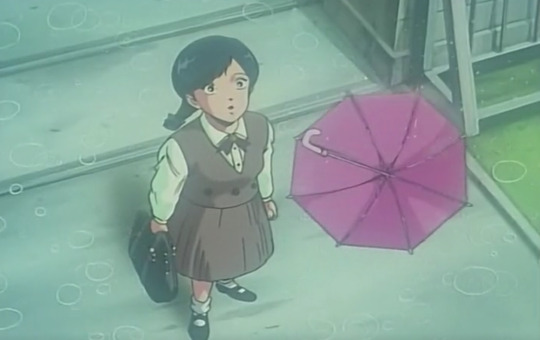
Coming off of true trainwrecks the likes of Mars of Destruction and Skelter Heaven, I actually came out of Dark Cat with a sense of respect and gratitude for its competence.
For the uninitiated, Dark Cat is a notoriously bad OVA from 1991 that you will see listed in many Worst Anime Ever countdowns. It follows 2 brothers, “dark cats” Hyoi and Rui, who investigate supernatural happenings and purify evil with their somewhat undefined powers of shapeshifting and increased strength/agility. The majority of the story in the OVA is about a school girl named Aimi, who is pining after her childhood friend Koizumi, who since the rejection and sudden death of his crush, has been suffering a depressive episode and ignoring her. Hyoi and Rui sense dark forces are manifesting at the school, and they keep an eye on Aimi while fighting off the increasingly brazen appearances of demonic enemies.
A monstrous ex-dark cat named Jukokubo is revealed to be manipulating Aimi with his dark powers, and Hyoi and Rui fight him, but not before Aimi succumbs to the evil magic -- as well as her own violent jealousy and overprotectiveness of Koizumi -- and transforms into a horrific tentacle monster that kills seemingly everyone in the school.
In the end, Koizumi realizes that Aimi was in love with him the entire time, and doesn’t fight her when she engulfs him completely. Apparently this act of selfless love was enough to purify them both, and although they do indeed die, their souls are “light” and able to ascend. This throws a wrench in Jukokubo’s plan to prove that humans are The Worst, so he turns tail and leaves his boss fight against Hyoi, threatening to return again. In the epilogue, Hyoi and Rui reflect on the mission and wax poetic about the nature of humanity while crossing a busy street.
… Ehm… happy ending, yes?
Now then: there are actually quite a few things I enjoyed about Dark Cat, and they are all very simple things that I had come to miss after days of watching other entries from the Bottom of the Barrel.
It had a narrative, and was -- mostly -- comprehensible in its storytelling, as rushed as it may have been. There was an undeniable presence of an art director, something I’m not convinced was present in a few of the other similarly rated titles I have seen. Some of the shots were noticeably well composed and even clever, and required an artistic vision and some decent effort to create. The animation wasn’t awful, the designs ranged from serviceable to genuinely charming (I like the subtlety of Hyoi and Rui’s cat-like features!), and I liked that the characters actually emoted. It wasn’t as generic as I expected and took some risks, even if they didn’t pay off and left it with a reputation of being “too grotesque to be enjoyable”.
I can understand the common criticisms of the gore and body horror being poorly animated, but I won’t decry it for existing and “being ugly”... of course it’s ugly, it’s body horror reminiscent of The Thing from The Thing. (Now would be a good time to warn people not to look this OVA up, unless they are sure they are okay with body horror and gore of this calibre. Tentacles with teeth and spines rip out of people’s skin from the inside and deform their hosts, it is quite awful! I would also include a warning for trypophobia -- there are shots where the mutations form clusters of holes on the skin.) The body horror in Dark Cat being disgusting and making my skin crawl isn’t a fault -- I think it’s the intended purpose. Though I will concede that:
The phallic imagery of the horrific flesh mutations, particularly that of the teacher who attacked Rui, was… bizarre, considering that otherwise the OVA isn’t particularly dark in tone or otherwise sexually graphic.
Perhaps having grotesque body horror is completely unexpected in a story about two bishounen teens (?) who can turn into cats and fight ghosts.
Yes, Dark Cat, the OVA put on Worst Anime Ever lists for being a grotesque spectacle, is just as commonly placed on those lists for being a dumb anime about guys that can transform into house cats and who fight supernatural entities with not so amazing powers. This is a gripe I’ve seen in a few popular reviews, but there was no point during my watching experience that I thought, “Man, these teens are pansies, they don’t even turn into big scary lions or anything! What’s the point, it’s practically a power-down! cinemasins ding” because I don’t go into anime expecting every single male character I see to be Big & Strong & Cool, because I uh… don’t have brain worms I guess? I don’t know what to say about this criticism really, other than people who watch a lot of shounen have very strange hang ups about super powers.
Otherwise, it seems the biggest reason Dark Cat is lauded as One of the Worst -- perhaps even ahead of the silly concept and nauseating gore -- is actually because of the abysmal english dub. It’s my honour to say that I didn’t watch the dub, so it doesn’t factor in at all into my impressions!
So in the end, perhaps my only true gripes with Dark Cat are:
Despite having no particular issue with body horror and gore existing, the extent of destruction and graphic death gave the OVA a bit of a snuff film vibe.
The conclusion to the story was quite bad.
It could be surmised by the brief plot outline I wrote earlier that Dark Cat isn’t a very complicated story. Demons and ghosts exist and wreak havoc on emotionally vulnerable humans, and supernatural soldiers try to mediate between the realms by purifying tortured ghosts and saving those dragged into darkness by evil entities. These beats are common in the supernatural genre of anime, but Dark Cat’s handling of its tragic morality tale left me more confused than anything.
Koizumi didn’t do anything wrong -- he shouldn’t have had to die for the sin of not reciprocating Aimi’s feelings, nor for developing depression after the rejection and death of his classmate and crush. Aimi… did things wrong, but was nevertheless the most compelling character in the OVA. Throughout Aimi was kind, patient, and forgiving when it came to being treated badly by Koizumi. In the finale however, it is revealed that Aimi was the one responsible for Koizumi’s crush’s death, assumedly having murdered her out of jealousy or out of revenge on Koizumi’s behalf for hurting his feelings. Prior to this, the first students to be killed by the tentacle monsters just happened to be the ones that had bullied Koizumi in class earlier that day -- implying that Aimi was getting revenge on them, as well.
It was with these revelations that I started to wonder: Why not just let the flesh monster manifest as a direct result of Aimi’s negative feelings? Aimi confessed to murdering Koizumi’s crush before the events of the OVA -- would she have done so if she wasn’t being influenced by the malignant force set on her by Jukokubo? I feel that her arc would have been much more interesting without the introduction of a non-compelling and badly designed villain like Jukokubo, because then we would know it was all her. Even if she was influenced by forces exacerbating her pre-existing jealousy and rage, that is a more satisfying option than having a big dumb green cat of a villain to trace everything back to so neatly.
And really, what did Jukokubo do in the story beyond take the spotlight, and the blame, from Aimi? He had some previous relation to Hyoi and Rui, but it’s not developed at all, and his ideological rivalry with Hyoi was trivial. Hyoi could have come to the same conclusions about holding out hope for humanity without Jukokubo there to insist he be a guest to debate on his political podcast.
The lack of accountability regarding Aimi is a part of why the resolution to her conflict with Koizumi feels so wrong -- he succumbs to her feelings because he realizes the evil was born from her suffering, and he feels that he has to sacrifice himself to make up for unknowingly hurting her so much that she turned into a monster from hell. In the end she is absolved via being purified and getting to die with her spirit entwined with Koizumi’s, and he apologizes for having not recognized how he was hurting her.
Aimi kills his crush, kills his bullies, and ends up -- inadvertently, at least -- killing almost all of their classmates, because she was tilted about her childhood friend not realizing she had romantic feelings for him. And when Koizumi learns all of this, he apologizes and dies with her, and this is proof of humanity’s goodness? The dark clouds part and the rain stops and Aimi and Koizumi ascend in a heavenly ray of light, because he decided, while she was devouring him, that he was wrong to ignore his murderous best friend’s love for him?
I guess it’s fine -- it was probably mostly Jukokubo’s fault anyway, and everyone was just an unfortunate victim of his meddling… 😒
Other than the bad writing, the string of deaths that happen in the finale when the monster lets loose in the school are quite uncomfortable to behold. Deformed student bodies are splayed and strewn around classrooms, and the bullies are rendered into unrecognizable mounds of pulsating flesh in their homes. The violence of a fight against a monster like this, I can handle, but the graphic images of helpless death were difficult to stomach. And in this OVA, there is no miraculous reversal of the demon’s damage once it is purified -- there is no implication whatsoever that everyone who died isn’t still just as dead as Aimi and Koizumi in the end.
The main thing I was actually worried about when I watched Dark Cat was that there would be sexual assault, thanks to reviewers griping it for “generic hentai tentacles”. I am relieved to say that there is none, at least not insofar as deserving a comparison to actual porn. There is sexual content scattered throughout the horror scenes: The occasionally phallic appearance of the tentacles, shots of the tentacles coming down from under skirts, and there is one shot of nudity when Aimi’s shirt is ripped open as she transforms, though I would say it’s too horrific and ugly to be sexualized or otherwise considered “fanservice”.
What is the point of the hits of sex imagery in Dark Cat? I have no idea. This isn’t Alien, it isn’t about the horror of sexual assault or the violence of creation -- though the main horror of the scene where Rui is ambushed by the teacher seems to be that she uses magic to seduce him, only to reveal a very phallic tentacle from her mouth that she means to kill (or infect…?) him with, which can have multiple, potentially offensive readings… it is a one off, however -- and there doesn’t seem to be any moral posturing about it as is often seen in slashers. I couldn’t parse any sort of consistent STI allegory regarding the plague of tentacles upon the student body, despite how many summaries I have read that describe the tentacles as that, a “plague”.
… I realize I am probably the only person on earth to give any aspect of Dark Cat’s production this much thought. To sum up: It seems to just exist for the shock value. Considering the extent of disgusting imagery already present a la The Gore and Deformation of Human Bodies, I don’t think this OVA benefitted from featuring some explicit looking tendrils, beyond cementing its abhorrent reputation.
Is this all to say that I think Dark Cat is a good OVA? No, of course not. It’s tone deaf, and tasteless, and has awkward pacing and bad writing. But compared to the utterly soulless and artistically devoid works the likes of Skelter Heaven and Mars of Destruction, I would say the fact I was able to write this much about Dark Cat is testament to that fact that it at the very least, contains content -- and some of that content was like, decent! Skelter+Heaven was such a mess it was all I could do to understand the sequence of events, and Mars of Destruction was so bland I literally have no posts about it on the blog despite watching it more than once. Psychic Wars was a snoozefest I barely finished that similarly has no mention on the blog, and Hanoka’s production gimmick couldn’t save it from being a totally forgettable romance story.
Therefore, Dark Cat is the best worst title I have seen thus far, by virtue of being executed with an average amount of competency for an OVA from the early 90s, and for having a balance of good and bad elements that gave me something to hold onto and mull over after viewing.
3/10.
Oh, and I loved the bad 80s insert songs.
2 notes
·
View notes
Text
TV I Liked in 2020
Every year I reflect on the pop culture I enjoyed and put it in some sort of order.
Was there ever a year more unpredictably tailor-made for peak TV than 2020? Lockdowns/quarantines/stay-at-home orders meant a lot more time at home and the occasion to check out new and old favorites. (I recognize that if you’re lucky enough to have kids or roommates or a S.O., your amount of actual downtime may have been wildly different). While the pandemic resulted in production delays and truncated seasons for many shows, the continued streaming-era trends of limited series and 8-13 episode seasons mean that a lot of great and satisfying storytelling still made its way to the screen. As always, I in no way lay any claims to “best-ness” or completeness – this is just a list of the shows that brought me the most joy and escapism in a tough year and therefore might be worth putting on your radar.
10 Favorites
10. The Right Stuff: Season 1 (Disney+)
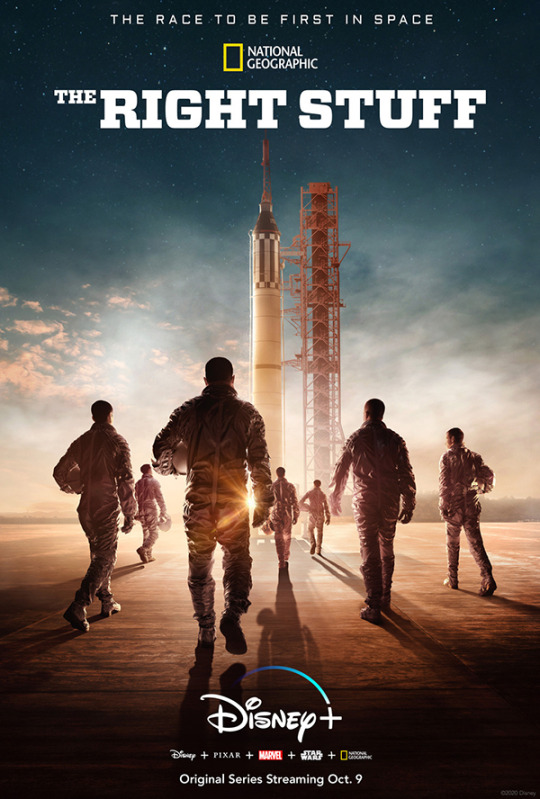
As a space program enthusiast, even I had to wonder, does the world really need another retelling of NASA’s early days? Especially since Tom Wolfe’s book has already been adapted as the riveting and iconoclastic Philip Kaufman film of the same name? While some may disagree, I find that this Disney+ series does justify its existence by focusing more on the relationships of the astronauts and their personal lives than the technical science (which may be partially attributable to budget limitations?). The series is kind of like Mad Men but with NASA instead of advertising (and real people, of course), so if that sounds intriguing, I encourage you to give it a whirl.
9. Fargo: Season 4 (FX)
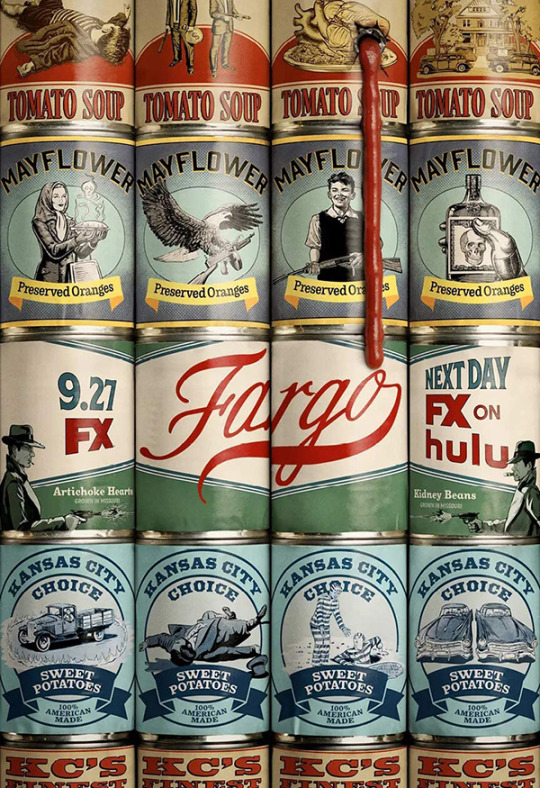
As a big fan of Noah Hawley’s Coen Brothers pastiche/crime anthology series, I was somewhat let down by this latest season. Drawing its influence primarily from the likes of gangster drama Miller’s Crossing – one of the Coens’ least comedic/idiosyncratic efforts – this season is more straightforward than its predecessors and includes a lot of characters and plot-threads that never quite cohere. That said, it is still amongst the year’s most ambitious television with another stacked cast, and the (more-or-less) standalone episode “East/West” is enough to make the season worthwhile.
8. The Last Dance (ESPN)

Ostensibly a 10-episode documentary about the 1990s Chicago Bulls’ sixth and final NBA Championship run, The Last Dance actually broadens that scope to survey the entire history of Michael Jordan and coach Phil Jackson’s careers with the team. Cleverly structured with twin narratives that chart that final season as well as an earlier timeframe, each episode also shifts the spotlight to a different person, which provides focus and variety throughout the series. And frankly, it’s also just an incredible ride to relive the Jordan era and bask in his immeasurable talent and charisma – while also getting a snapshot of his outsized ego and vices (though he had sign-off on everything, so it’s not exactly a warts-and-all telling).
7. The Queen’s Gambit (Netflix)

This miniseries adaptation of the Walter Tevis coming-of-age novel about a chess prodigy and her various addictions is compulsively watchable and avoids the bloat of many other streaming series (both in running time and number of episodes). The 1960s production design is stunning and the performances, including Anya Taylor-Joy in the lead role, are convincing and compelling.
6. The Great: Season 1 (hulu)
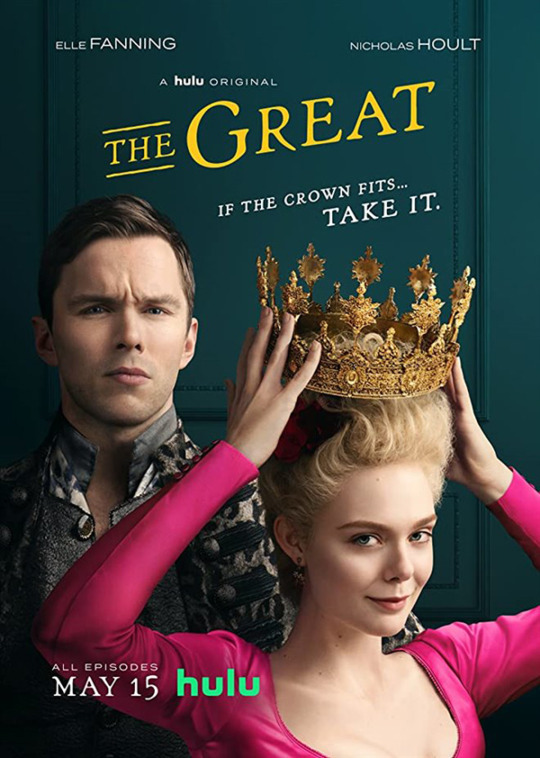
Much like his screenplay for The Favourite, Tony McNamara’s series about Catherine the Great rewrites history with a thoroughly modern and irreverent sensibility (see also: Sofia Coppola’s Marie Antoinette). Elle Fanning brings a winning charm and strength to the title role and Nicholas Hoult is riotously entertaining as her absurdly clueless and ribald husband, Emperor Peter III. Its 10-episodes occasionally tilt into repetitiveness, but when the ride is this fun, why complain? Huzzah!
5. Dispatches From Elsewhere (AMC)
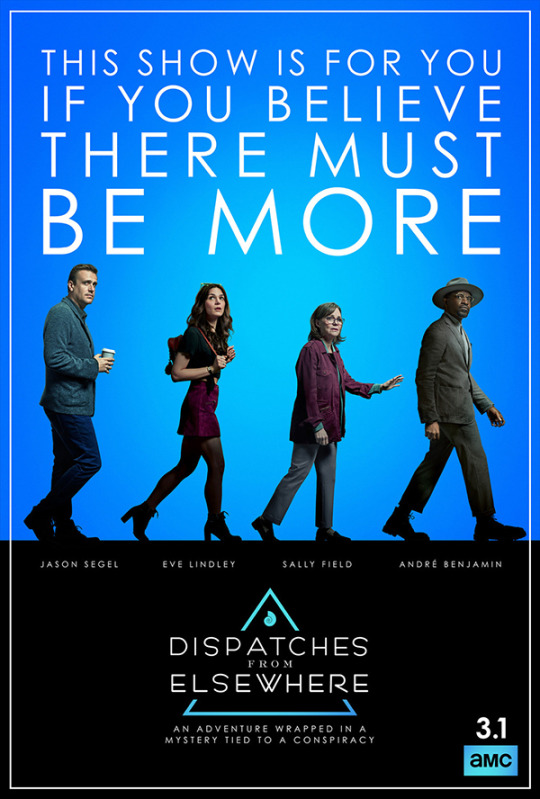
A limited (but possibly anthology-to-be?) series from creator/writer/director/actor Jason Segal, Dispatches From Elsewhere is a beautiful and creative affirmation of life and celebration of humanity. The first 9 episodes form a fulfilling and complete arc, while the tenth branches into fourth wall-breaking meta territory, which may be a bridge too far for some (but is certainly ambitious if nothing else). Either way, it’s a movingly realized portrait of honesty, vulnerability and empathy, and I highly recommend visiting whenever it inevitably makes its way to Netflix, or elsewhere…
4. What We Do in the Shadows: Season 2 (FX)
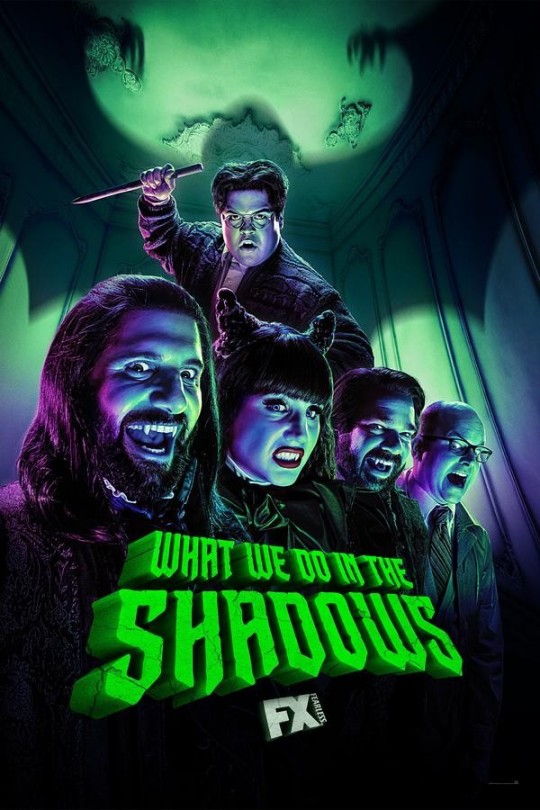
The second season of WWDITS is more self-assured and expansive than the first, extending a premise I loved from its antecedent film – but was skeptical could be sustained – to new and reinvigorated (after)life. Each episode packs plenty of laughs, but for my money, there is no better encapsulation of the series’ potential and Matt Berry’s comic genius than “On The Run,” which guest-stars Mark Hamill and features Laszlo’s alter ego Jackie Daytona, regular human bartender.
3. Ted Lasso: Season 1 (AppleTV+)
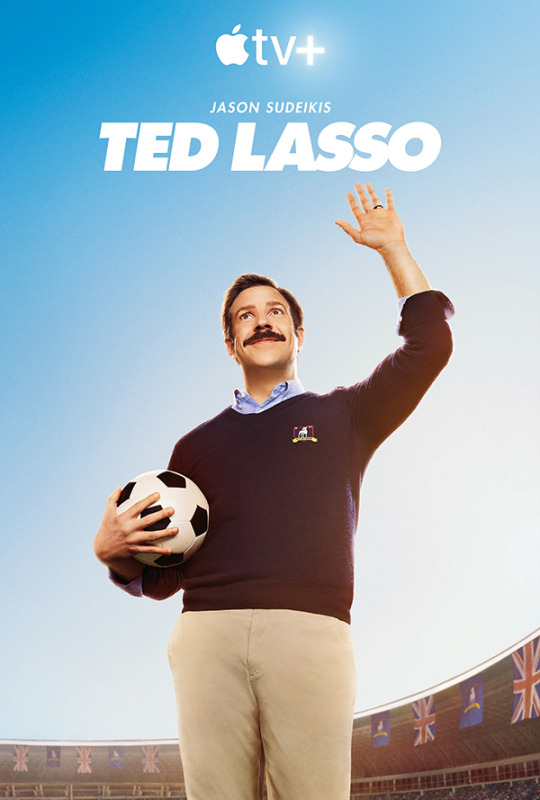
Much more than your average fish-out-of-water comedy, Jason Sudeikis’ Ted Lasso is a brilliant tribute to humaneness, decency, emotional intelligence and good coaching – not just on the field. The fact that its backdrop is English Premier League Soccer is just gravy (even if that’s not necessarily represented 100% proficiently). A true surprise and gem of the year.
2. Mrs. America (hulu)
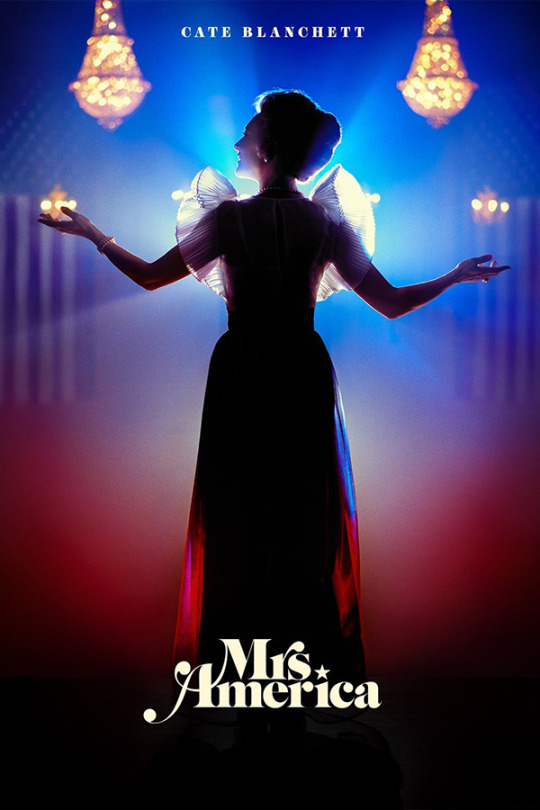
This FX miniseries explores the women’s liberation movement and fight for the Equal Rights Amendment in the 1970s and its opposition by conservative women including Phyllis Schlafly. One of the most ingenious aspects of the series is centering each episode on a different character, which rotates the point of view and helps things from getting same-y. With a slate of directors including Ryan Bowden and Anna Fleck (Half-Nelson, Sugar, Captain Marvel) and an A-List cast including Cate Blanchett, Rose Byrne, Uzo Aduba, Sarah Paulson, Margo Martindale, Tracey Ulman and Elizabeth Banks, its quality is right up there with anything on the big screen. And its message remains (sadly) relevant as ever in our current era.
1. The Good Place: Season 4 (NBC)

It was tempting to omit The Good Place this year or shunt it to a side category since only the final 4 episodes aired in 2020, but that would have been disingenuous. This show is one of my all-time favorites and it ended perfectly. The series finale is a representative mix of absurdist humor and tear-jerking emotion, built on themes of morality, self-improvement, community and humanity. (And this last run of eps also includes a pretty fantastic Timothy Olyphant/Justified quasi-crossover.) Now that the entire series is available to stream on Netflix (or purchase in a nice Blu-ray set), it’s a perfect time to revisit the Good Place, or check it out for the first time if you’ve never had the pleasure.
5 of the Best Things I Caught Up With
Anne With An E (Netflix/CBC)
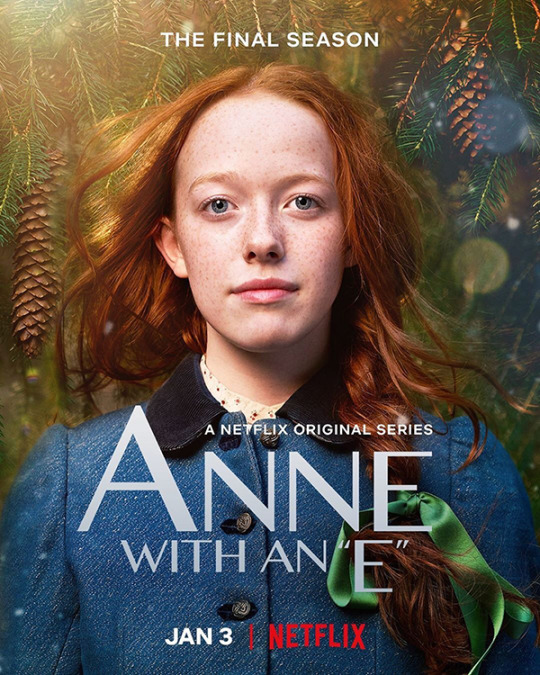
Another example of classic literature I had no prior knowledge of (see also Little Women and Emma), this Netflix/CBC adaptation of Anne of Green Gables was strongly recommended by several friends so I finally gave it a shot. While this is apparently slightly more grown-up than the source material, it’s not overly grimdark or self-serious but rather humane and heartfelt, expanding the story’s scope to include Black and First Nations peoples in early 1800s Canada, among other identities and themes. It has sadly been canceled, but the three seasons that exist are heart-warming and life-affirming storytelling. Fingers crossed that someday we’ll be gifted with a follow-up movie or two to tie up some of the dangling threads.
Better Call Saul (AMC)

I liked Breaking Bad, but I didn’t have much interest in an extended “Breaking Bad Universe,” as much as I appreciate star Bob Odenkirk’s multitalents. Multiple recommendations and lockdown finally provided me the opportunity to catch up on this prequel series and I’m glad I did. Just as expertly plotted and acted as its predecessor, the series follows Jimmy McGill/Saul Goodman on his own journey to disrepute but really makes it hard not to root for his redemption (even as you know that’s not where this story ends).
Joe Pera Talks With You (Adult Swim)
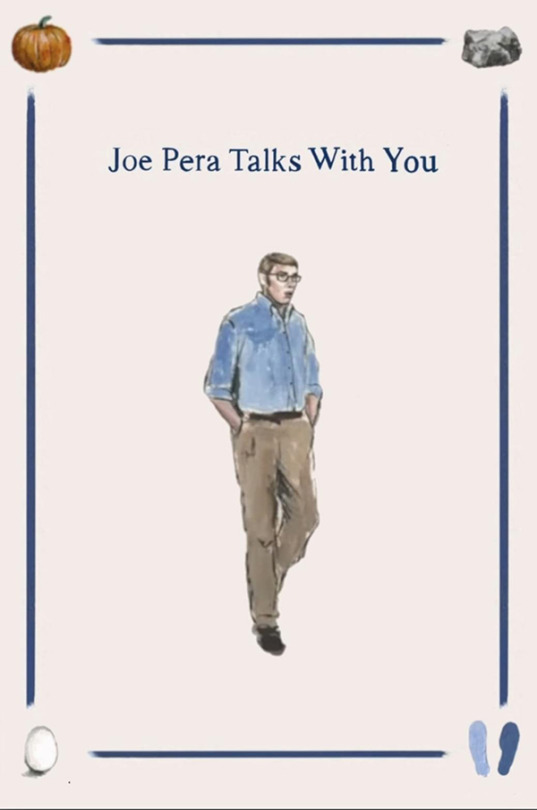
It’s hard to really describe the deadpan and oddly soothing humor of comedian Joe Pera whose persona, in the series at least, combines something like the earnestness of Mr. Rogers with the calm enthusiasm of Bob Ross. Sharing his knowledge on the likes of how to get the best bite out of your breakfast combo, growing a bean arch and this amazing song “Baba O’Reilly” by the Who – have you heard it?!? – Pera provides arch comfort that remains solidly on the side of sincerity. The surprise special he released during lockdown, “Relaxing Old Footage with Joe Pera,” was a true gift in the middle of a strange and isolated year.
The Mandalorian (Disney+)
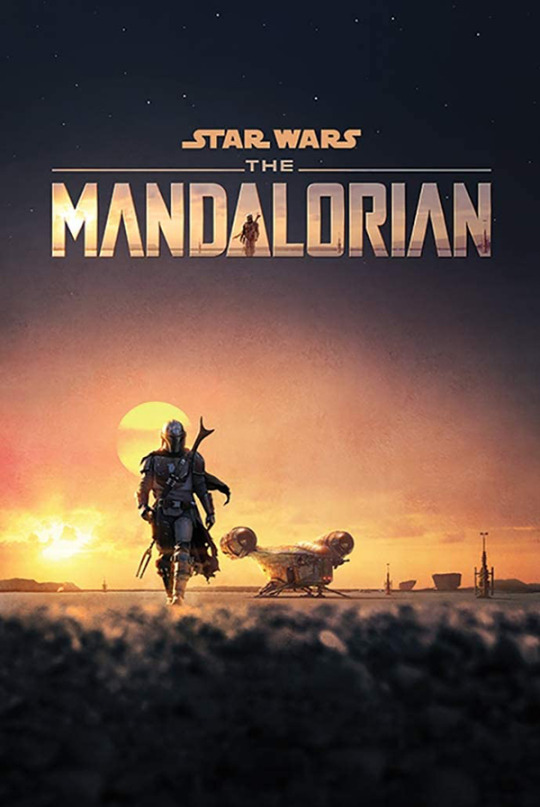
One of the few recent Star Wars properties that lives up to its potential, the adventures of Mando and Grogu is a real thrill-ride of a series with outstanding production values (you definitely want to check out the behind-the-scenes documentary series if you haven’t). I personally prefer the first season, appreciating its Western-influenced vibes and somewhat-more-siloed story. The back half of the second season veers a little too much into fan service and video game-y plotting IMHO but still has several excellent episodes on offer, especially the Timothy Olyphant-infused energy of premiere “The Marshall” and stunning cinematography of “The Jedi.” And, you know, Grogu.
The Tick (Amazon Prime)

I’ve been a fan of the Tick since the character’s Fox cartoon and indie comic book days and also loved the short-lived Patrick Warburton series from 2001. I was skeptical about this Amazon Prime reboot, especially upon seeing the pilot episode’s off-putting costumes. Finally gaining access to Prime this year, I decided to catch up and it gets quite good!, especially in Season 2. First, the costumes are upgraded; second, Peter Serafinowicz’s initially shaky characterization improves; and third, it begins to come into its own identity. The only real issue is yet another premature cancellation for the property, meaning Season 2’s tease of interdimensional alien Thrakkorzog will never be fulfilled. 😢
Bonus! 5 More Honorable Mentions:
City So Real (National Geographic)
The Good Lord Bird (Showtime)
How To with John Wilson: Season 1 (HBO)
Kidding: Season 2 (Showtime)
Unbreakable Kimmy Schmidt: Kimmy Vs The Reverend (Netflix)
11 notes
·
View notes
Photo


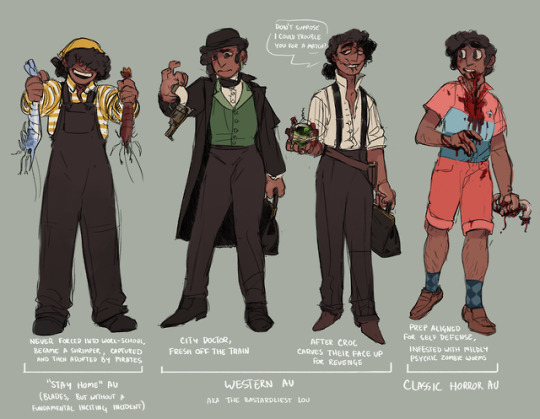
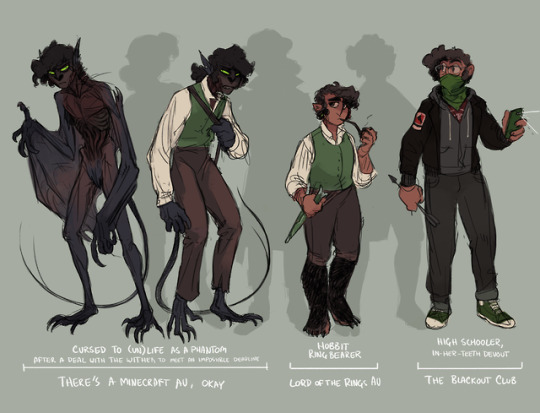
A BUNCH OF LOUS Some demonic force possessed me to try and make a guide to all 700 of my AU Lous. My brain is too busted to let me pay attention to my other ocs so I guess all 3% of my creative energy capacity goes toward iterating on this one. And guess what, I cherish them ALL Short bios/AU explanation under the cut (oops it’s long)
ORIGINAL FLAVOR BLADES LOU: Lou as initially designed, though some aspects of their backstory and personality changed as I got to know them through roleplay. Halfway through the story they took a kinda edgy turn and got deeper into cult stuff and afflicted with a worsening vampiric condition. Right before we ended the game for good, they had just died and come back as a full on, undead vampire.
Fae AU: The first AU, that kinda started it all. Stemmed from a cultist dream thing in Blades, where Lou was the prey in an Erlking-style nightly hunt. In the fae version, they’re a sylph changeling and the only child of a fading fae queen. Their arc in this deals with them struggling with their humanity and nearly succumbing to the soul-sucking influence of their mother, before ultimately restoring her “humanity” and saving themself THROUGH THE POWER OF LOVE Cult AU: Kinda started as a Blades offshoot, coulda shoulda woulda AU where we play with ideas we wish we could have tackled in the game. Quickly became its own thing, set actually on Earth in the Prohibition era (but low magic urban fantasy) Lou is French and was rescued from the middle of a WWI battlefield by Aphotis, a goddess whose own cult had just been massacred. She was as desperate for a believer to sustain her as toddler Lou was to not die. They escaped to America as refugees and Aphotis raised them as her own, and as her caretaker and dirty-work-doer in her quest to regain power. Along the way, Lou was (perhaps intentionally) introduced to an infectious piece of a primordial god, that gave them some shapeshifting abilities at the cost of rapidly draining the life from them and twisting them. Aphotis works to keep them alive, while keeping a memory-wiped copy of them (created by this parasitic god piece) around to do her bidding. This isn’t two instances of Lou, it’s one Lou with two bodies. Same person. My personal story borrows a lot from this AU as well as my character Esther’s old story Mary Sue AU: Initially a joke exercise to write intentionally terrible fanfic (as if Dom were writing about their friends in Blades) that of course became its own thing. Lou is obviously a vampire, with most of the traditional vampire rules and weaknesses. Their Tragic Past gimmick is that they were staked in the heart while still living, as bait for their vampire queen mother. It worked, she turned them postmortem, and as a result they are much weaker than a typical vampire. They also suffer a curse to stay within the bounds of their family’s ancestral castle, which has since become a prestigious university. They also become a fluffy black cat-bat thing either at will or when too weak to sustain a full sized body. Their line of vampires usually turns into cats, but Lou is a fuckup Pirates AU: Pretty straightforward. Lou is called June in this one, and is the mutinous first mate of Captain Inkblood (Cookie), who totally does it for attention. Their secret is that they became a pirate to dodge student loan debt. Stayhome AU: “Blades, but what if the formative incident for your character never happened” Lou never gets caught by the Governor’s program to round up street urchins and send them to work-school, and instead ends up working on a shrimp boat. They never develop the world-weariness and scheming nature of canon Lou, instead devoting their intellect to learning everything about shrimp, shrimping, and shrimp boats. Insert Forrest Gump scene. Eventually their crew gets captured and ransomed by pirates, but no one ever pays up for Lou, and they end up pretty happily living with the pirate crew Western AU: Gee I wonder why this big city doctor picked up and moved all the way out here to the frontier, it couldn’t possibly be because they’re running from the law. Narrator voice: They Were. Lou is a terribly unethical doctor with a reputation for experimenting on patients, and a taste for arson. After getting chased out of town and blacklisted all over the west, they find themself joining an outlaw band, as their doctor. Here, they start to learn compassion and humanity and not being a total bastard... ...until they somewhat accidentally burn a particular bounty hunter’s face off with a firebomb, and she carves them up in return. From here on, their arc is a test of their learned compassion and breaking a cycle of bloody revenge. Horror AU: Starts off as a classic summer slasher movie, with Lou as a college student with a bunch of shitty “friends” destroying a campground and partying until they draw the local monster’s ire. The monster (Dom) kills several of them, kidnaps Lou after Lou hides their fear behind sass and clearly isn’t like the destructive campers. Lou learns more about the monster and even starts to warm up to them, especially after discovering they can boss the monster around. Lou successfully escapes but runs right into a horror swamp where a nasty worm zombie pukes worms into their mouth and infests them. As the infestation progresses and nearly kills them a few times, Lou learns that the worms are intelligent and actually adore their host, and also that they can be bribed. By the end of their arc, Lou has mostly achieved symbiosis with their worms and avoided becoming a zombie,. They eventually must face off against the monsterified Queen of the Preps, Tiffany, who was similarly infested but never achieved that symbiosis. Minecraft AU, no really: Lou was a skilled tailor, and a total workaholic. Their ambition netted them a contract for a huge order of clothing for a duchess’s wedding on an extremely tight deadline, and Lou, knowing this could make them for the rest of their life, poured everything into it. They worked themself literally to death, dying of sleep deprivation. Distraught, this unfinished business drove them to make a devil deal of sorts to keep working, and they were granted this undeath, for a price. They slowly became more and more like a Phantom as they worked, never sleeping, and feeding on the dreams of those who do sleep. By the time they finished and emerged to present their achievement, they were monstrous and were chased out of town. From then on, they had lost their passion for their craft, and wandered the wilderness, sneaking into towns at night to feed on dreams, and fighting to retain their humanity as they become more and more phantom-like. Anyway I love this one so much I might make them their own non-minecraft character LotR AU: Lou is a hobbit, entrusted with the destruction of a certain magic ring. Unfortunately, they are much more corruptible than one Frodo, and early on abandon their fellowship, driven by paranoia the Ring has been growing within them. They run into a feral Mirkwood elf raised by giant spiders, and a giant orc raised by a Beorning farmer, and the three of them embark on a weird little Ring Quest of their own. TBC AU: Lou is a quiet, social outsider high schooler, with a bitter hatred for bullies and a knack for really disproportionately nasty “pranks” directed at said bullies. Too smart for their own good and with a taste for theft, Lou is a straight-A student who has been arrested for carjacking before. They end up as part of the Blackout Club after discovering their adoptive mother’s involvement with the Chorus, and out of sheer curiosity about the secret goings-on under the town. And in no small part for free run to break into houses and smear chili oil on the hands of sleepers who inconvenience them, because Lou is a bastard and has yet to learn empathy. Which, as usual, is kinda their arc here. Make friends for the first time in their life, learn empathy, get sucked into the orbit of a fairly nasty god/Voice, classic Lou stuff AND THAT’S ABOUT IT
714 notes
·
View notes
Text
Psycho Analysis: Yzma
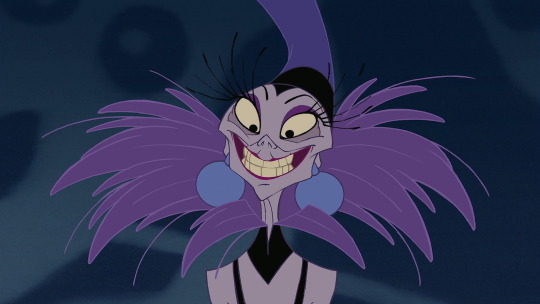
I feel like there’s no sense in introducing this one. You know her. I’ve seen all the gif sets, the quotes, the images, the memes… it’s safe to say most every person on the internet is intimately acquainted with The Emperor’s New Groove’s geriatric villainess, Yzma. So, let’s just cut to the chase and talk about why Yzma is a fantastic villain, shall we?
Motivation/Goals: Yzma’s goal is pretty simple and yet also infinitely understandable. She wants to take over the kingdom from Kuzco because, after years of being treated like garbage by the snotty little emperor she likely helped raise, he’s just firing her because she’s old and ugly. Like, it is TRUE, but it’s still incredibly tacky and rude. It’s not hard to empathize with her at least a little bit as she goes to poison the snotty, miserable emperor, though it really does become harder to side with her as the movie goes on and she continues to berate her poor manservant Kronk.
Performance: The legendary Eartha Kitt of Adam West’s Batman and My Life as a Teenage Robot fame gave Yzma exactly the voice she needed to instantly ingrain herself in your memory forever. Kitt was absolutely not afraid to ham it up, and combined with the character design and animation, it makes Yzma a delightfully over-the-top figure that is easy to love to hate. Even better, she has insanely good chemistry with Patrick Warburton as Kronk, and the two play off each other extremely well, leading to Yzma being part of a good 95% of the movie’s funniest scenes. It helps that, while she is definitely very funny, she is more often the straight man reacting to the insanity her compatriot brings to the table, a dark mirror to Kuzco and Pacha’s relationship… well, comparatively dark. These two are a couple of goobers after all. What I think really helps is that, despite being the straight man in a general sense, Yzma is still probably one of the most insane villains in Disney’s filmography, as in literally unhinged, so she is as able to generate laughs as anyone else.
Final Fate: Yzma’s attempts to kill Kuzco backfire spectacularly, and instead of succeeding in any way, shape, or form, she ends up turning herself into a cute little kitty. It’s a marked improvement, honestly. How she changed back to normal for the TV series, who can say? By all accounts it doesn’t make sense. Just don’t think too hard about it, it’s a comedy after all.
Best Scene: Considering how the entire climax of the film is an absolute cavalcade of comedy, we could go with that. Or we could go with her attempts to poison Kuzco at dinner. Or we could go with her interactions with Pacha’s family. The “problem” with Yzma that every scene with her is so great that it’s hard to single out any single one moment as outstanding, because all of them are pretty much on the same level. She’s remarkably consistent with how great she is.
Best Quote: It’s really hard for me to pick just one line (which is something I tend to say a lot, but I mostly talk about good villains on here, so cut me some slack), but I think the combination of the delivery and just how great Kitt’s voice was really helps make her brainstorming ways to kill Kuzco a legendary moment:
“Ah, how should I do it? Oh, I know. I'll turn him into a flea. A harmless little flea. And then I'll put that flea in a box, and then I'll put that box inside of another box, and then I'll mail that box to myself! And when it arrives, AH HA HA HA! I'LL SMASH IT WITH A HAMMER!!! It's brilliant, brilliant, BRILLIANT, I tell you! Genius, I say!”
The laugh is really what sells it, honestly.
Final Thoughts & Score: Yzma is probably the single greatest Disney villain who doesn’t totally follow the Renaissance villain format post-Renaissance, with only Turbo really being a contender for the crown. What I mean is this: the Renaissance set a serious precedent for animated movie villains going forward. They had to be hammy, have huge personalities, and get their own song. Ratigan was something of a prototype, and then Ursula went and set the standard. Sure, there were exceptions in the Renaissance – Hades is great but got no song, and Ratcliffe is… Ratcliffe, and he has a song – but for the most part the best Disney villains had a clear style. Ursula, Gaston, Frollo, Scar, all of them are some of Disney’s best and all of them stick to these rules.
Yzma came early in the post-Renaissance era so it would make sense for her to fit the bill entirely while they were still experimenting with new styles, but because of the tumultuous production of The Emperor’s New Groove, she ended up keeping the ham while having her villain song cut. And yes, this is a damn shame, since Eartha Kitt was a fantastic singer and the song’s not half bad, but I think the movie as a whole and Yzma herself work better without music. She’s just so funny with how she reacts to and interacts with things throughout the movie, I just don’t think she really NEEDS music to really push her over the top in terms of quality. Like, let me put it this way: I think, without “Be Prepared,” Scar would probably not be quite as impressive. I think with a villain song, Jafar would have been even cooler. Yzma? She’s pretty much perfect the way she is.
I debated a long time on what score to give her, but I frankly think she does deserve a 10/10. I almost gave her a 9 on the basis that she didn’t have a song, but her overall performance combined with my realization she didn’t need her song to be great made me decide to reward her with the highest marks. However, there is one criticism I have that I think stands: she would not nearly be s funny if not for the presence of her faithful lackey. So let’s talk about him, shall we?
Psycho Analysis: Kronk

I put this one to a vote, and it turns out that a lot of people consider Kronk a villain. I guess if we’re being technical he is an antagonist, but a villain? Kronk is pretty much the least evil villain out there. Still, it’s pretty impossible to deny that he’s not exactly a good guy when he’s complicit in an assassination attempt. Kronk’s a bit of a morally gray figure for much of the film.
He’s also, without a doubt, the funniest character in the film.
Motivation/Goals: See Yzma above. He’s just her lackey, so he doesn’t have much in terms of goals of his own. He does, however, have a conscience, as well as numerous skills including some serious culinary skills, including knowledge of fry cook lingo.
Performance: This is one of the roles that really put Patrick Warburton on the map, alongside Joe Swanson in Family Guy. And if I’m being honest, this is the definitive Patrick Warburton role in animation. Kronk is just an absolute delight to watch, since he’s basically the lovable idiot character perfected. He’s a ditz, but he does have a lot of skill in some interesting niche areas, he’s not truly good or evil and has a moral code, he’s very quotable and funny in a pretty natural way… Kronk has got it all! And it’s all thanks to Warburton injecting that Patrick Warbuton-ness we’ve all come to love from his performances.
Final Fate: Of course Kronk gets redeemed in the end. The dude is the biggest softie on the planet. Maybe Yzma should have thought twice before insulting his spinach puffs.
Best Scene: Kronk has a similar problem to Yzma, where every single scene he’s in is incredibly perfect, but unlike Yzma, there is one scene that really narrows things down and gives you the perfect summation of Kronk as a character: the scene where he is attempting to dispose of Kuzco’s body, does his own theme music, argues with his shoulder angel and shoulder devil, and then ends up saving Kuzco, thus allowing the rest of the plot to happen.
Best Quote: Unlike Yzma, there is no way I could possibly narrow down Kronk’s best quote. Whichever one is your favorite, you’re right. That’s the best one. Everything out of his mouth is gold.
Final Thoughts & Score: Kronk is a very interesting lesson when it comes to Psycho Analysis because, while he is certainly antagonistic, and certainly is a great character, he’s not a great villain, which is what these reviews are for. Like, he is easily the best part of the movie, he is hilarious, his chemistry with Yzma is undeniable, and this is Warburton’s definitive vocal performance in animation… but it doesn’t make Kronk a good villain so much as it makes him a good character. Like there’s no way I can give him below an 8/10, because again, still an antagonistic role, but he can’t score much higher because his personality is just so legitimately NICE that calling him a villain seems really weird (which is why I put it to a vote in the first place).
I really can’t stress enough how much I love Kronk; he’s like in my top 10 favorite Disney characters. But when it comes to villains, I really don’t think he’d make the cut, because even when he is doing something bad it comes off more as misguided loyalty to Yzma than an actual desire to do bad. It’s really telling that it’s the most petty of things that makes him drop Yzma like a hot potato: Kronk was never really a villain, he was a good guy who made poor life choices and had a toxic friend influence. He didn’t really have a character arc where he became a better person like Kuzco did, although Kronk’s ultimate turn to the side of good does somewhat mirror Kuzco’s; he simply realized that the friend in his life he devoted his time to was an awful person and decided to leave her behind, and when all is said and done, that just leaves a big, buff nice guy who likes to cook. And that makes Kronk a truly great, funny, and lovable character.
It just doesn’t make him a great villain.
57 notes
·
View notes
Text
Antagonist: Buggy (East Blue - And Before This Time Frame)
At first, I was still on and off about my decision on whether or not I would make an analysis on Buggy at all. My analysis pages aren’t necessarily about the villains of One Piece in general, but more towards humanitarian or misanthropic topics reflected in their world from ours. In the first few appearances, I thought I had nothing to go off from, at least in context of World Issues. But I started writing out his characteristics and anything known about his past that could reflect on it, and then I started writing on something to reflect later after writing out other analogies with other villains and their world.
Characteristics:
Stereotypical behavior of a pirate
Narcissism: Blames others for his mistakes (Shanks)
Treats a majority of his underlings as replaceable/worthless
Alignment: Chaotic Evil/Neutral Evil
Worthy Notes
He was one of the recognizable characters who witnessed Roger’s execution up front.
Before this, he knew him personally and grew close with his captain.
To me, he and Shanks are friends/crewmates that had similar circumstances but different outcomes - two sides of the same coin (Important Distinction).
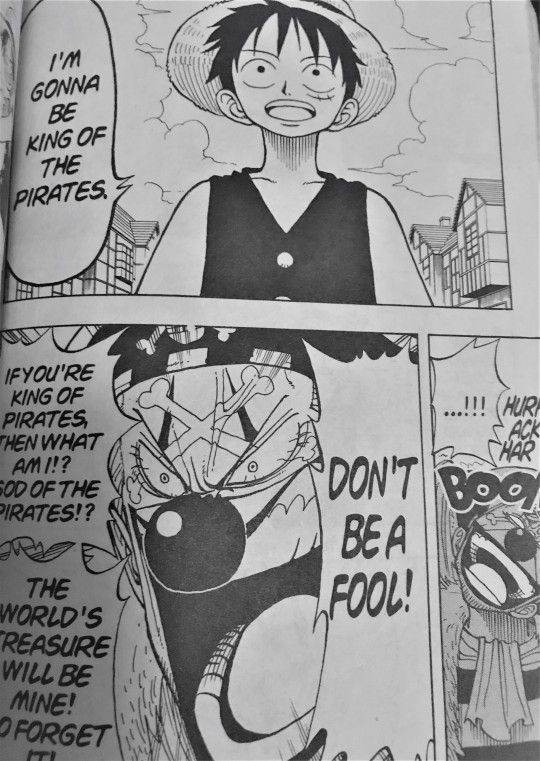
Buggy is a character that I both dislike and love for various reasons. If there was a person, who had a striking resemblance to him (in both looks and especially personality), there is a 100% chance I would not get along well with him. The arrogance, laugh, and overall characteristics of a narcissist that gets his ass handed to him in nearly every encounter is annoying to the point of wanting to punch him personally.
However, he also handles many of his problems and the crazy reality that is their world with great comic relief like a majority of the characters. He himself has great one-liners and funny encounters that make him a great antagonist towards Luffy and an overall character of One Piece.
He’s one of the few designated antagonists of the East Blue Arc that popped up later, not only in the same arc, but in other arcs afterwards. Alvida does as well but she isn’t treated very much like an antagonist after Loguetown. More mild and laid back as Buggy’s vice captain, without straying from her original personality.
The thing about him from the beginning is how iconic of a character he is, mixed with some stereotypical personality traits as the main character’s villain. With the listed traits above, he actually isn’t the most original kind of villain under a broad definition.
I use the moral alignment chart for these analysis and/or characters because it’s one of the easiest ways to place and understand the foundation about them. For Buggy, he could go either way for being neutral or chaotic in the evil row. He does things for his own gain. But he also does evil acts because he is under the notion that he can with no other reason. Many of the East Blue antagonists are essentially like this.
Before knowing anything about Buggy later on, and even after, I would put him in the same boat as Krieg and Arlong. These are very chaotic pirates who also display typical pirate personas. Greedy, foul playing, captains without any remorse or care for others (although Arlong, towards fishmen and crew mates, tends to be an exception). They appear to not have an underlining motivation to be the way they are. Just regular, run-of-the-mill pirates.
But taking in consideration his past affiliations on being a cabin boy to Gol D. Roger, his attitude, in tune with Arlong’s, makes a lot of sense.
The start of the Pirate Era sparked a grand affiliation to the massive sweep of pirate crews to take to the seas. A historically popular phenomenon done in a way that no other sailor accomplished the way Roger did: conquer the Grand Line. When an ever-changing event like this occurs, you have a mix of on-lookers who are changed by this. Characters like Luffy are filled with adrenaline. A need to seek adventure, making him the perfect predecessor for Roger’s Legacy, but in a way where he can call it his own.
Then there are characters like stereotypical, unnamed pirate crews, a majority of which mainly focus on the prospect of Roger’s treasure One Piece. They physically have nothing to tie them down, so they feel it necessary to pursue that challenge. This sparks greed or a search for infamy, something that actually connects to Ace’s motivation the most, but he has a more dynamic change that alters his motivations. Compared to others, this change is due to an instance where he is showed an alternate approach on life and dreams, a somewhat more healthy version. But when this alternate approach isn’t introduced to others, they are bound to the same mindset, installing more harm along the way.
The known reactions are like two sides of the same coin. They’re broad chances of what someone will turn out in response to this freedom on treasure hunting and adventure seeking. And the two characters that are on those sides are Shanks and Buggy.
Personally, I find this to be an excellent coincidence. Now whether Oda intended for there opposing characters to mean anything significant is up for debate. But my interpretation proceeds them as the differing approaches when they (1) lose something significant in their life and (2) in retaliation against the unfair advantages life threw at them.
Buggy takes on the evil, greedy and infamy route in response to Roger’s execution.
As selfish as he is, Buggy did care very much for his past Captain. Most likely as a father figure of sorts considering he was rather young when he first joined as a cabin boy. He was able to make bonds with the crew mates, showing the more humanistic side of him.
In the events of Roger’s untimely sickness and later execution, I say it created an unfathomable emotional downfall on Buggy. In love and loss, it can have a negative influence on someone. He doesn’t seem to stray away from a greedy persona even with the Roger pirates. However, they acted as a sort of buffer, suppressing that intent need enough where it tends to affect only him.
With instances like Orange Town in Episode 5-8, his greed has an outward impact on the people and environment. I doubt he had any monetary reasoning for docking in the small town. There could have definitely been some looting, but that probably wasn’t their main purpose. It seems more along the lines of a power move.
Throughout his stay, he ultimately uses his Buggy Balls to obliterate different sections of the town, describing it as “his idea of fun.” Now whether because he lacked the resource or motivation, he never seemed to be this destructive as a younger cabin boy. He was still capable of violence and only doing so when needed.
He offers insight about the potential in taking on negative behaviors against the world, in combination of this obtainable freedom. He takes it with a motivation in the form of retribution.
Now how does Shanks play into this?
I said before that these two are like the sides of the same coin. And this is how far it goes:
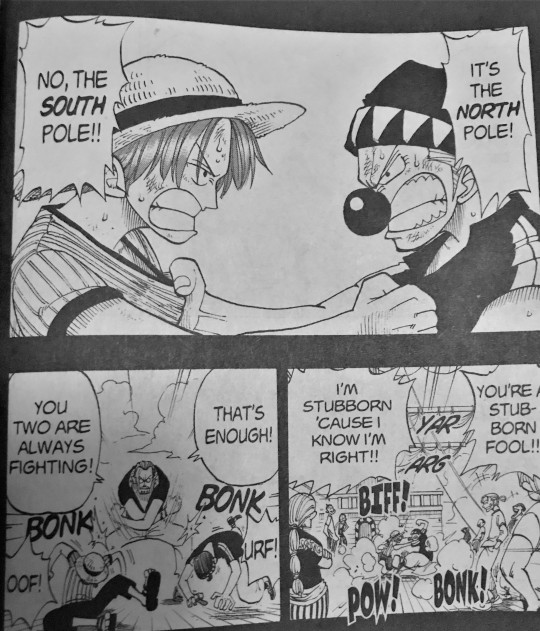
They, literally and figuratively, were on the same boat. That being the Oro Jackson’s crew and witnessing first hand Roger’s execution.
Unlike Buggy, however, Shanks wasn’t affected in a downward spiral of vengeance. Where Buggy took on the active persona of a vindictive route, he took to Roger’s will. The concept of inherited will within One Piece is a powerful notion. Especially with how it plays into the influence of a character and the world around them.
Roger’s will is directed more towards the importance of adventure and unbridled freedom. Doing something for yourself and “destroying” the world in a round-about way.
He is the opposite of Buggy by choosing the path of piracy in leniency. He isn’t necessarily upright and morally good in all regards. Because I’m certain he could have done bad things. But his outlooks on life make him move forward from the past.
Meanwhile, Buggy is situated into his past persona, and possibly due to the loss of his captain, by striving to be the King of the Pirates. Buggy has a connection to it that many others wouldn’t have known about until around Sabaody and Marineford. This need with the title is one of the defining elements of being greedy to an unexpected turn in his life.
This plays in well with his narcistic attitude in blaming others for mistakes he’s made in the past. Specifically where he blames Shanks for “making” him accidently eat his devil fruit. While he does find a use in his powers, he remains to be bitter about it. A reaction like this shows a character that ties himself with things he wish were different, believing that acting on them in the future will somehow change it. And about the only way he finds some use in it is fulfilling his desire to be at the top. A familiar form that ties him to Roger in the past.
Of course, I’m not implying that Roger’s death sparked his greed, because it is quite obvious he was always like that. No, it’s more of he represents the expected type who find satisfaction in titles. The expected results of Roger’s last words that the world paints into perspective. Buggy’s the negative aftermath that people expect when the world changes.
Because in simplistic sense, change begets destruction.
Change creates numerous responses that guide people, and it can be interpreted in broad groups. The results of these events divide people and their motivations, creating a diverse but also destructive world within One Piece.
~~~~~~~~
#one piece#analysis#themes#manga#world issues reflection#antagonist reflection#honestly this is me rambling trying to make a clear point#one piece analysis
3 notes
·
View notes
Text
Spider-Man: Into the Spider-Verse (semi-stream of consciousness) Thoughts Part 3: Spider-Miles and his Amazing Friends/Foes
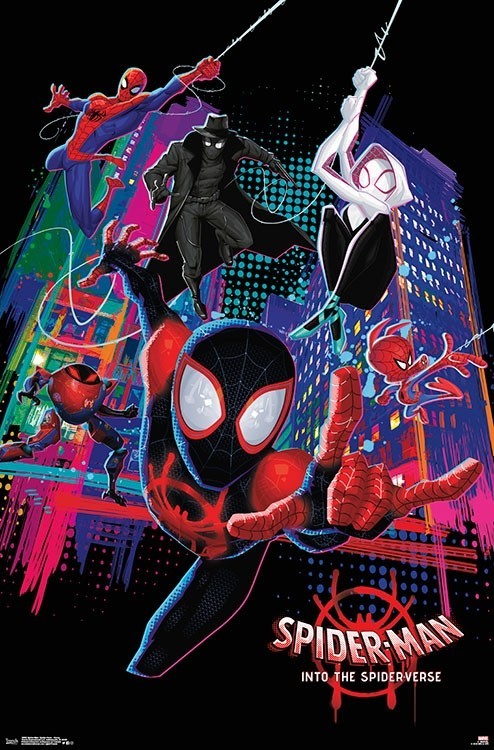
Apologies for not getting this out sooner. I’ve been/still am unwell so I was physically too energy drained to crank it out.
For this outing we’re going to discuss the characters not named Miles Morales. Spoilers ahead.
As I have said before, Miles might be the primary protagonist but he is not the sole one.
Alongside him we have the Peter Parker who died (who, in what is surely a Clone Saga reference, is blonde), the older washed up Peter Parker, Spider-Gwen, Spider-Ham, Spider-Man Noir and Peni Parker with her SP//dr mech...with a cameo by Spider-Man 2099 and 1960s Spider-Man.
Going up against them are Kingpin, Prowler/Aaron Davis, Doctor Octopus/Olivia Octavius, Tombstone, Scorpion and Green Goblin with cameos by the Lizard/Spider-Gwen’s Peter Parker and some versions of Doc Ock and a reference to Electro. Honestly there were probably more villains too I just missed them because this movie is such a feast for the eyes that you need to see it more than once to take everything in. For example my friend caught a Ditko reference I missed.
I already gushed about how impressive it is that the movie balanced so many characters so lets not go over that again beyond saying that it is honestly mind blowing that us Spidey fans got all THOSE villains (some of whom have never been on film before) in this movie and what is essentially a Carolin Trainer Doc Ock reference rendered as a really cool villainess.
For real Olivia ‘Liv’ Octavius was bad ass. If Kingpin was the Big Bad she was his ‘Dragon’ to use TV Tropes terminology. Her design was unique to Molina’s Doc Ock and her unveiling was one of the movies best twists that I really didn’t see coming. Also Aunt May seemed to know her which means in my headcanon they were like old friends and had tea together sometimes. It is also worth of note she is technically one of the relatively few Marvel movie villainesses.
Sticking with the villains for now Tombstone and Green Goblin were the least interesting. Goblin here existed essentially to serve as reference and honour to the Death of Spider-Man arc from the Ultimate comics as he is very much involved in Blonde Peter’s death and dies himself. Tombstone was just...Tombstone. He was just Fisk’s bodyguard and nothing else. Still the fact that there even exists a Spider-Man movie WITH Tombstone in it is something of a marvel. Scorpion is elevated somewhat beyond Tombstone and Goblin by virtue of his interesting redesign and the quirk that he speaks Spanish, thus connecting him to Miles. Whilst the movie doesn’t use it’s relatively even hero and villain count to just pair the characters off, it should be said that Tombstone and Scorpion do exist specifically to give Noir, Ham and Peni something to do in the second and third act climaxes.
This is not a detriment to the movie though. Although this is an ensemble movie, it is Miles movie primarily, Peter and Gwen’s secondarily and the other Spider-Heroes’ behind them. This point is accentuated when we are given their origins simultaneously in a three panel sequence. It is understood that these three characters are to be regarded somewhat collectively, sort of like the Warriors Three from Thor.
Getting back to the villains though, I have little to say on Prowler I didn’t cover last time. All I will add is that his visuals are very cool. Even though he is based upon Ultimate Prowler his look is more 616 Prowler influenced, but imagine if instead of a misguided antagonist he was a scary slightly Spawn inspired villain. So he was totally bad ass.
However hats must go off to Kingpin. He was the main and best villain of this story. It is funny this year has been oddly Kingpin focused in terms of Marvel content.
He was brought back superbly for Daredevil season 3. He was a notable figure in the PS4 Spidey game. He was the main villain of the PS4 prequel novel. He got a lot of play in Daredevil and Spider-Man comics where he was the mayor and he is now serving as a Marvel movie villain for the second time. For me personally I complimented all this by checking out Daredevil Born Again and Last Rites, two very Kingpin centric stories.
As far as his portrayal here is concerned, the central conceit of the movie again creates a potential get out of jail scenario for any direction the writers want to take with the characters. This is an AU version of Kingpin and so is at liberty to deviate wildly from the 616 version as Liv Octavius did.
How interestingly what we wind up with is an interesting rendition of Kingpin who’s deviations from his canon counterpart’s personality are relatively minor and his overall portrayal is different more in where it places the emphasis as opposed to what the specific traits of his personality are.
Comics Kingpin is defined by his cold controlled and sophisticated demeanour hiding a thuggish, cruel and raging temper beneath the surface. He is the boss of bosses, the biggest criminal ever in more way than one.
Spider-Verse Kingpin is a little more ‘street’ in his dialogue and vocal performance than we might be used to with classic Kingpin and ever so slightly more prone to making jokes, but beyond that his personality is very similar. Essentially he is Kingpin with a bit more Tony Soprano injected into him. The idea of his calm exterior hiding a cruel raging monster beneath is very well realized though via his gimmick of clicking his pen as a kind of stress ball to maintain his temper and his beating Spider-Man to death with his bare hands. Not to mention his flying into raging bull mode at the climax of the movie when things go all wrong.
Where the key deviation lies for this rendition of Wilson Fisk though lies in his motivation for the movie. Whilst various stories in comics and other media depict Kingpin’s motivation to simply rid his criminal empire of one superhero or another, or else further expand and secure that empire, Spider-Verse Kingpin is all about his family. The entire reason he is investigating parallel universes is in order to find alternate living versions of his dead wife Vanessa and son Richard. They died fleeing him in horror upon witnessing him fighting Blonde Spidey, so Wilson feels guilty and heartbroken over their deaths.
What is ingenious about this take upon Kingpin is that you could entirely see his canon counterpart doing something like this and it serves to add a note of sympathy to him in spite of his directly murdering Spider-Man and Miles’ uncle. Whilst it is perhaps not as nuanced or multilayered as the Netflix Kingpin, it still serves to make him more than a two-dimensional, black and white gangster. So as a villain he is simple, yet effective.
Kingpin, like all the Spider-Heroes sans Miles, also has a backstory flashback sequence that explains his history with his family. These are strategically placed throughout the movie and are reminiscent of the origin sequences from the Suicide Squad movie. However what worked so poorly there works magnificently here.
These origin sequences do much more than simply drop exposition for each character. Putting aside how the movie does enough to build up and endear us to most of the characters who get such sequences, the sequences are actually in aid of conveying to the audience the primary conceit of the film, that of alternate realities.
And the best way to convey this idea is to prevent the familiar with deliberate changes.
What I mean by this is that the movie sets up these origin sequences in deliberate contrast to one another and signposts this fact with repeated dialogue and visual cues in each sequence. This even applies for Kingpin as the visuals of his origin sequence are evoked for the climax wherein he briefly does see flashes of his wife and son from other realities.
As far as the Spider-Heroes are concerned though, the first of these sequences is at the top of the movie with the background information for Blonde Spidey.
This helps immediately hint that the world we are watching is both similar to yet different to the ones we might be familiar with, noticeably the world of this Spider-Man is more similar to our own as Blonde Spidey (surely a Ben Reilly reference unto himself) is a beloved and highly merchandised celebrity. Even the iconic upside down kiss with Mary Jane occurs for him with MJ upside down. A fun little in joke for the audience, or sly easing in of the idea that this Spider-Man is not the one we know?
A little of both probably, but that one scene illustrates what I mean because the second origin sequence we get is about the older Spider-Man. Like I said it plays itself in deliberate contrast to the Blonde Spider-Man, retaining the same narrative/dialogue structure within the short vignette to convey for us how this Spidey is different and thus develop his character. E.g. he is older and yet less successful, he is underappreciated and in bad shape and his marriage to MJ (whom he shares a more traditional upside down kiss with, see what I mean, it slyly hints this Spidey is more like the ones we recognize) has ended in sad divorce and he is a wreck.
Further origin sequences repeat for Spider-Gwen (she is similar to her comic counterpart, but her hang up is distancing herself from her friends), Noir, Peni and Ham.
As I said before Noir, Peni and Ham have their origin sequences play out simultaneously on the screen. This cements their lesser status within the movie compared to the other protagonists.
Collectively the sequences not only use the individual Spider-Heroes to mutually develop and build up each character on the most basic level to the audience (Spider-Man but a Looney Tune pig, Spider-Man but if he was a drummer Gwen Stacy, Spider-Man but if he was Humphrey Bogart, Spider-Man but if he was an anime girl from a mech anime, etc) but also serves to hold the audiences hand as it gets them to accept the conceit of parallel universes.
Of course the concept is first broached at the start of the movie where Blonde Spider-Man’s origin sequence concludes with him declaring himself the one and only Spider-Man (a sentiment echoed in other origin sequences too) and is then immediately followed by Miles’ introduction. We also have the topic raised in Miles classroom.
When combined with the other origin sequences, this opening obviously challenges the audiences idea that there could only ever be one Spider-Man and that it would have to be Peter Parker (a fair presumption, most audience members would be unaware of any other Spider-Heroes). This I think is part of the ingeniousness (forgive my repetition of the term but it is true) of featuring the two Peters in this movie.
See both Peter Parkers are as much positioned as deliberate deviations from the norm general audiences would expect as Spider-Ham or Spider-Gwen. Whilst one Peter is blonde and a successful married celebrity with essentially his own Spider-Cave, another is the oldest on screen Peter Parker we’ve ever had, pot-bellied and a divorcee. Outside of some video games and two 20 year old cartoons general audiences have never even seen a married Spider-Man so presenting not just one but two, and one of whom is post-marriage to boot, is a brilliant way to sell ‘this isn’t the Spider-Man you know’.
But these Spider-Men ARE Peter Parker. So if there can be versions of the Parker Spidey audiences are familiar with that are so different to what they know, the idea of Peter Parker but an anime girl or a 1930s noir character or a cartoon pig becomes easier to accept as does Gwen Stacy (whom audiences ARE familiar with from the recent Marc Webb movies) as ‘Spider-Man’ becomes yet easier to accept.
All of which build to what is second half of the question the start of the movie raises.
The question is partially ‘Does Peter Parker have to be the one and only Spider-Man’ (obviously not there are alternate versions of him as well as Gwen Stacy in the role) and, perhaps more poignantly, partially ‘Can Miles be Spider-Man’.
And this is the the most important purpose that the origin sequences serve. They are all building towards the climax of the movie which bookeneds the start wherein it is at last Miles turn to relay his own origin, allowing the movie to put to rest the question it raised at the start and cement in the audience’s minds that YES, this kid can and now IS Spider-Man.
As Stan Lee said, part of the appeal of Spider-Man is that under that costume anyone can imagine themselves to be Spider-Man. This movie embodies that message, embeds it into itself and in that sense serves the fundamental ethos of Spider-Man or him being the relatable everyman, even whilst Peter himself is not the heart of this movie.
And it did all that via having comic book style flashback exposition dumps!!!!!!!
I might have said this before or elsewhere but this is the most ‘comic book’ comic book movie I’ve ever seen! As in it is a movie that looks like and plays out like a comic book!
And just like the best comic books and comic book movies it always remembers that these stories are someone’s first so whilst it presumes a certain amount of foreknowledge (like you know who Spider-Man is) it leaves nothing to chance and organically walks you through everything you need to know. Again, those origin sequences by being placed in contrast to one another walks audiences gently through the massive concept of multiverses which no other theatrical comic book film before this to my knowledge has ever touched (sorry DC..).
Sticking with the Spider-Heroes for a moment, what should be understood is that the characterization of them is all geared towards the needs of the specific story being told, which obviously has Miles at the heart of it.
What I mean by this is that whilst the movie doesn’t give you the most detailed or faithful rendition of Spider-Gwen or Spider-Man: Noir ever they are the right takes for the movie’s story, for selling the concept of parallel universes and Miles development.
Blonde Spidey is not just hyper successful in order to contrast with Old Spidey. His success and competency (his brief action scene is incredibly impressive) is designed to also contrast to Miles inexperience and to sell him as almost a Superman/Captain America figure within Miles’ world. His death is mourned as the passing of a great and revered hero, a national day of mourning and even made me tear up a bit. This is done to accentuate the guilt Miles feels and the burden Miles feels to live up to his dying wish and shadow, the latter of which could fuel a potential sequel. His specific death scene itself is played as very different from the Ultimate comics. There his death was the grand finale (we thought) to the saga of a hero we’d been following and gave him a fittingly grand death. In the movie since his death is primarily the launch pad for Miles’ journey it is less grand, even cruel in how quick, blunt and undignified it is.
Old Spidey’s failure is not undertaken because the filmmakers believe Spider-Man is or should be some abject loser or failure, as I and others have feared. It is a direction taken because it gives him an arc for the movie. His hang up is wrapped up with his divorce from Mary Jane. But refreshingly for comic fans their separation occurred because MJ wanted children and he couldn’t bring himself to go there. It is through his tutelage of Miles (and hilarious confession to Blonde Spidey’s widow, a reflection of his student’s poor attempt to woo Gwen earlier) that he works through his issues and gets his happy ending of reuniting with his MJ. He thus has an arc intertwined with Miles even as he serves as his reluctant and somewhat haphazard mentor. If you think about it, having a version of Spider-Man more akin to the ‘default’ version would have made for a boring and underwhelming movie as far as Miles and Peter’s relationship is concerned. In this dynamic though master and student mutually grow.
Moreover his arc is interesting on a meta level as his pot belly somewhat resembled Tobey Maguire in some infamous and unflattering post-Spider-Man 3 images and Peter and MJ having a child and divorcing were in fact concepts toyed with for the aborted Spider-Man 4. All of which lends credence to the idea that Old Spider-man could very well be the actual Maguire Spider-Man. Indeed Maguire was apparently considered to be cast for this Spider-Man.
Between them Blonde and Old Peter represent something of the best and worst case scenarios for the ‘standard’ Spider-Man that broadly exists in the popular consciousness of general audiences.
Also one of these two Peter Parkers is explicitly Jewish. They have a Jewish wedding with Mary Jane which is a lovely touch as both his creators were Jewish and it has often been said the character embodies certain characteristics that recognizable within Jewish culture.
Spider-Gwen is changed into being more snarky than her earliest comics depicted her mostly because she has to be a more in control and experienced counterpoint to the in experienced Miles, serving as the subtextual second-in-command of the team. Her character’s conceit of being distant from her friends was something sort of present in her comics but is played as her central emotional problem in this movie that is also worked out through the course of teaming up with others. Additionally the film, seeking to connect her and Miles romantically (perhaps unnecessarily, but it is a sweet enough young romance nevertheless, helped by their similar age for a change) draws a parallel between how both her and Miles lost a Peter Parker. Parker in her universe was the Lizard as in the comics which further helps sell the idea of ‘Spider-Man’ being flexible.
The other Spider-Heroes are again, bodies to pad out the team and all of them are geared towards comic relief which helps balance out the team and movie over all, even if it goes against how Peni and Noir were originally characterized in their solo outings. But again this isn’t a solo outing, it is a team outing centred around Miles.
And the key thing to note here, as I noted in previous instalments is that all these other Spider-Heroes NEEDED to be in here and (to a lesser or greater extent) needed their own arcs because Miles was not going to hold the movie all on his own.
As for the other characters not much to say really. Miles parents are done well though his Dad gets more focus, a biproduct think of the movie focussing upon his brother Aaron. Aunt May has a small but lovely role as the keeper of Blonde Peter’s legacy. There is a touching scene which adapted Spider-Men better than the actual story. In the comic book 616 Peter meets Ultimate May in the relatively recent aftermath of Ultimate Peter’s death. In the movie, apart from Blonde Peter being older (meaning more years with Peter), Old Peter has also lost his Aunt May meaning the moment is much more emotionally packed as bereaved aunt and nephew reunite.
Then there is Mary Jane. Again a small role and she is somewhat relegated to a motivator than her own character but in a movie this packed where the heart isn’t Peter Parker you can understand why. You do feel bad that every (good) character in this movie got a happy ending or at least a happy final scene except her...well sort of. She is just left as the widow of Blonde Spidey but she gets a nice scene where she reunites with Old Peter. So ONE version of MJ has a happy last scene.
I will say this, the movie treated the character with respect. It is MJ who delivers her husband’s eulogy that prompts Miles into action and sums up the message of anyone being Spider-Man. It is made clear MJ was not the root of her split with Peter because ‘she couldn’t handle it’ or some shit like that. So whilst the movie didn’t give her much to do it also didn’t punch down on her or disrespect her legacy the way Homecoming did. And if nothing else how cool was it that we got not one but TWO Peter/MJ marriages on screen in a major motion picture. Take that Marvel!
But I cannot talk about the characters in this movie without talking about the three best cameos in any comic book movie.
The first was the surprise post-credits sequence where Spider-Man 2099 showed up! Of all Spider-Heroes he was the one I wanted most to show up. I love Mayday of course but I never deluded myself she could show up and in fact Old Peter’s story opens up that possibility for her more down the line.
2099 shocked me (how appropriate) and I thought we were going to get some nice sequel bait. That was until that was subverted for the second cameo that made me and my friend split our sides with laugher.
1960s cartoon Spider-Man, specifically with him and 2099 recalling the ‘Spider-Man pointing at himself meme’!!!!!!!!!!!!!!
That is how you integrate a meme right!!!!!!
They even paid the 1960s show homage by referring to it as going back to the beginning since the 1960s show was in fact the first time Spider-Man was ever adapted into animation.
The third and best cameo goes to the Stan Lee appearance.
I am not ashamed to tell you dear readers that when I saw Stan Lee, even a cartoon version of him, saying in his own voice that he was friends with Spider-Man and will miss him I genuinely cried a little.
Even seeing the grave of Blonde Spider-Man shortly afterwards, a scene I’d already seen as the after credits scene for Venom, hit me hard and felt very different in a post-Stan Lee world.
And of course there was that ending title card crediting Lee and Ditko. Beautiful, no other word for it.
And given the movie’s fundamental message I can think of no more fitting way to honour the fathers of Spider-Man.
#Spider-Man#Spider-Man: Into the SPider-Verse#Into the Spider-Verse#Peter Parker#Miles Morales#Gwen Stacy#Spider-Gwen#Spider Woman#MCu#marvel cinematic universe#sp//dr#Peni Parker#Spider-Man Noir#Spider-Ham#Peter Porker#Sony#sony animation#Marvel Comics#Marvel#Stan Lee#Steve Ditko
175 notes
·
View notes